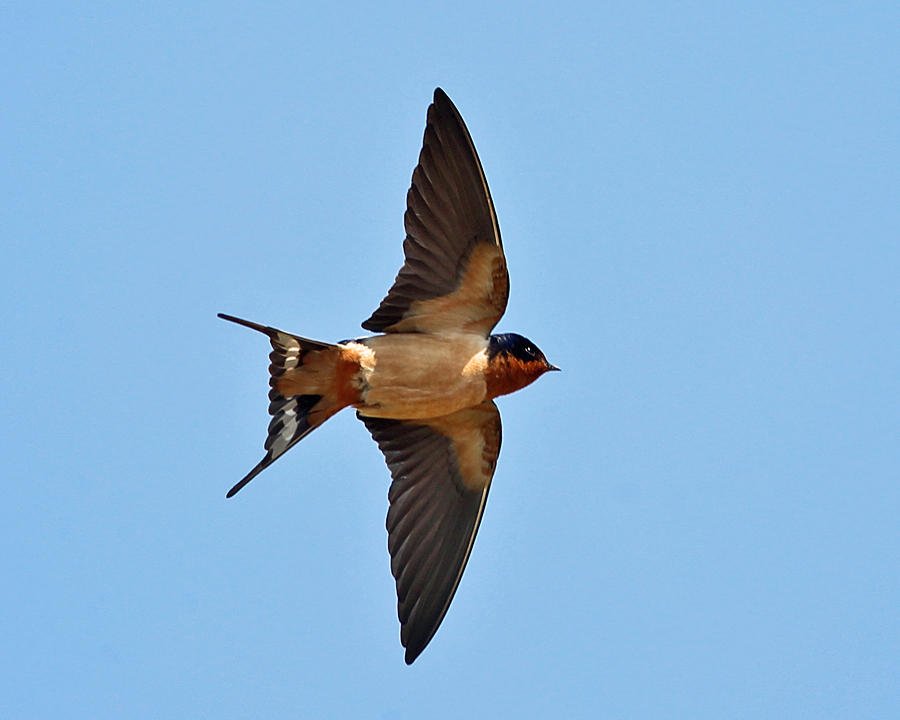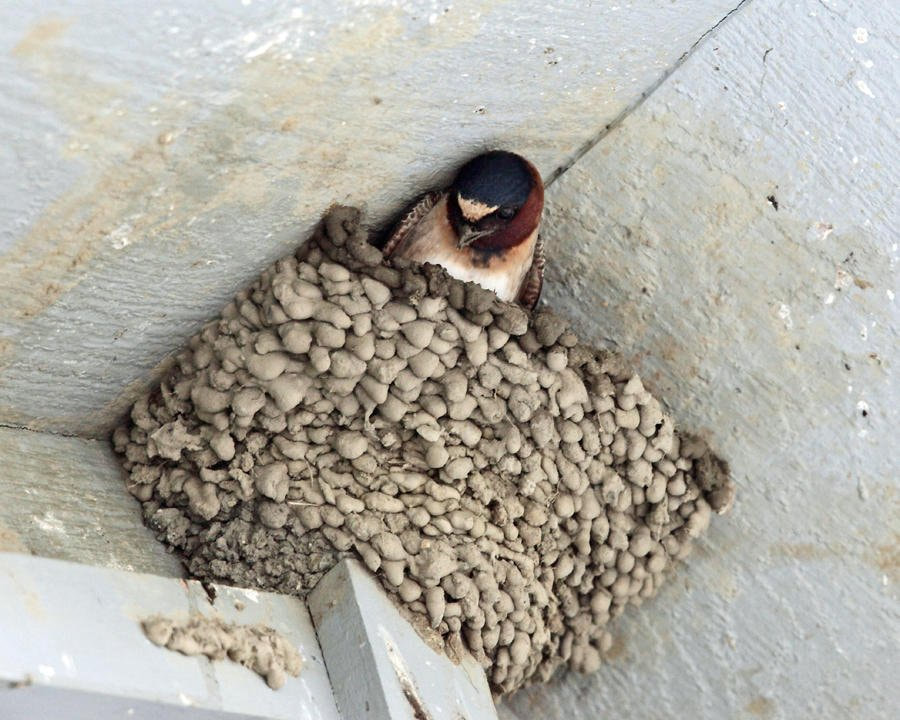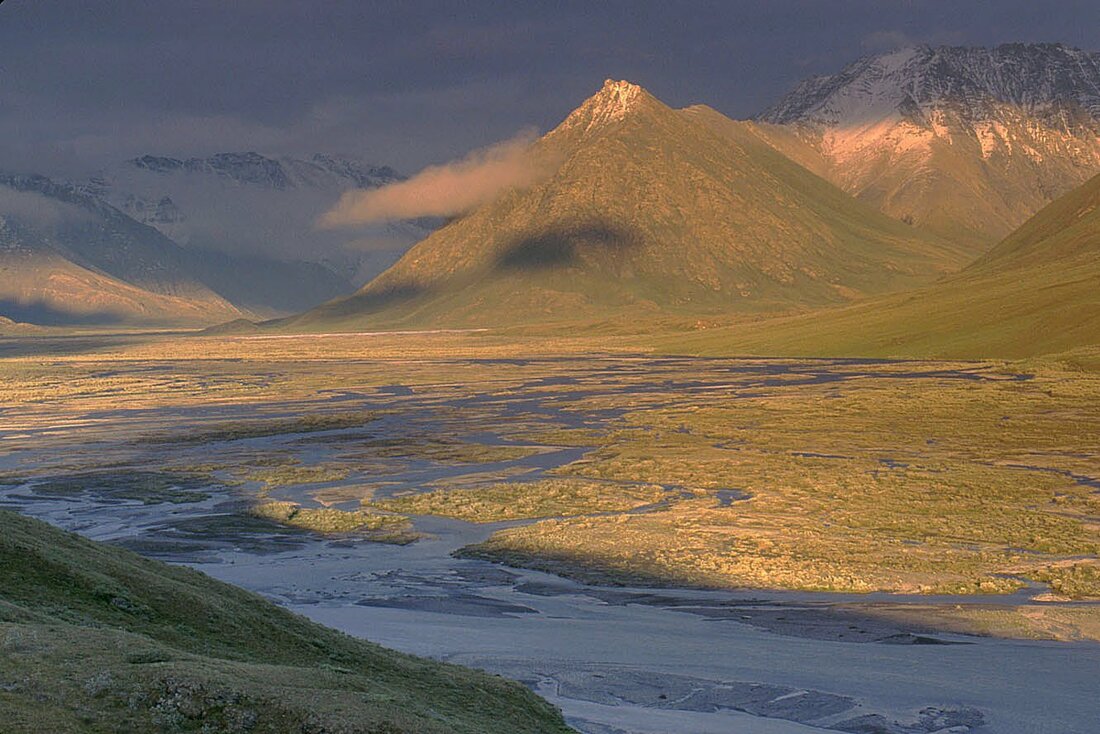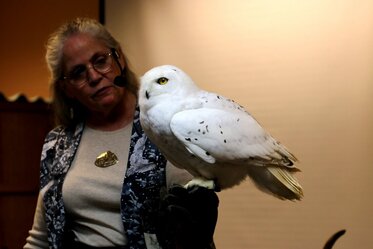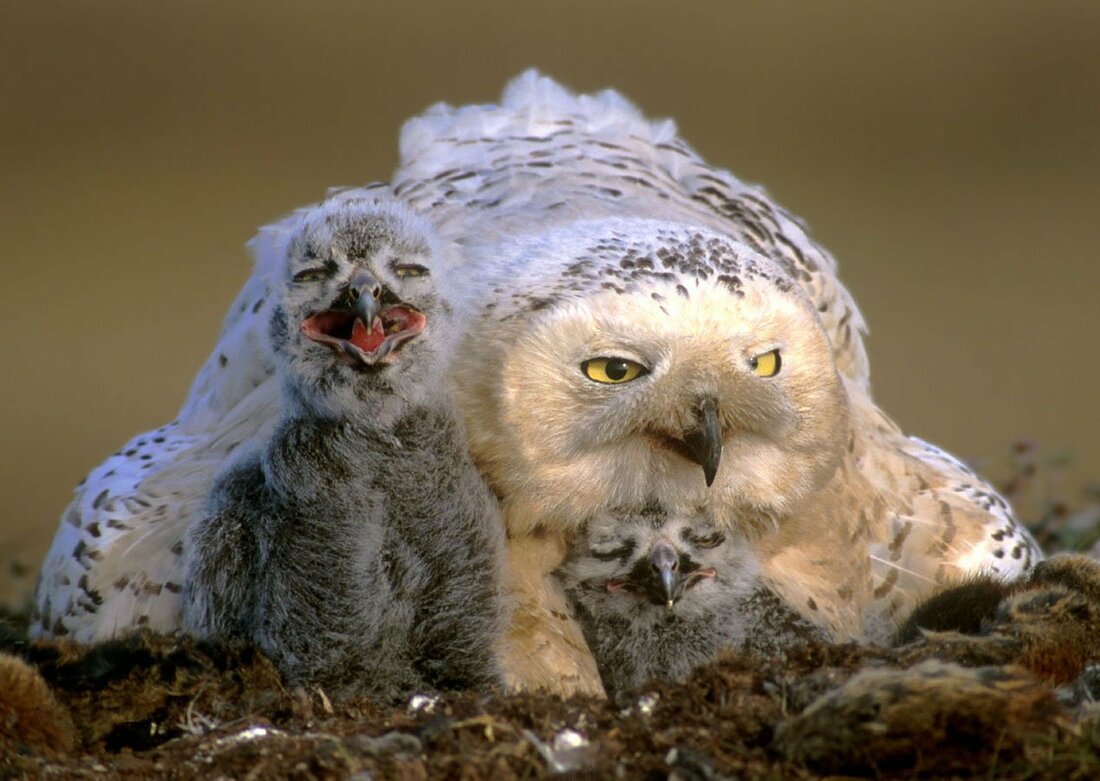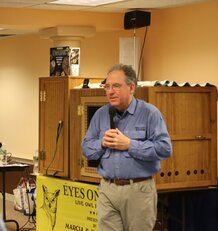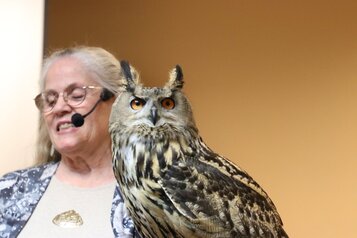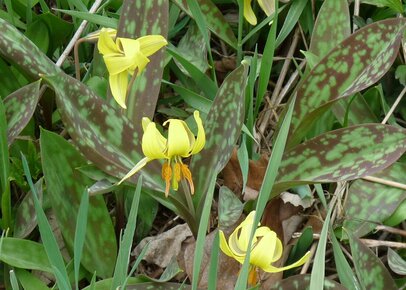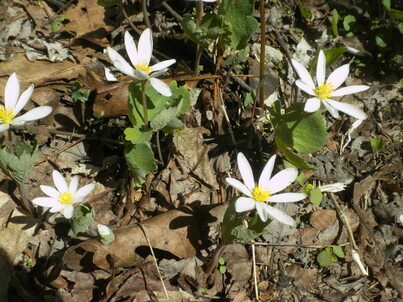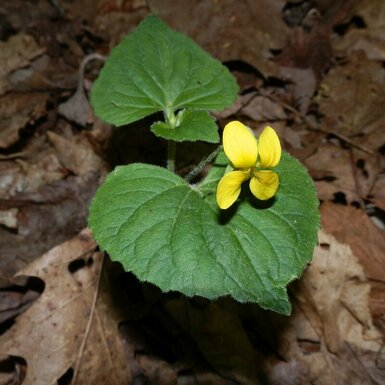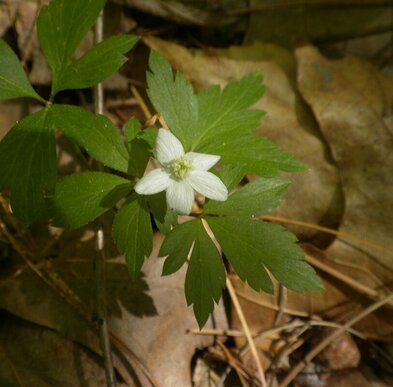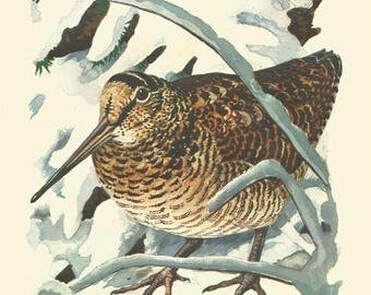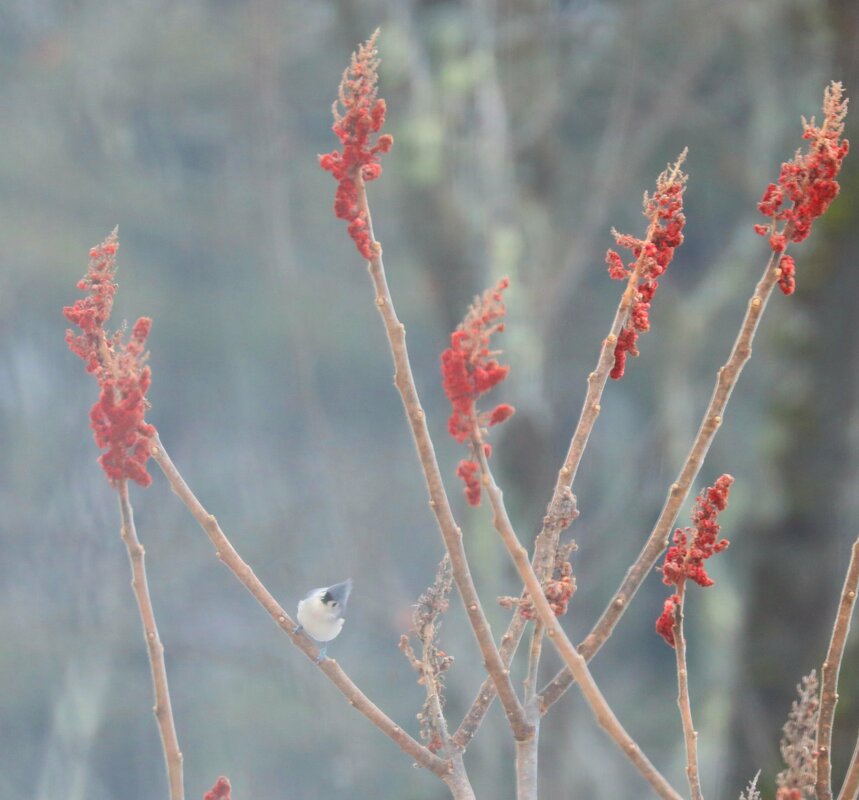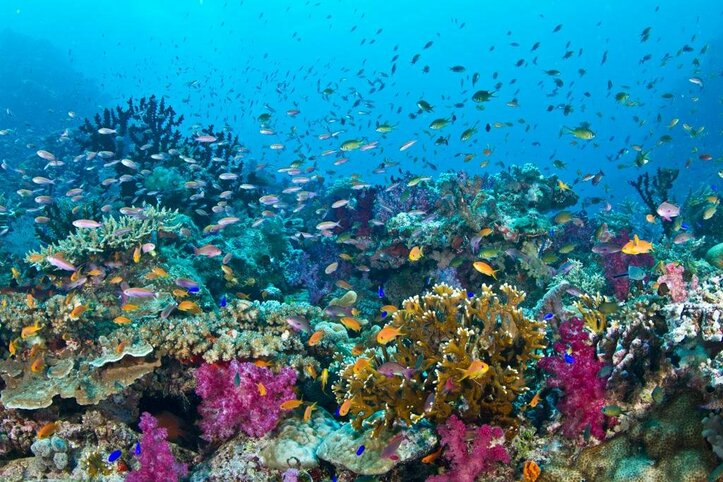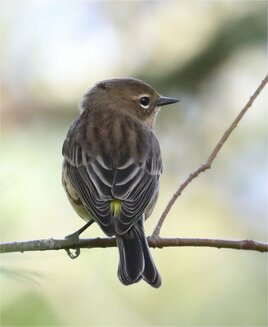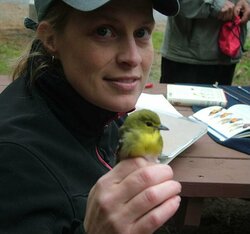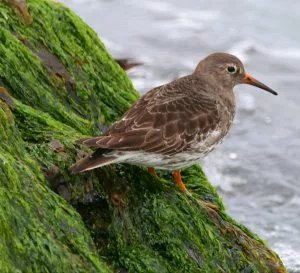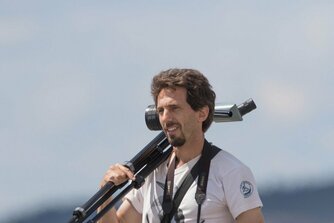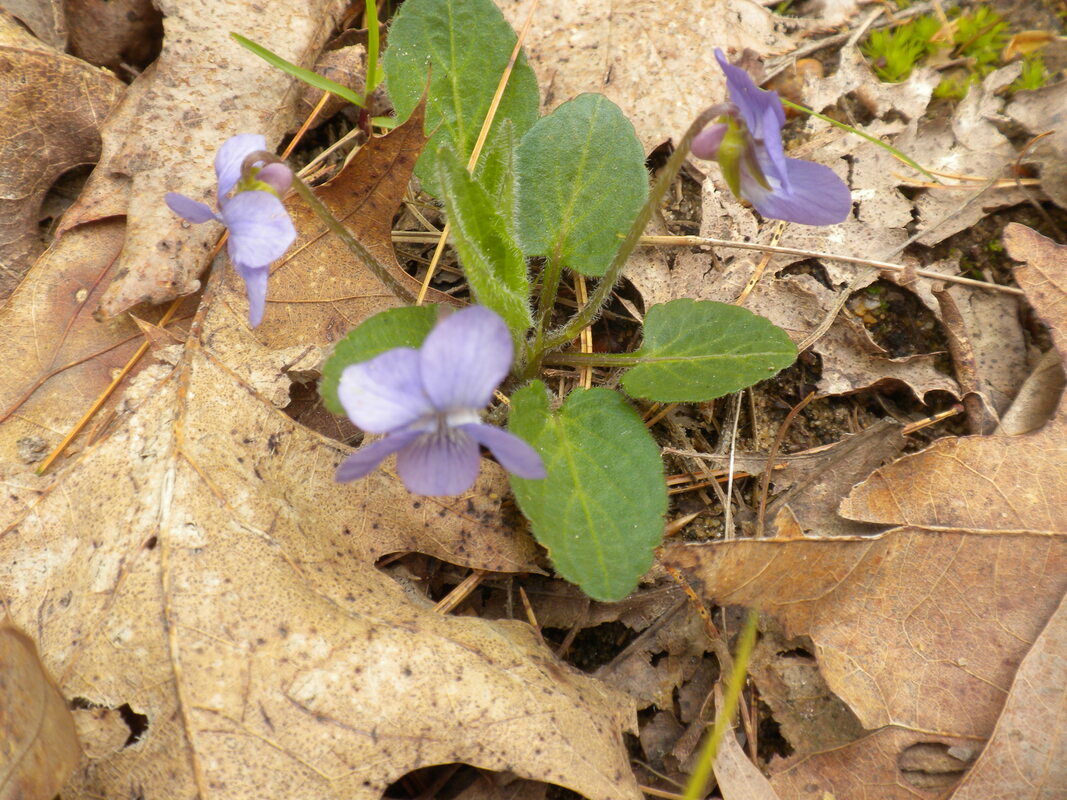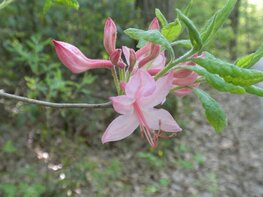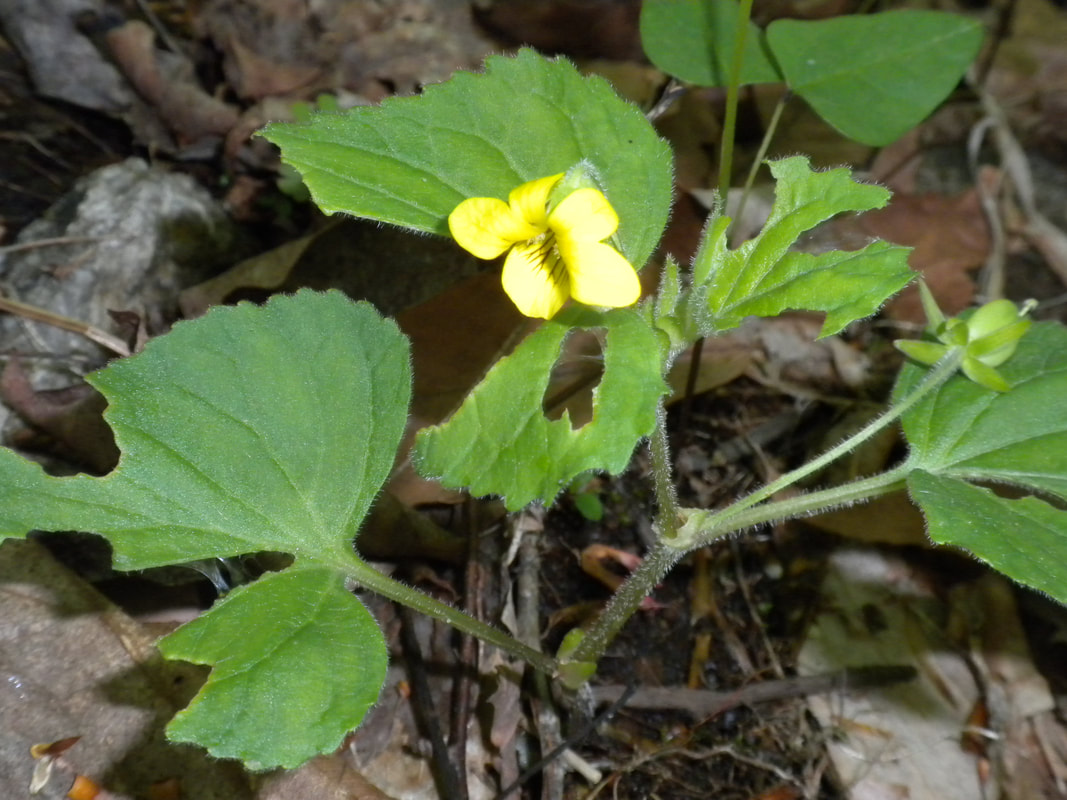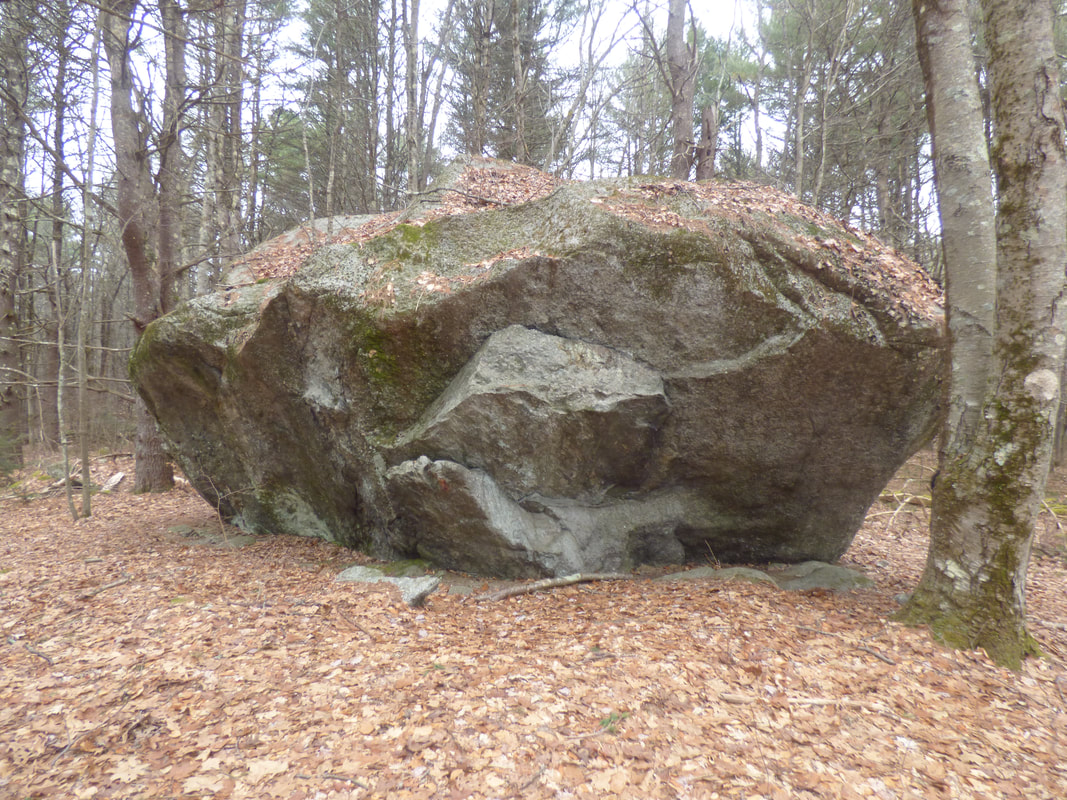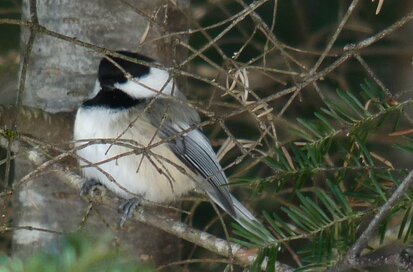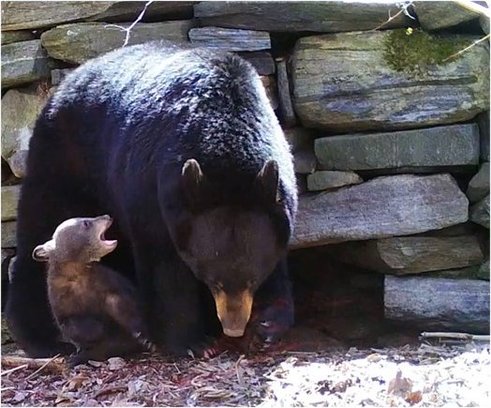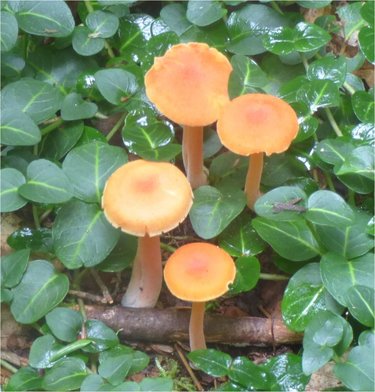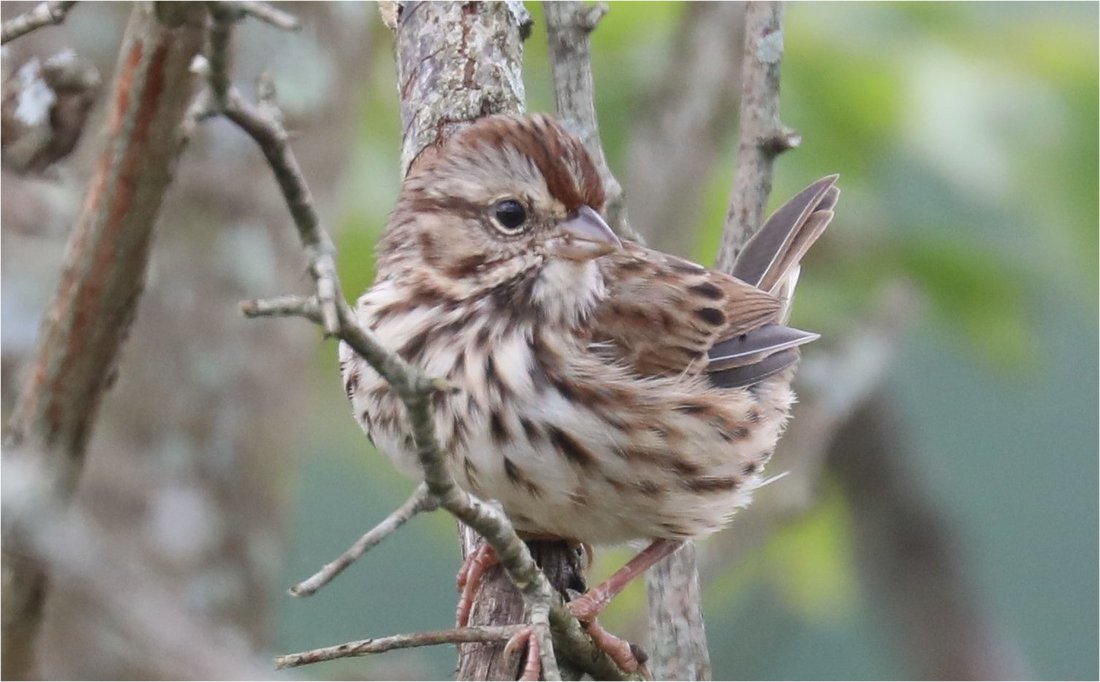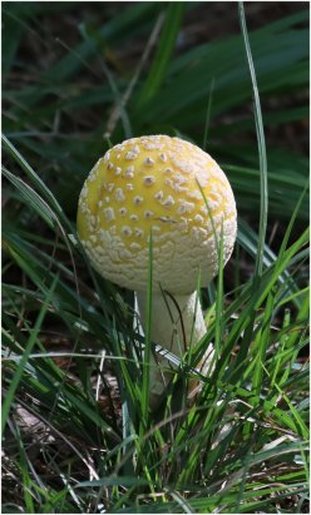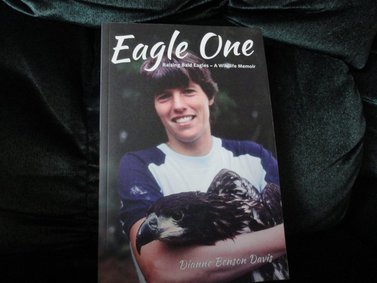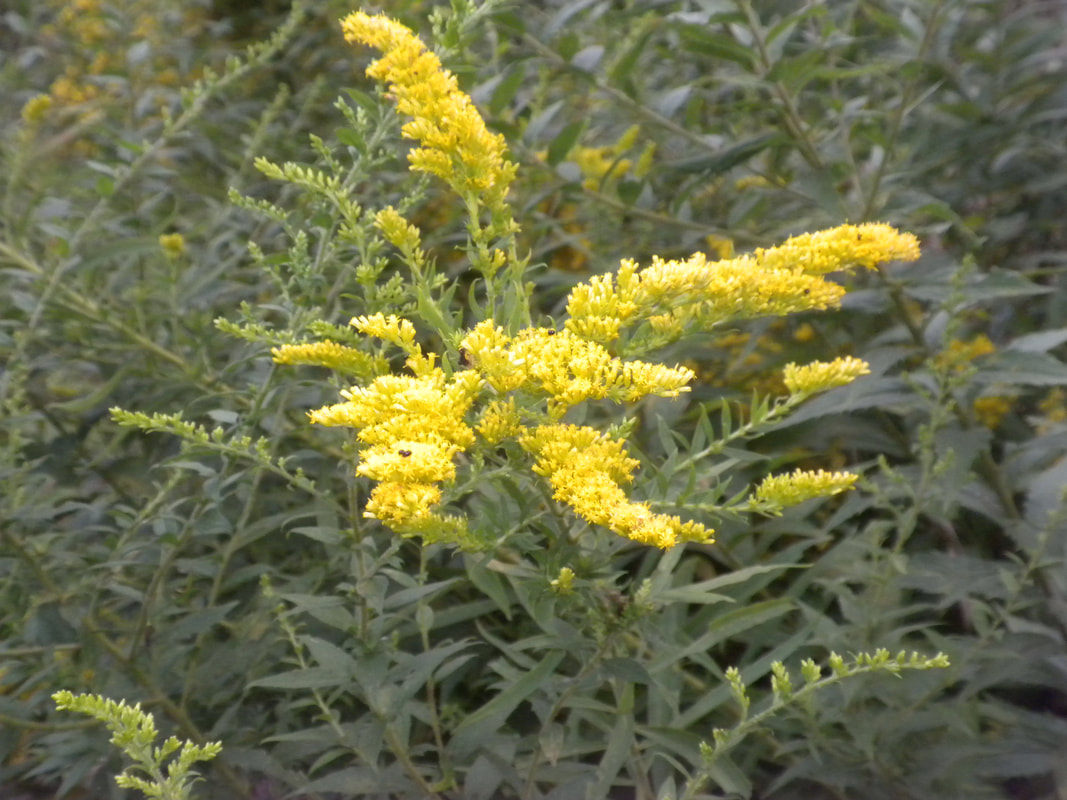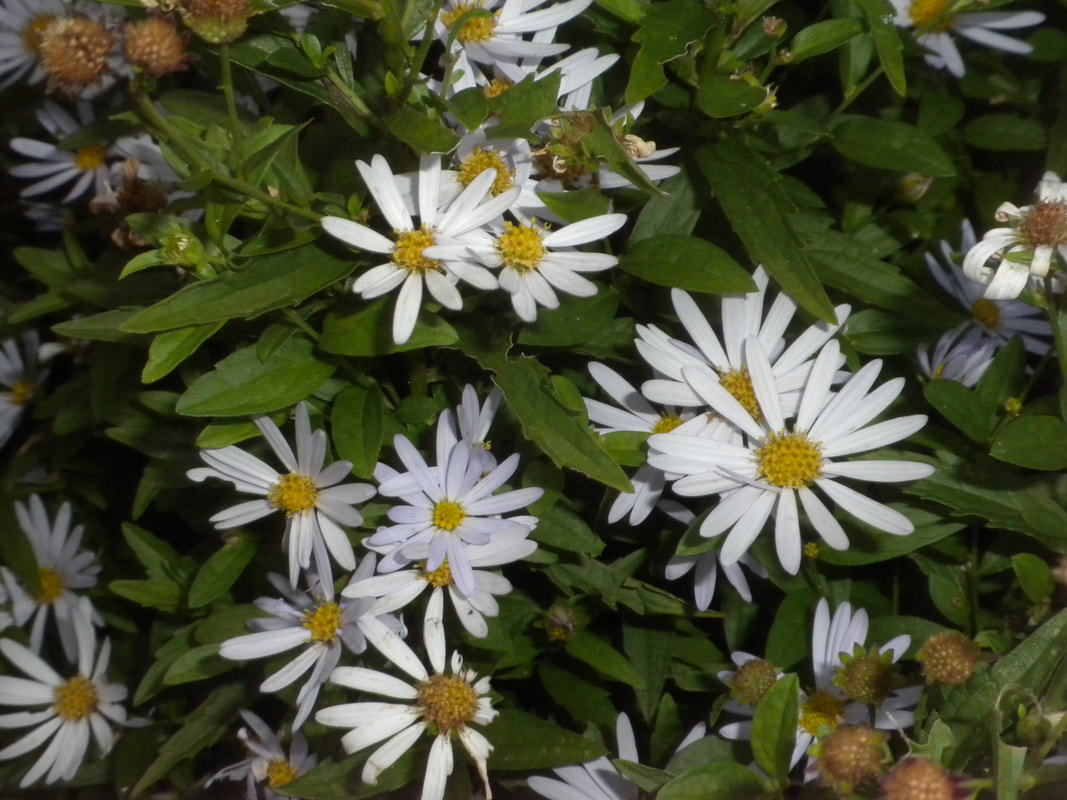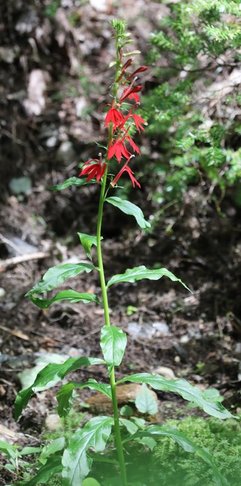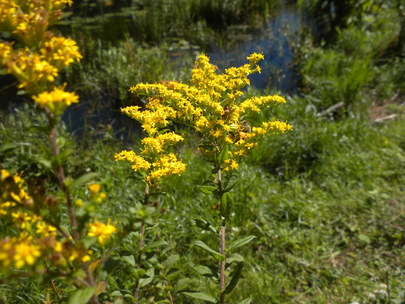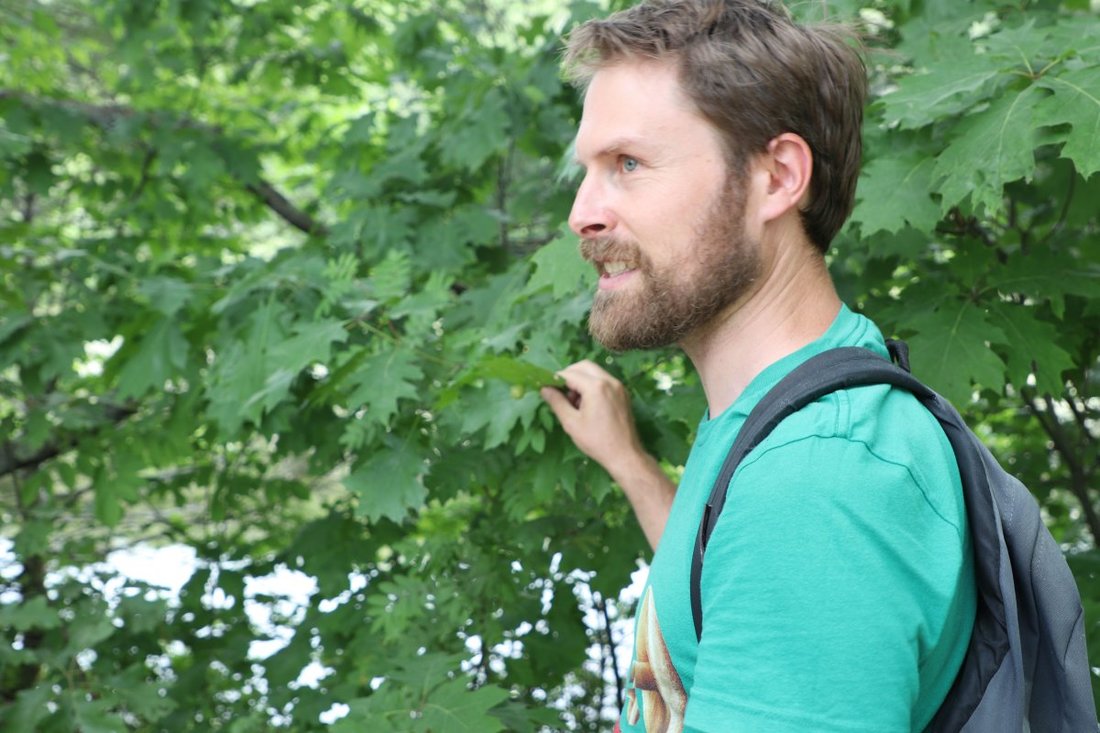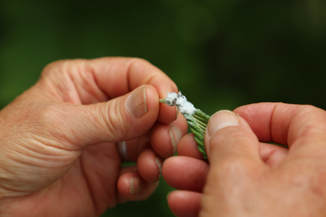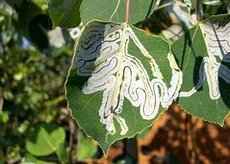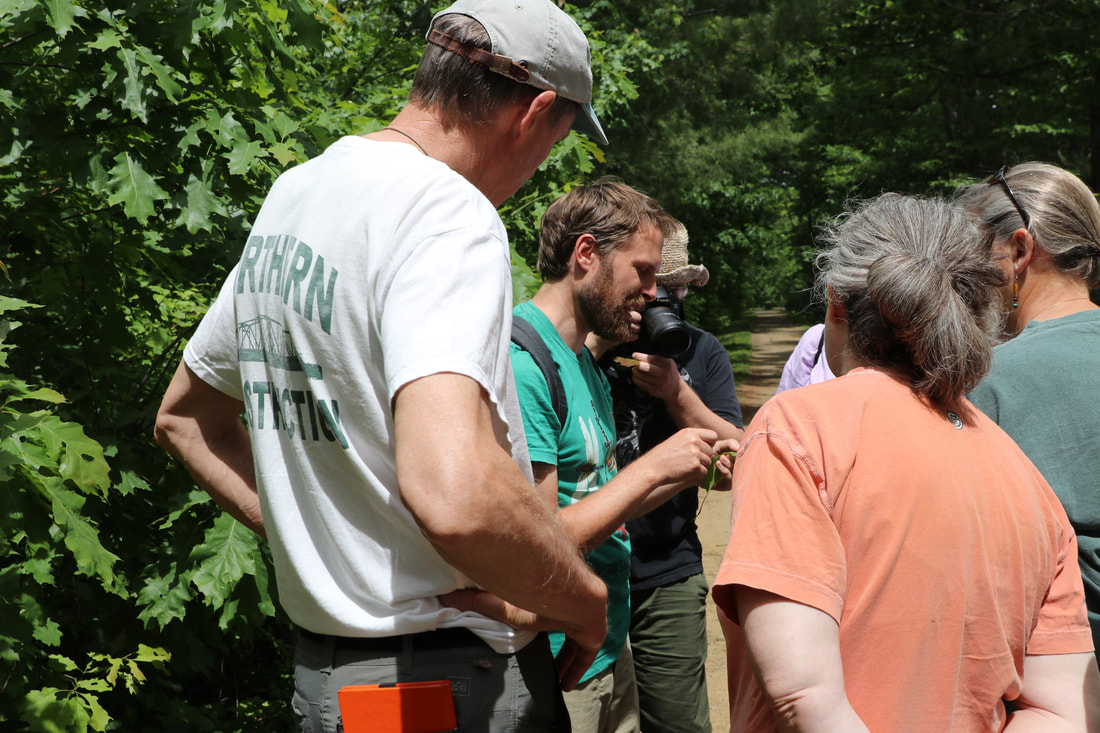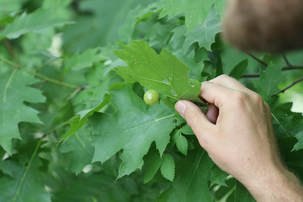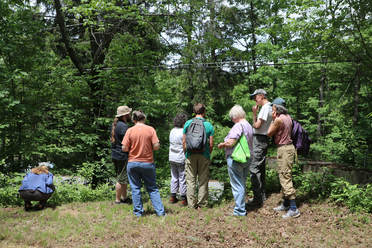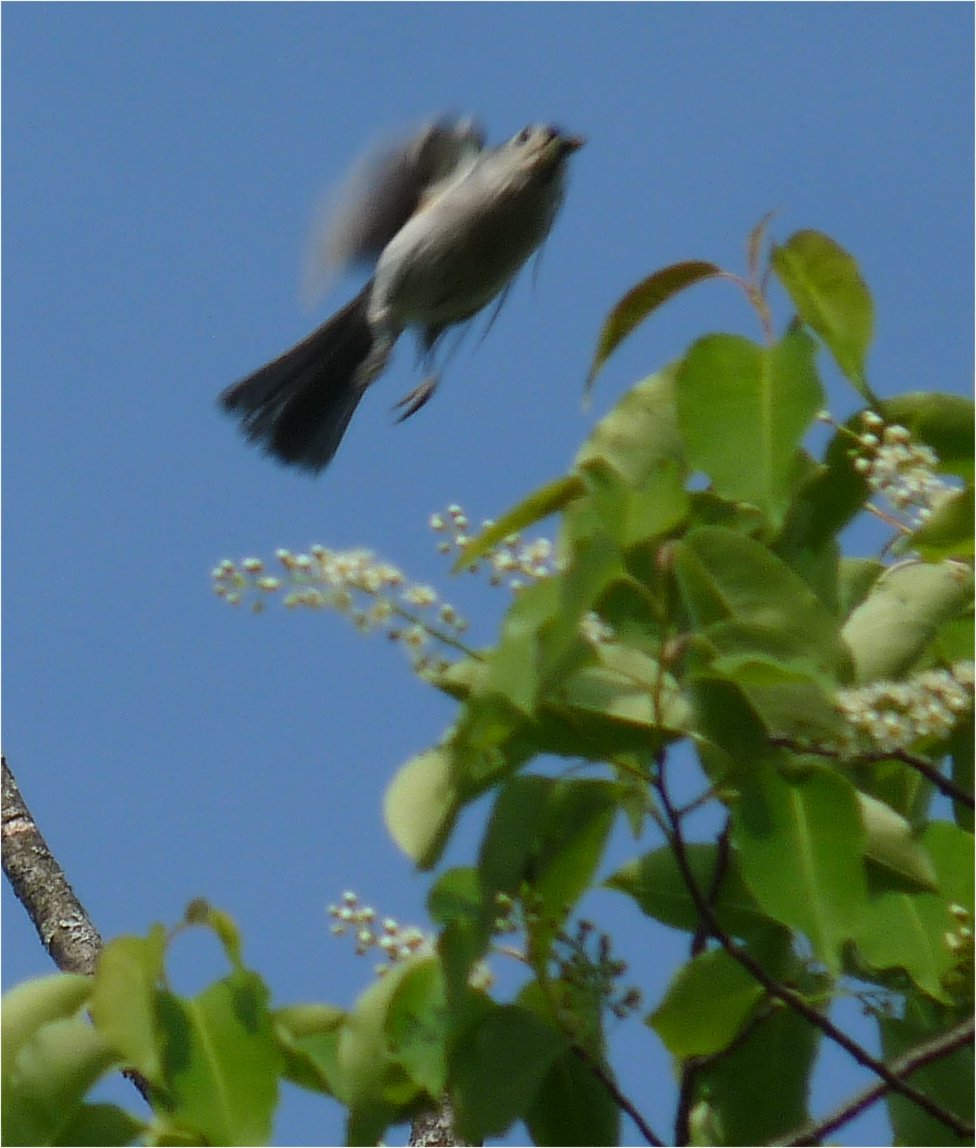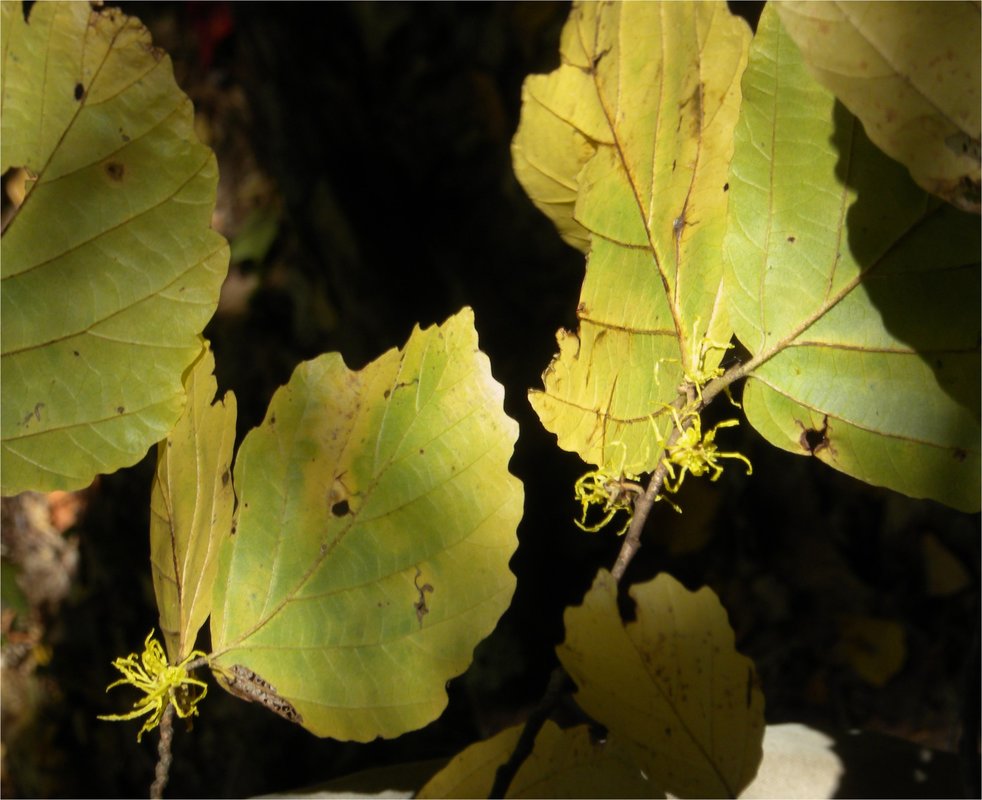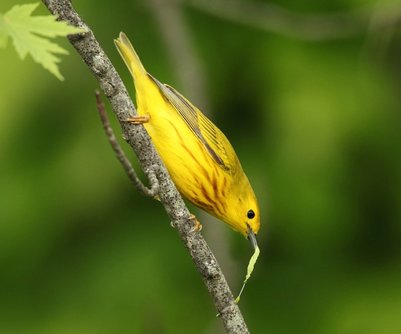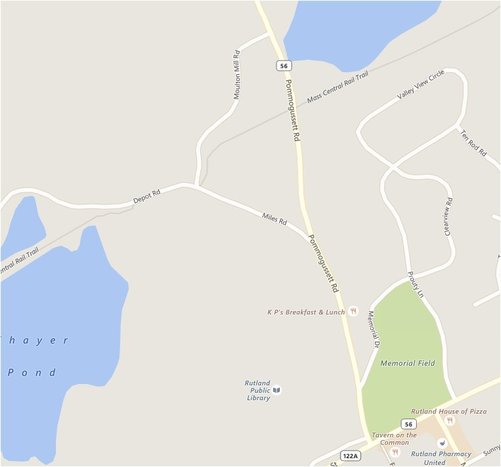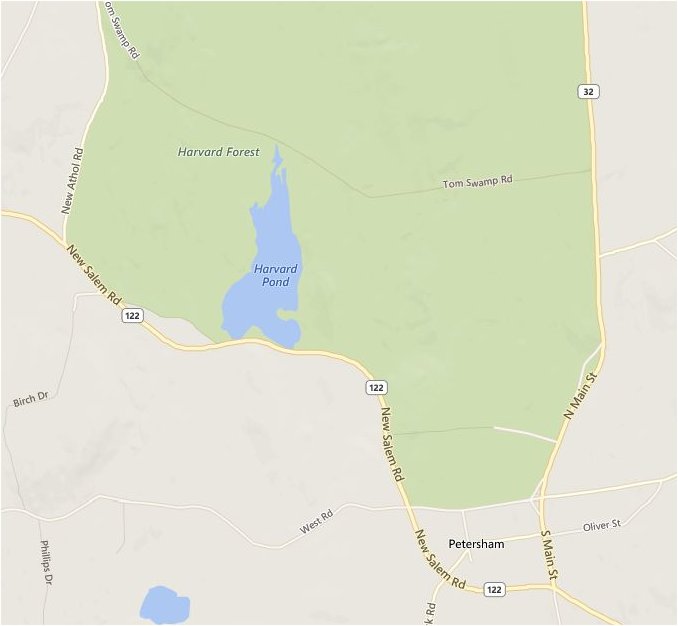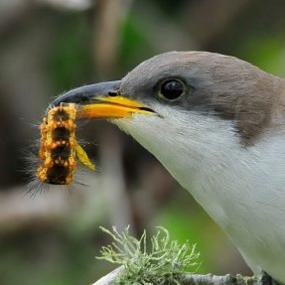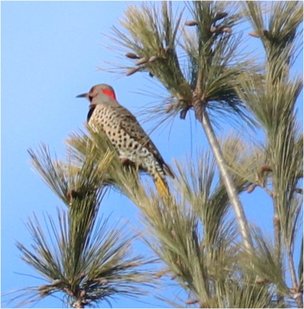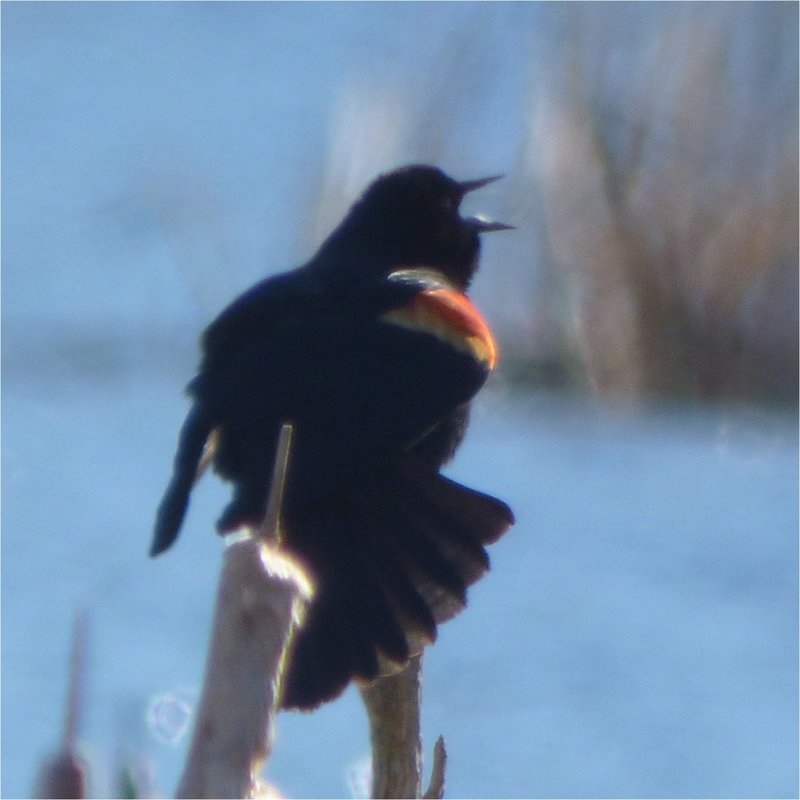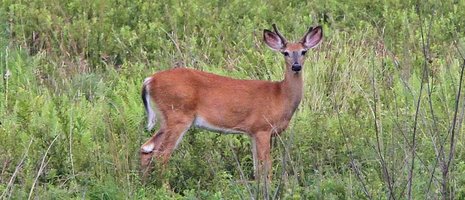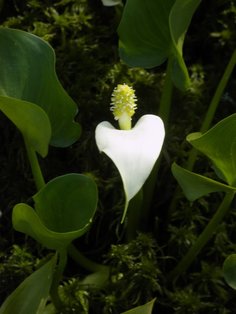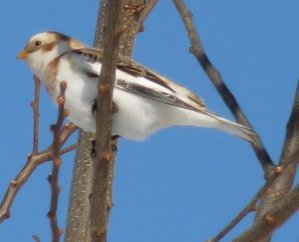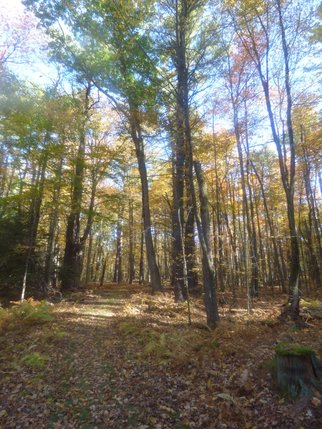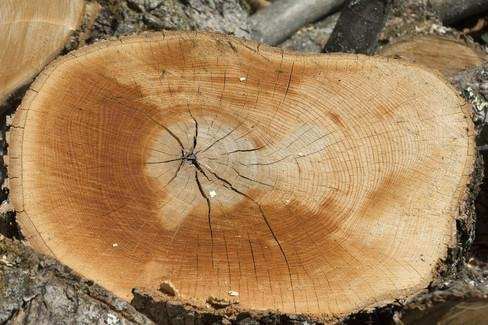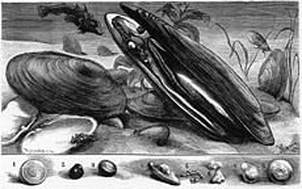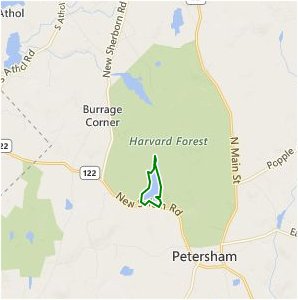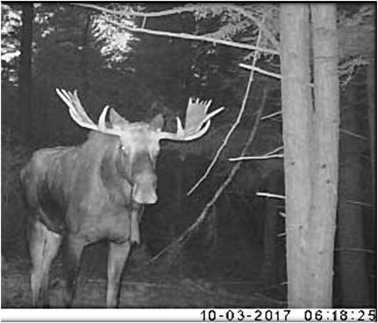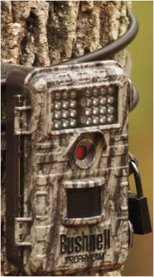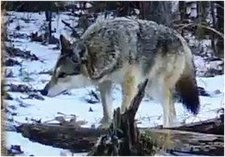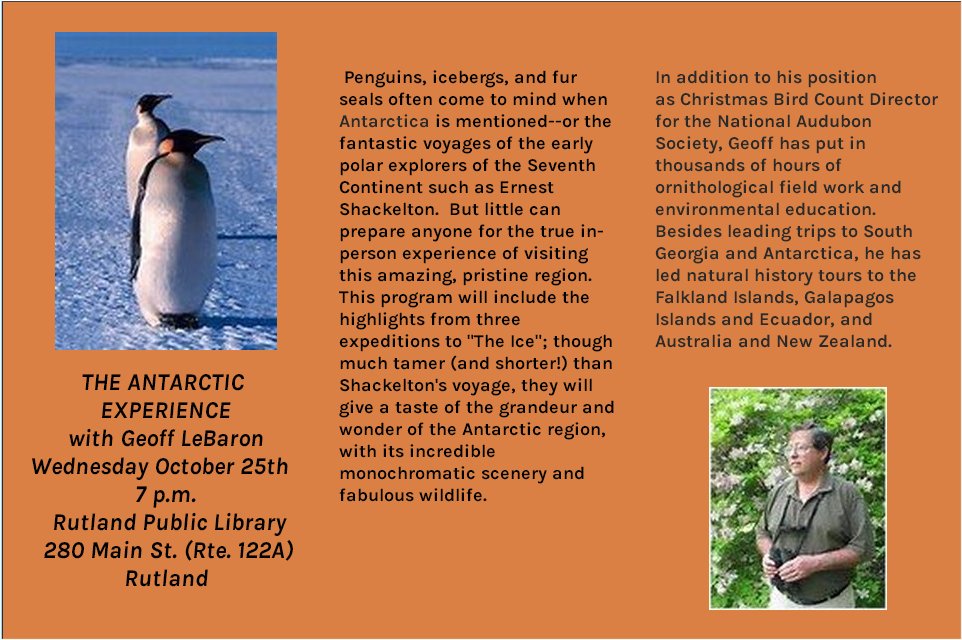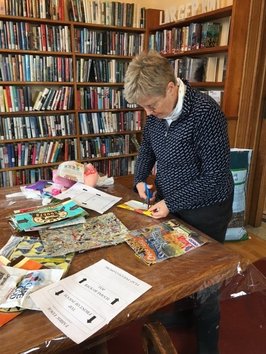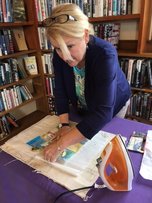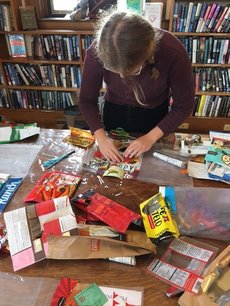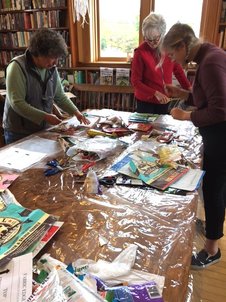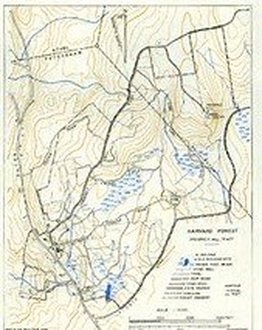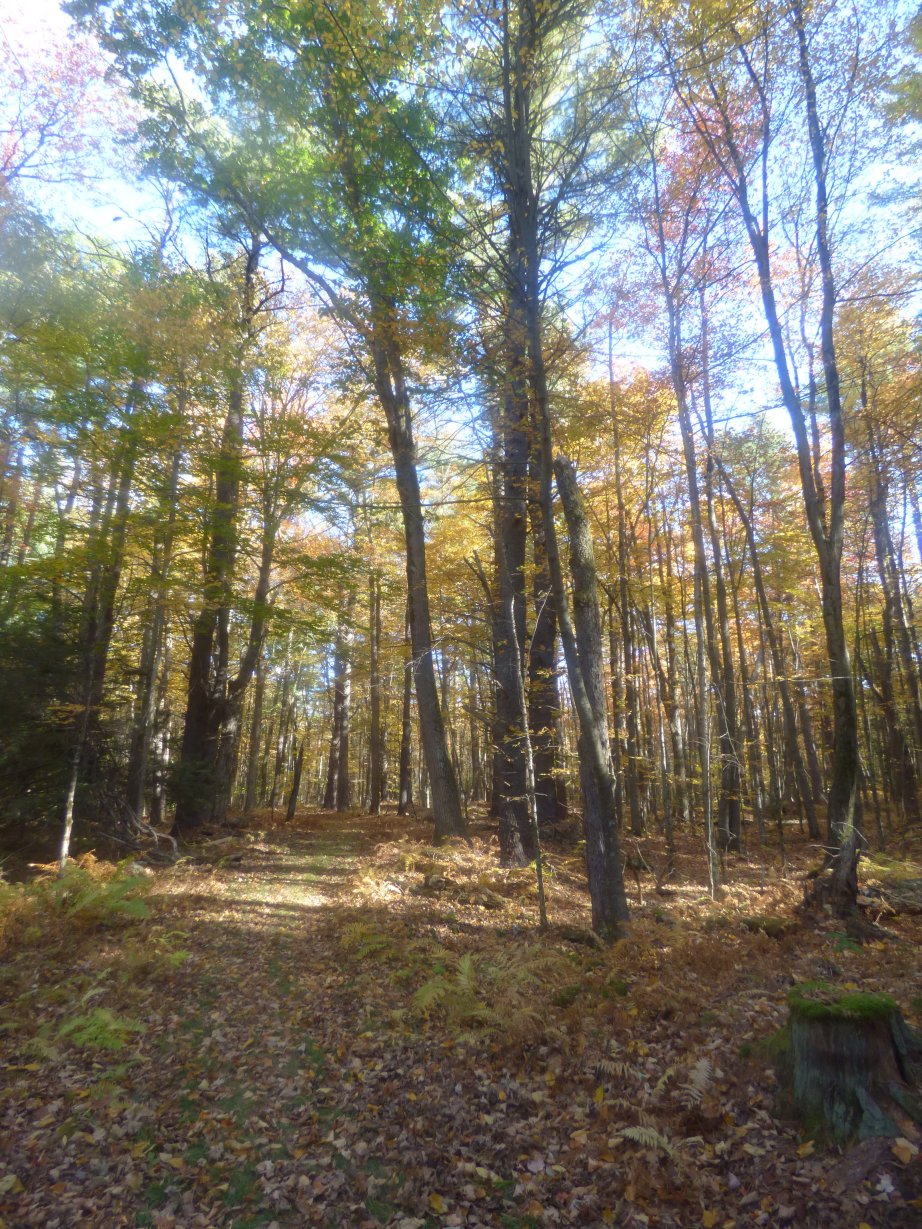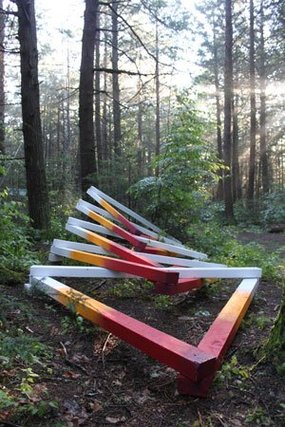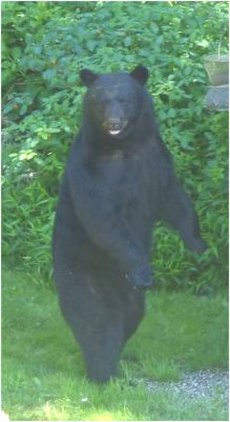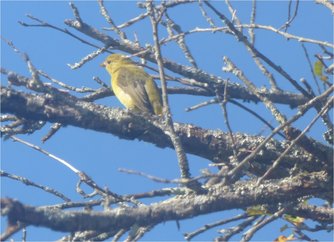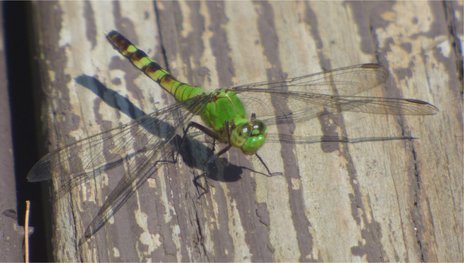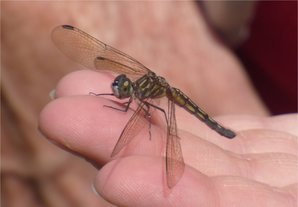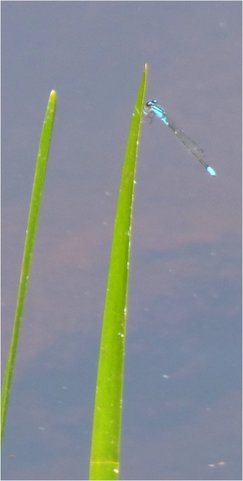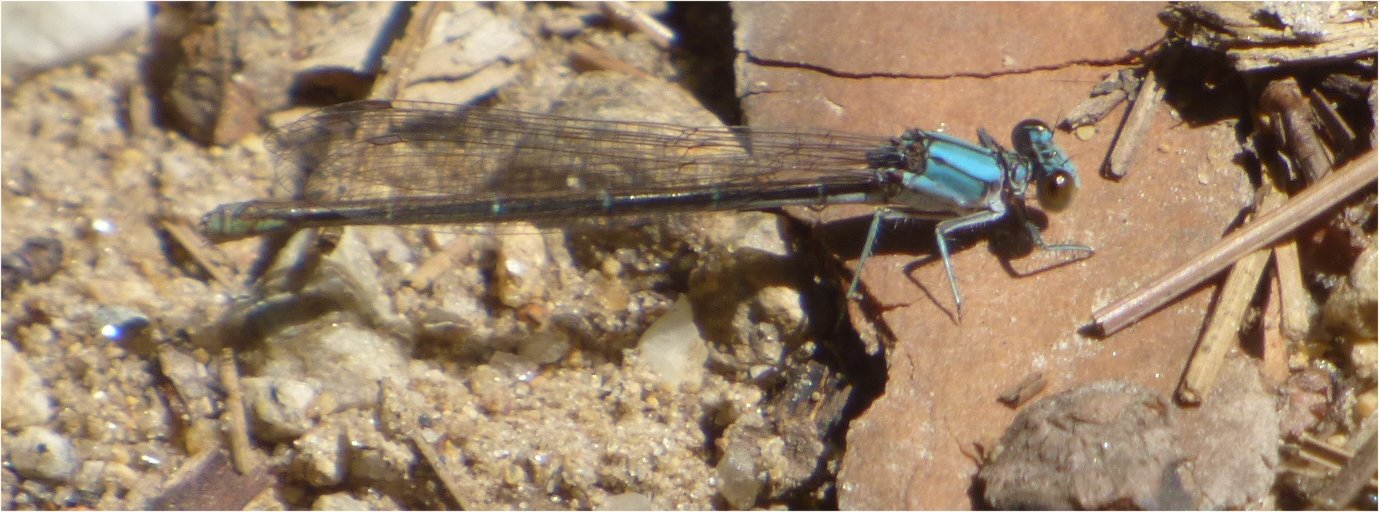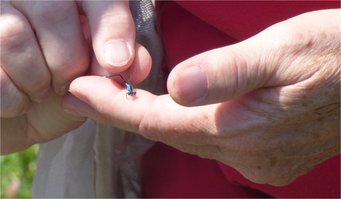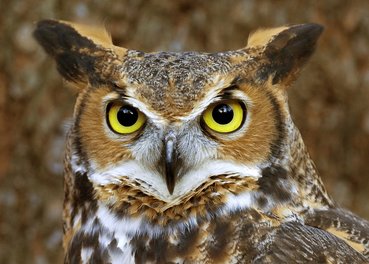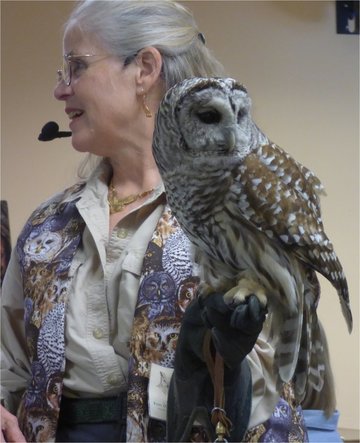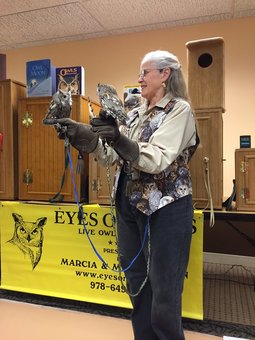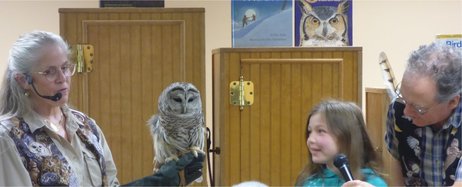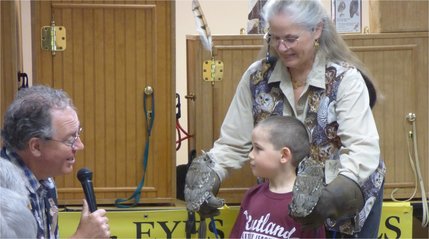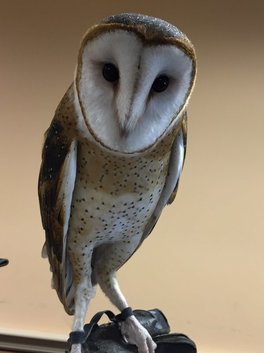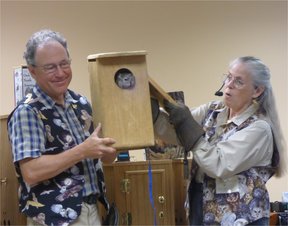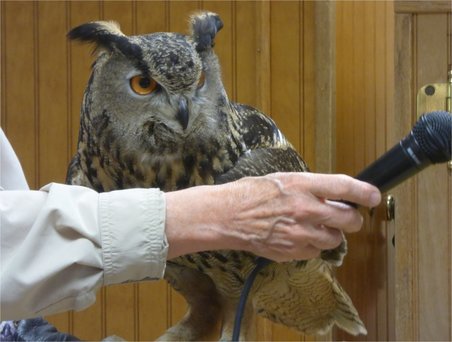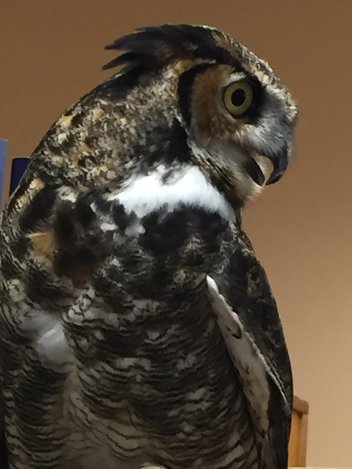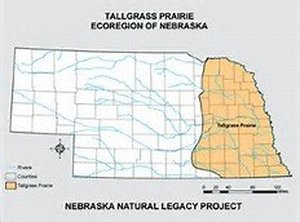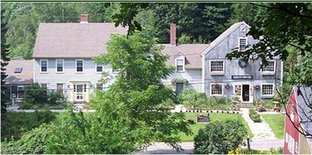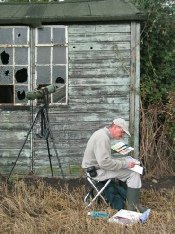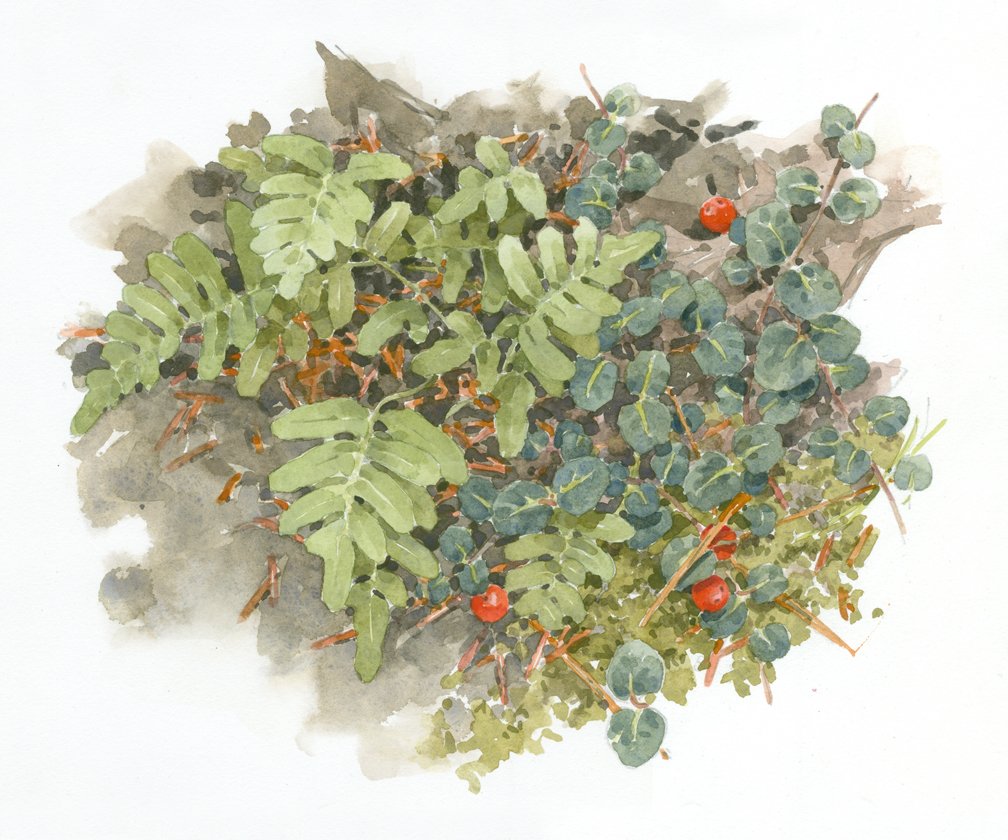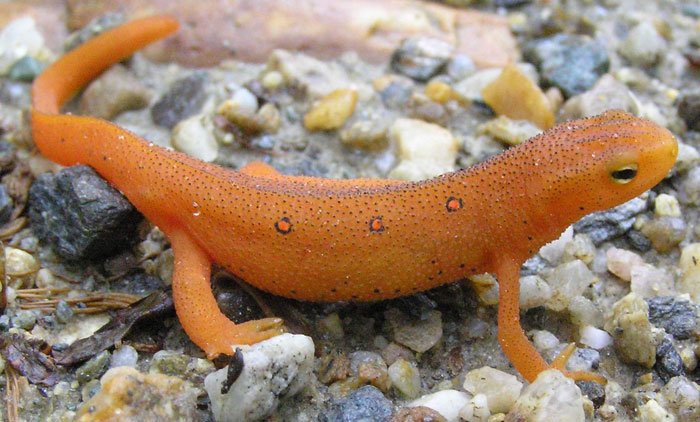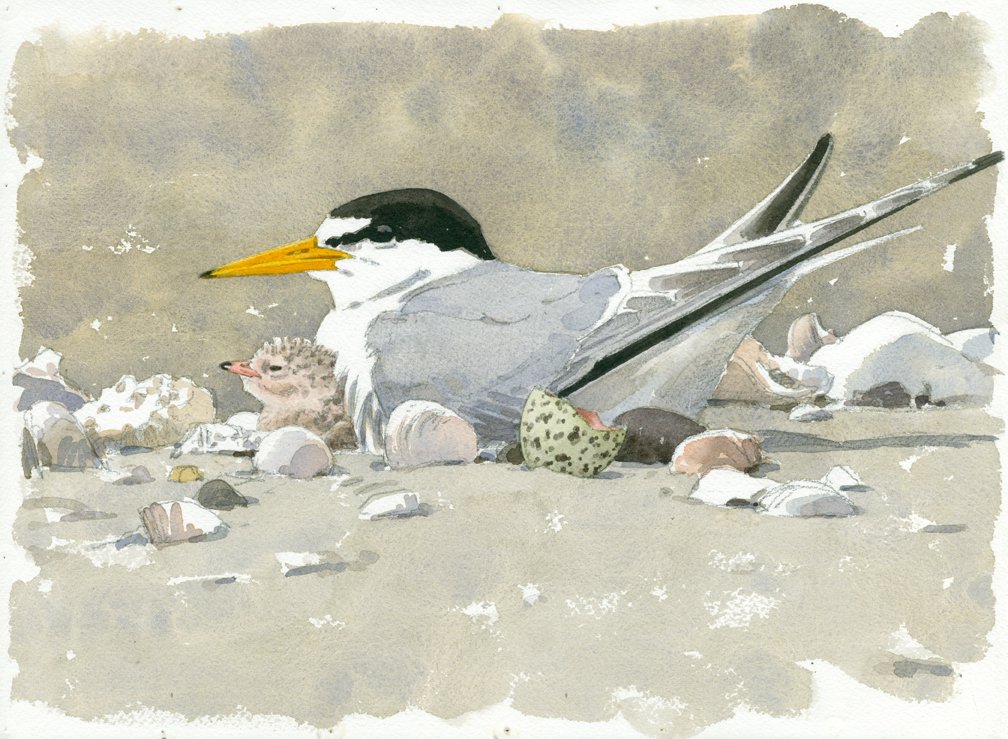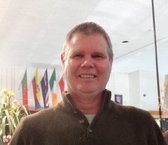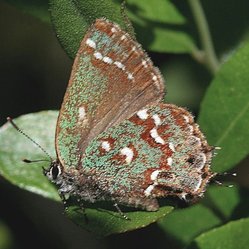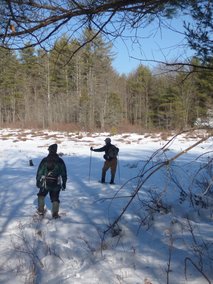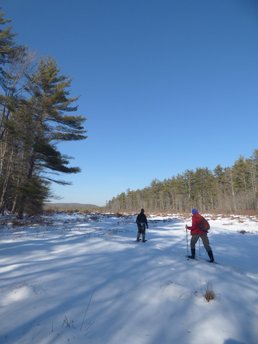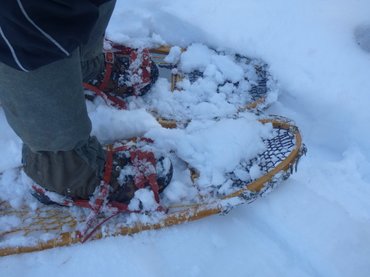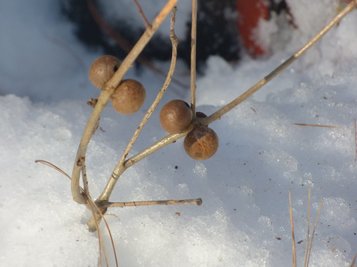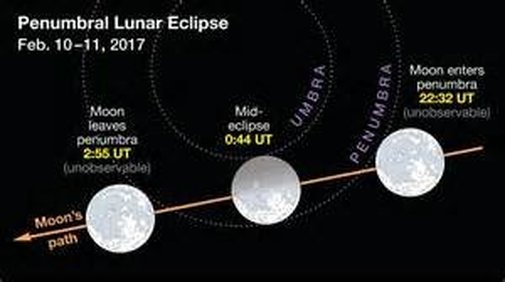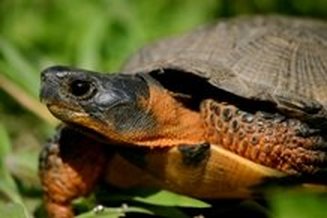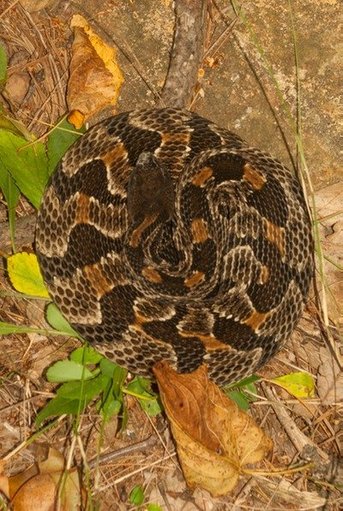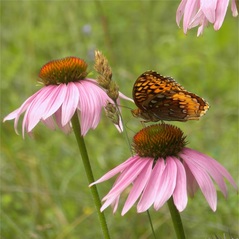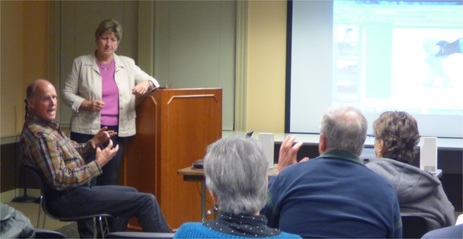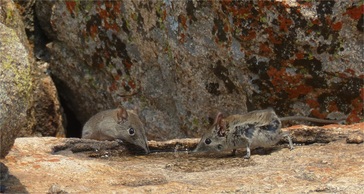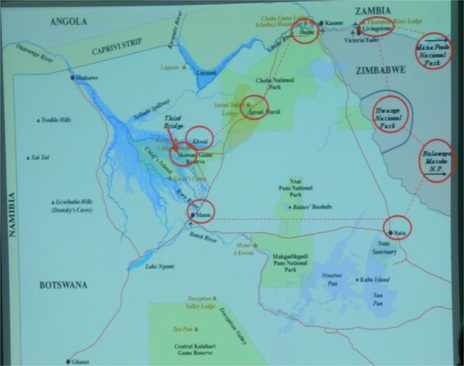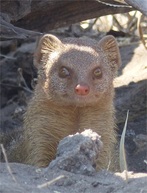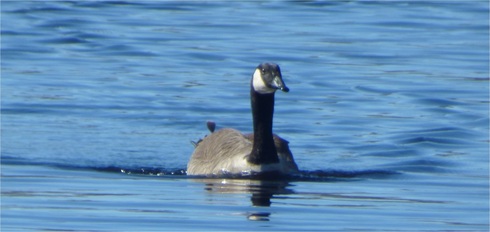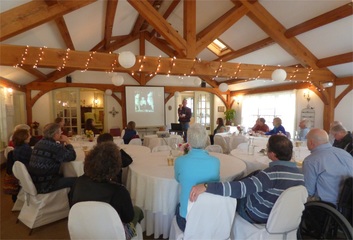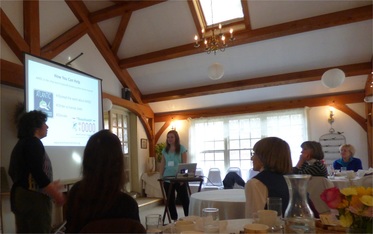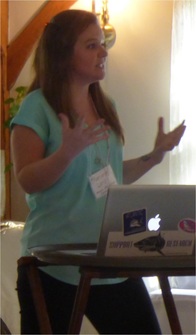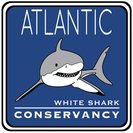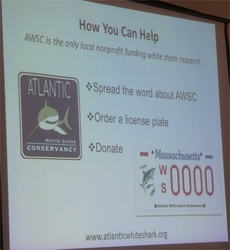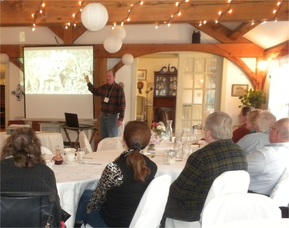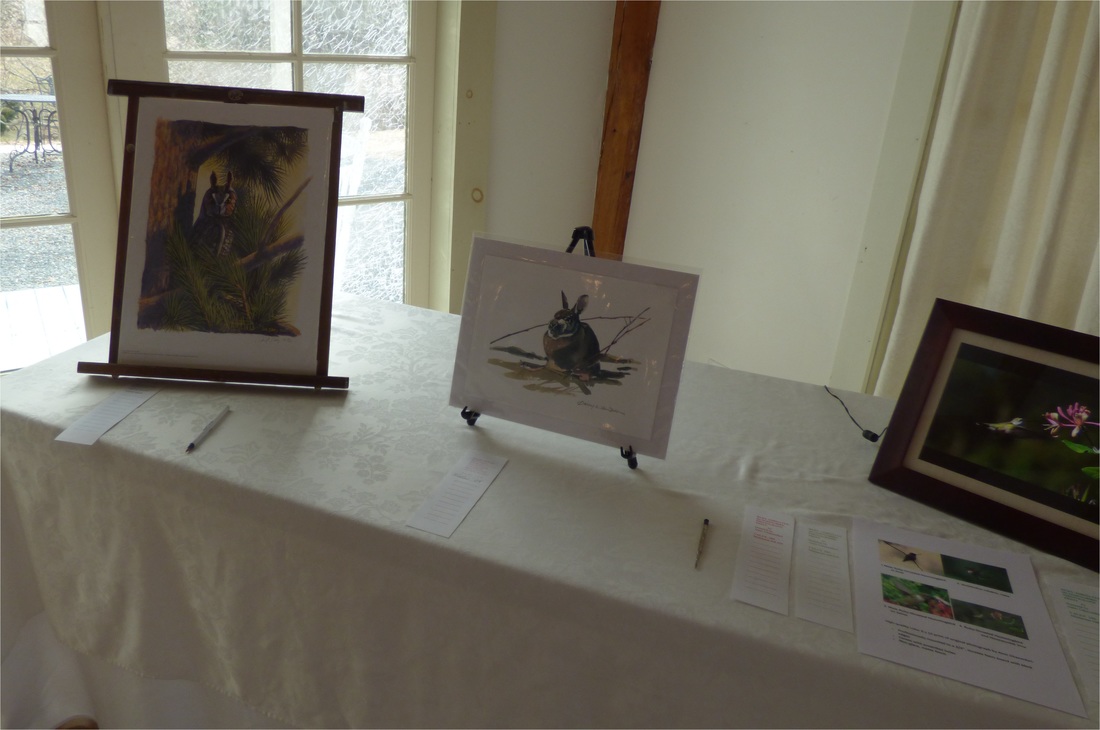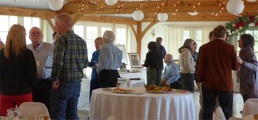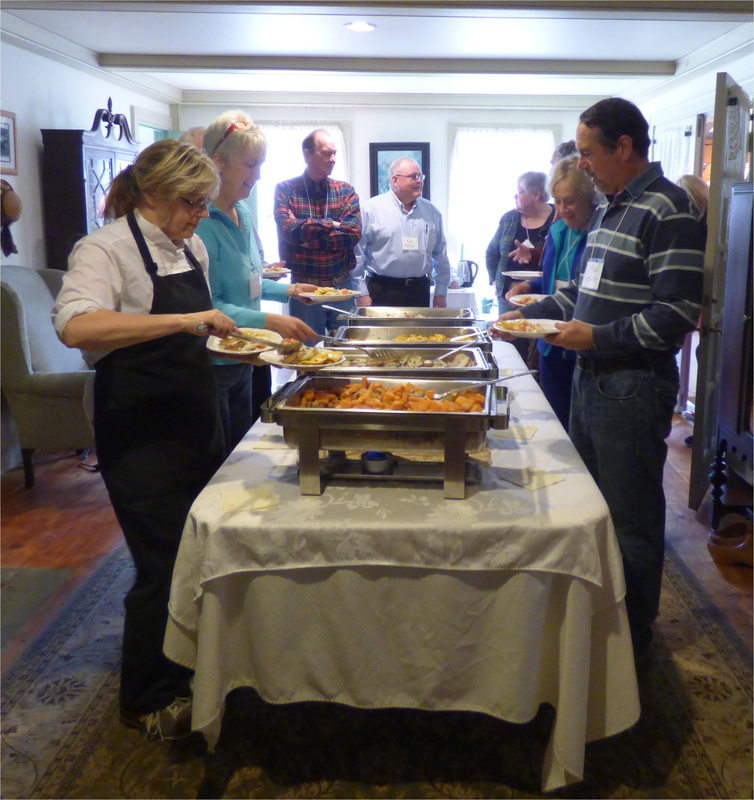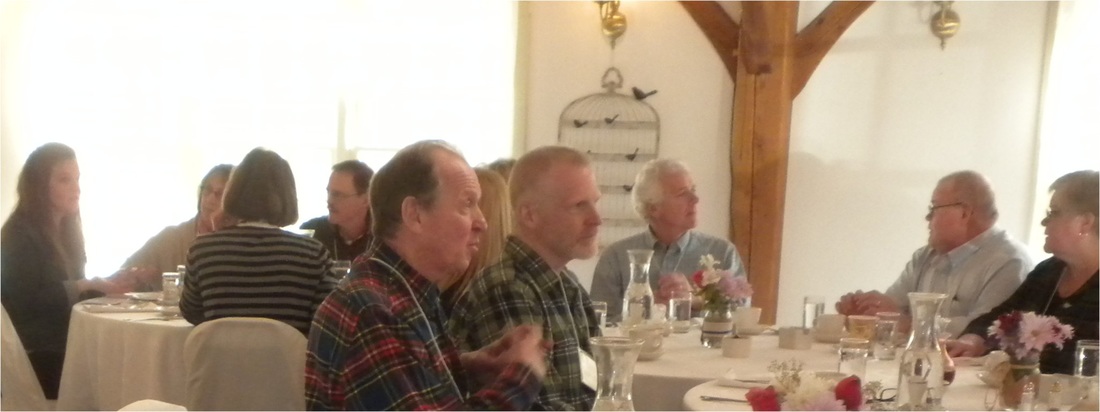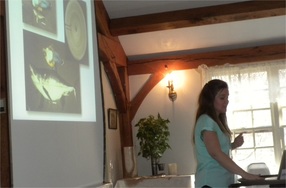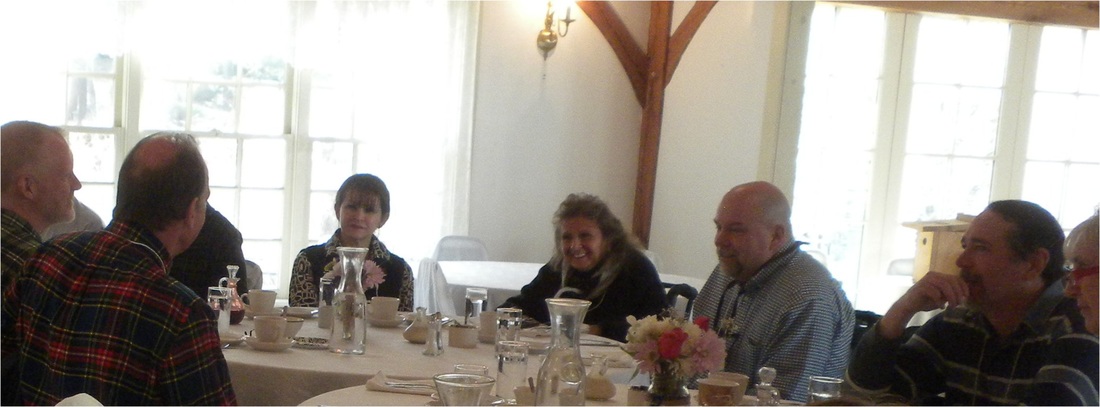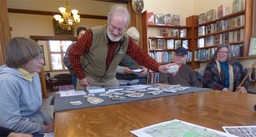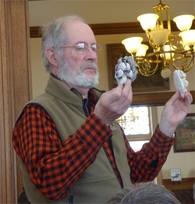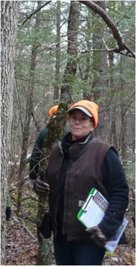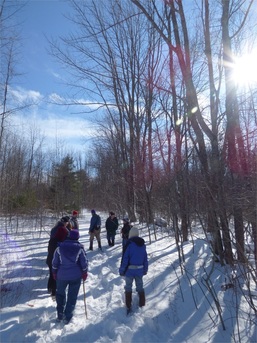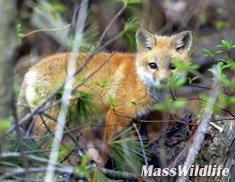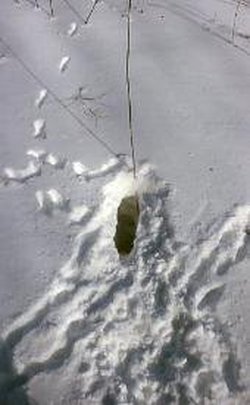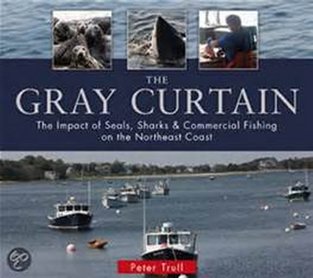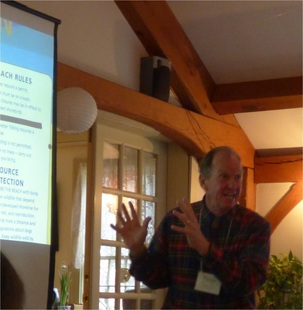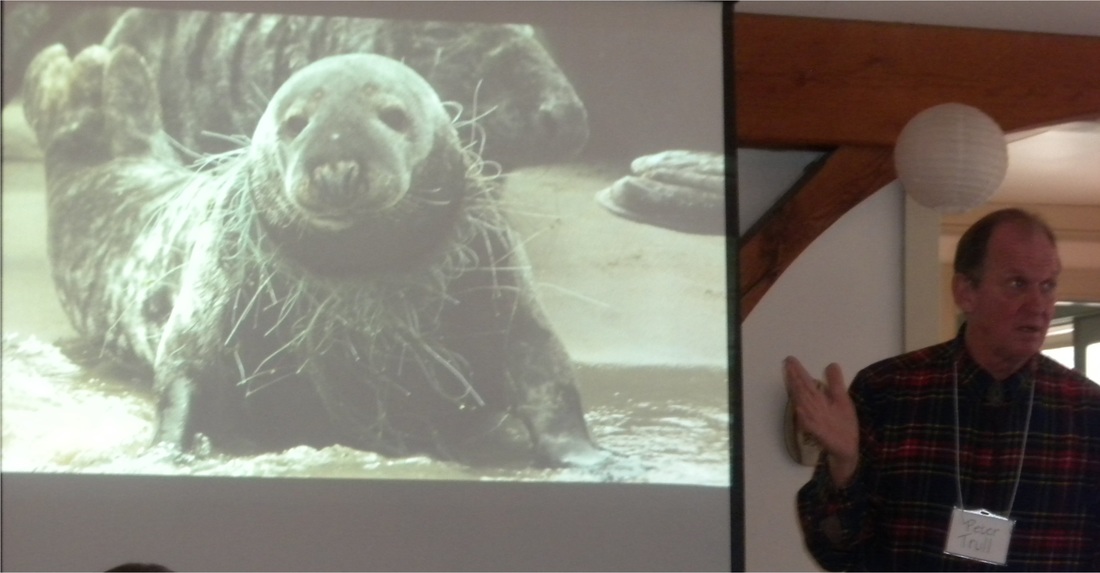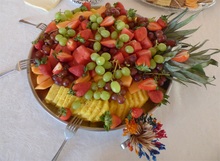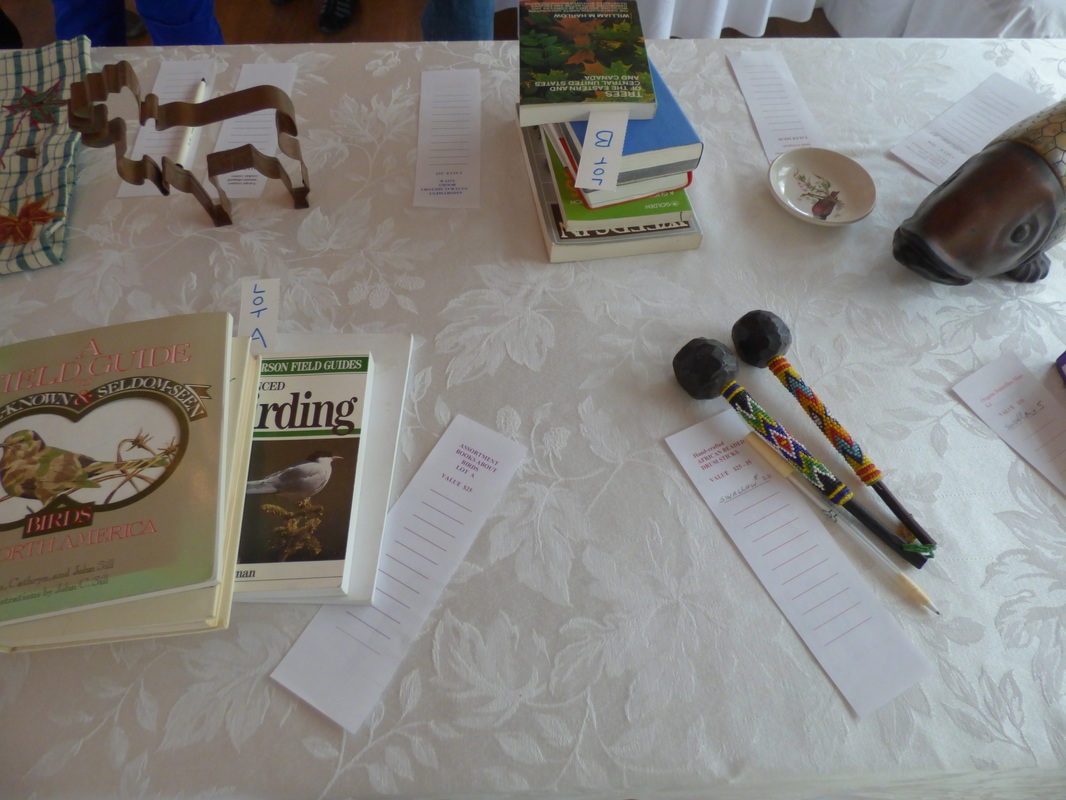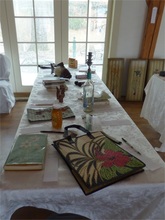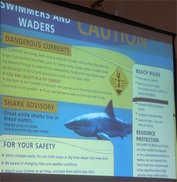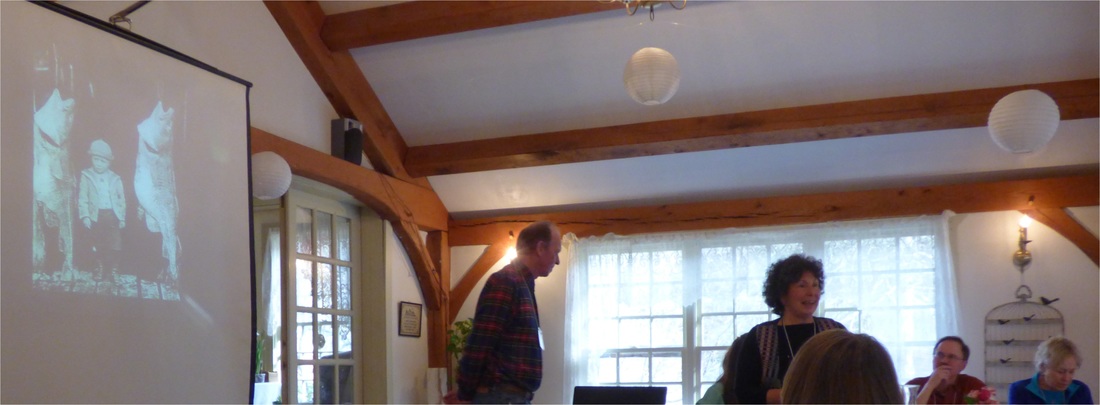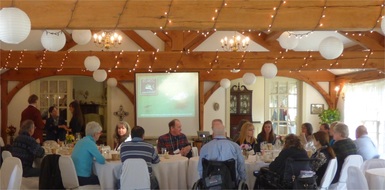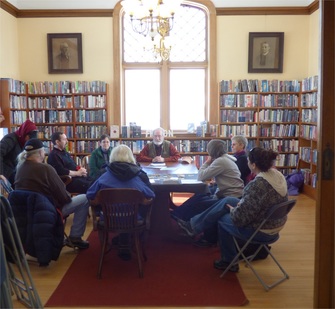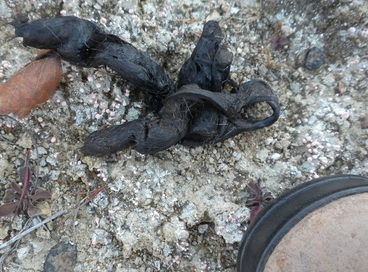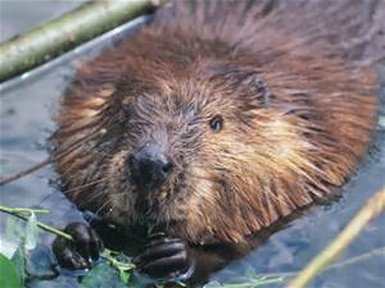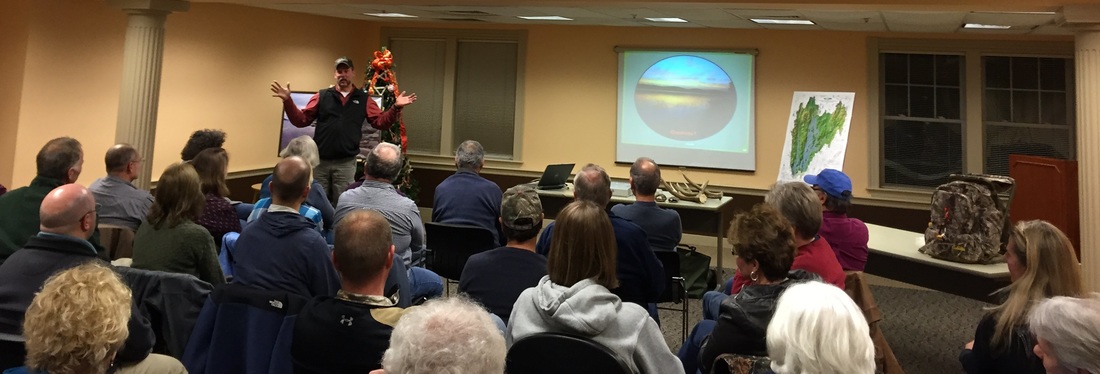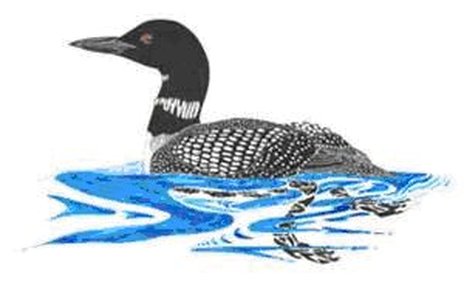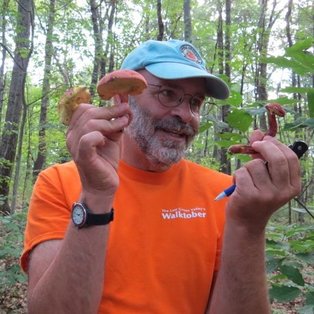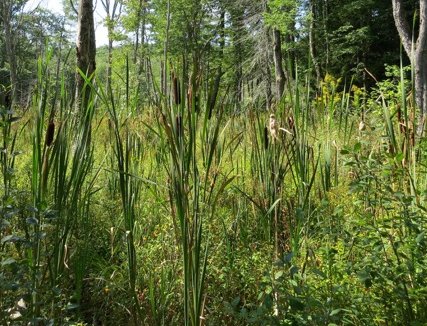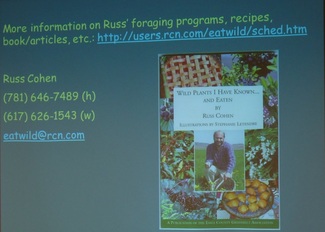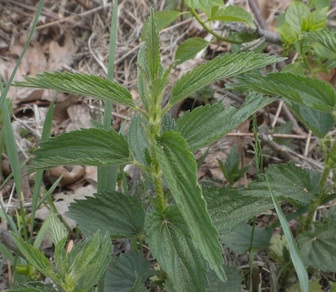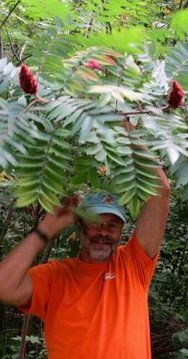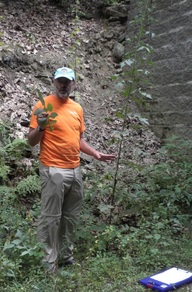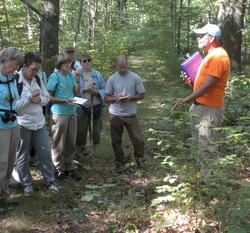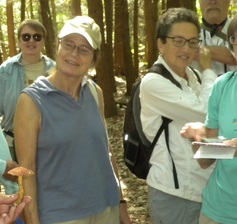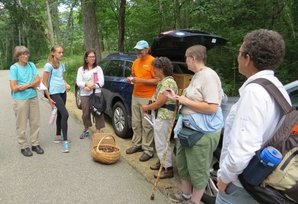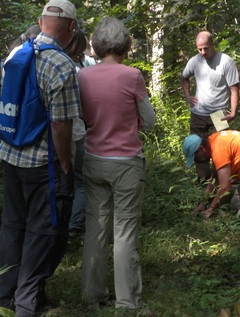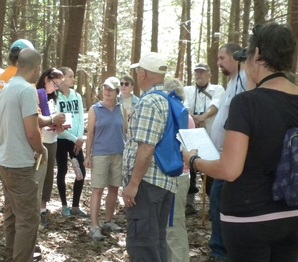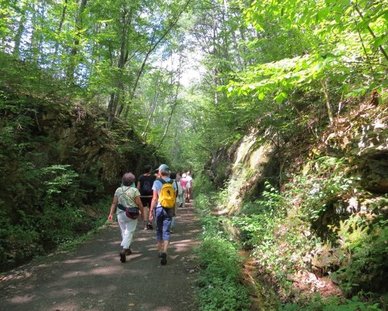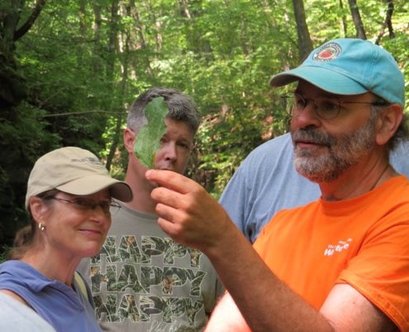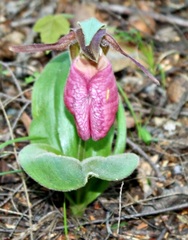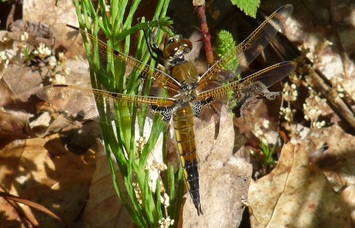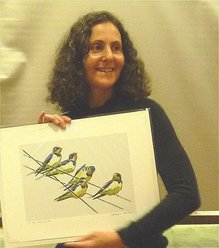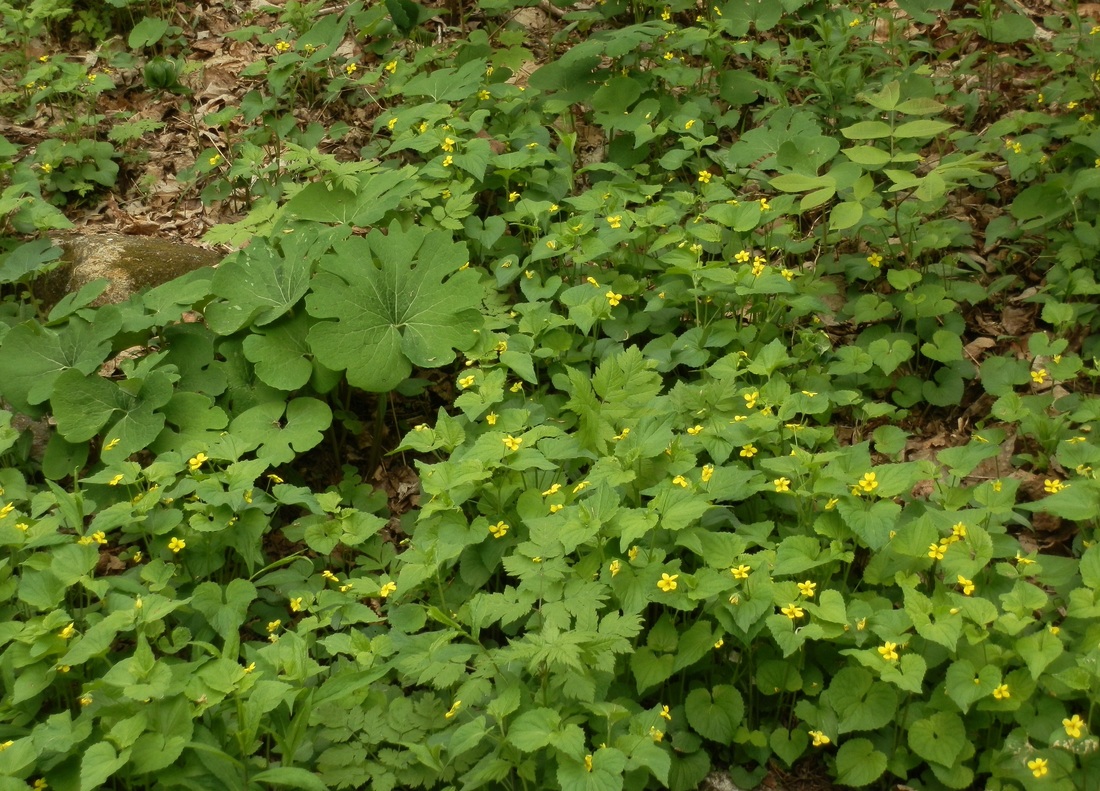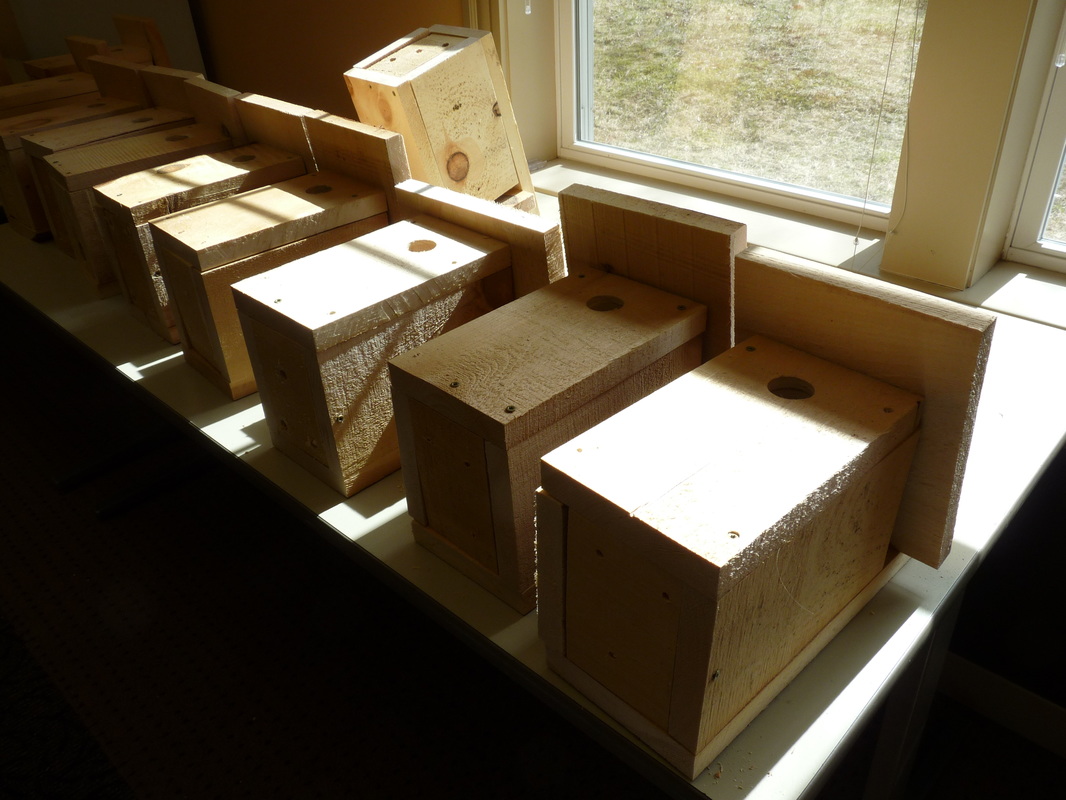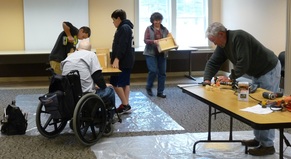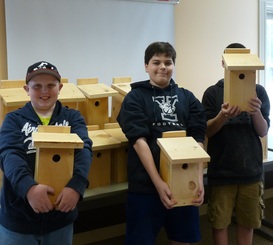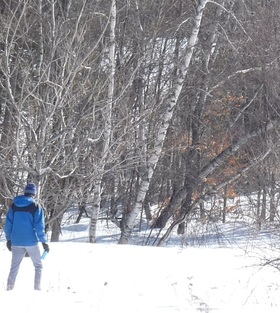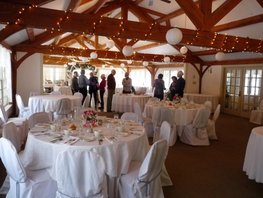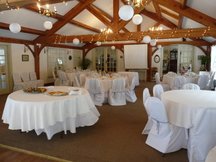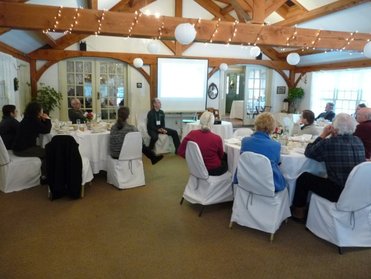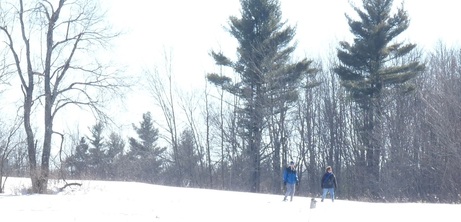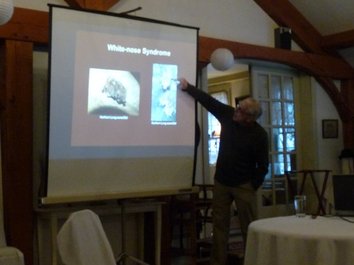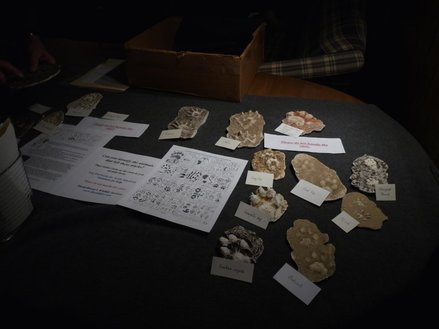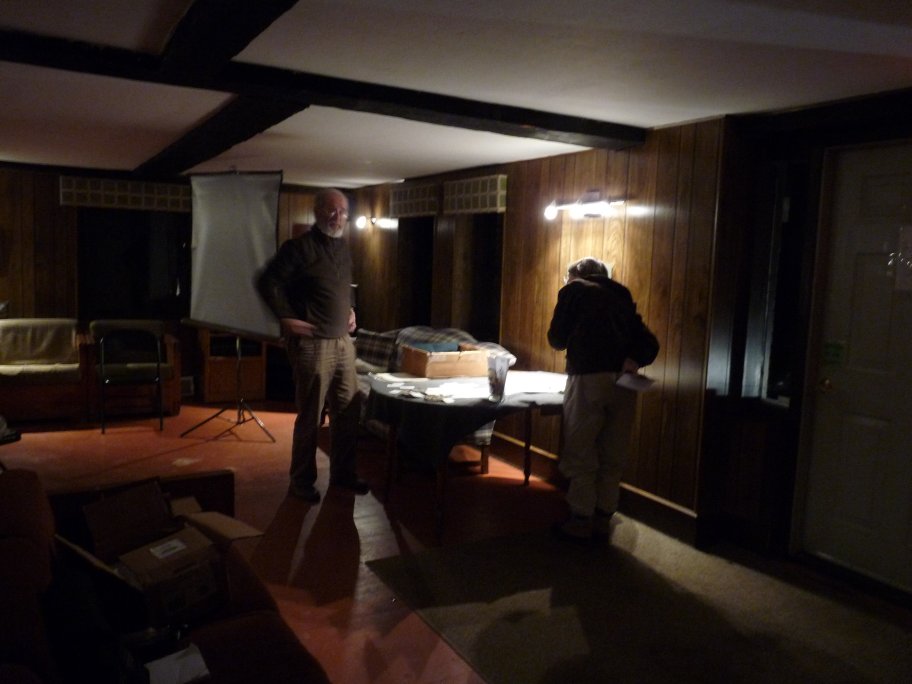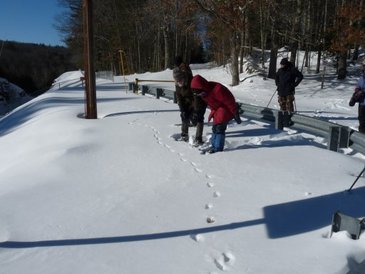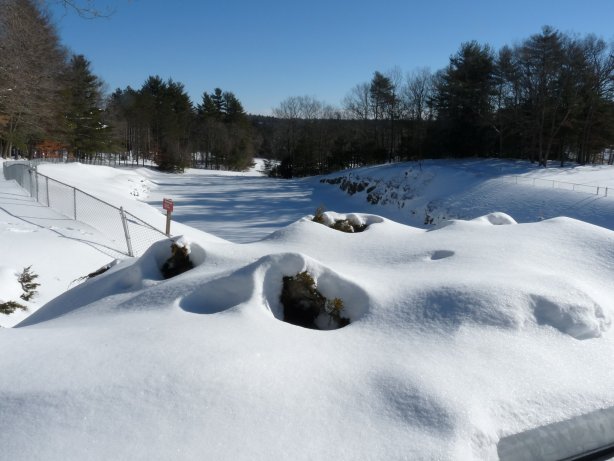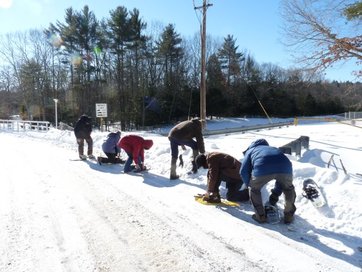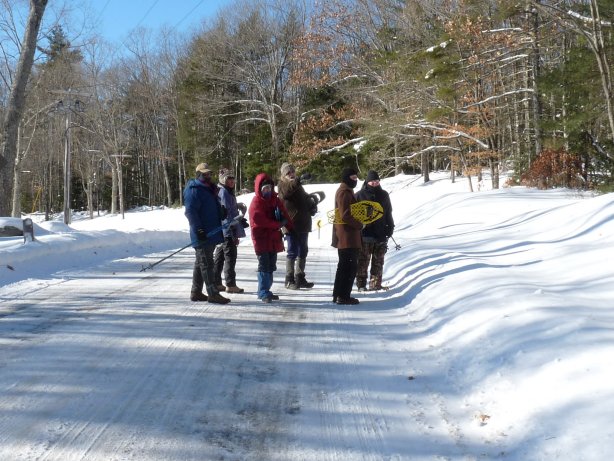>> PAST EVENTS <<
January 2015-June 2019
ECOLOGY & CONSERVATION OF
BARN & CLIFF SWALLOWS
by Mara Silver
Wednesday June 19, 2019 6:30 p.m.
East Quabbin Land Trust Office, 120 Ridge Road, Hardwick
|
Aerial insectivores, birds that catch insects while in flight, are declining in northeastern North America This group includes Cliff Swallows and Barn Swallows, both of which breed in agricultural settings; they use barns for nesting and forage in open fields. Reasons for the decline of these two species include habitat loss, climate change, agricultural intensification, and pesticides. But landowners are uniquely poised to directly help in the conservation of these native swallow species! Join us for Mara Silver's presentation on the relatively simple techniques she has developed over the past 25 years to encourage nesting success of Cliff Swallows and Barn Swallows at active nesting sites and to attract them to new nesting sites. The presentation will provide tips for creating and enhancing habitat for these two species by, for example, installing artificial nests, giving birds access to buildings, and maintaining mud sources. Additionally, there will be a display of artificial nests and printed information for participants.
Following the program we’ll car-pool to visit the nearby Korzec Farm to observe Barn Swallows in typical habitat. |
Mara Silver has been studying swallows for over 25 years. She works with various organizations and agencies throughout New England and Canada on swallow conservation projects. She holds a Masters Degree in Wildlife and Fisheries Conservation from UMass- Amherst. For her Masters Thesis she inventoried Bank Swallow habitat along the Connecticut River in Massachusetts. ~ Photos by Tom Murray ~ |
Alaska Wilderness:
|
In June and July 2001, Marcia and Mark Wilson spent nineteen days canoeing the Canning River on the western edge of the Arctic Refuge. Paddling north from a gravel riverbank that served as an airstrip in the Brooks Range, the Wilsons navigated a 17-foot folding canoe to explore seventy miles of arctic wilderness. With stunning photos and passionate commentary drawn from this trip and five other visits to the arctic, the Wilsons open a window to the arctic summer. |
|
SPRING BIRDS AND WILDFLOWERS WALK
Wednesday May 8, 2019 8 a.m. – noon EQLT Rail Trail New Braintree Leaders: Christy Barnes & Wendy Howes This pleasant trail provided easy access to a variety of Ware River Valley habitats. The weather was optimal, sunny and clear, with temperature near 70 degrees F. We encountered a good number of returning neotropical migrant birds, including Chestnut-sided, Yellow, and Blue-winged warblers and Wood Thrush. There was a fine assortment of blooming and newly-emerging wildflowers and ferns for the botany "treasure hunt" part of the walk. Nice finds were Glaucous Honeysuckle (Lonicera dioca)--not common in our area--Trout Lily (Erythronium americanum), blooming Bloodroot (Sanguinaria canadensis) and Wild Leek (Allium tricoccum). For a list of birds seen on the walk, go to: https://ebird.org/view/checklist/S56028777 |
For tips on finding spring ephemeral wildflowers and more information, go to:
https://www.mass.gov/news/now-is-the-time-to-look-for-blooming-spring-ephemerals
https://www.mass.gov/news/now-is-the-time-to-look-for-blooming-spring-ephemerals
|
SPRING BLOOMING EPHEMERALS
AND MORE by Karro Frost Wednesday April 17, 2019 7 p.m. Rutland Public Library |
Karro led us on an interesting and photo-rich tour of our wildflowers that bloom in early spring. She described both the traditional plants that one thinks of as spring ephemerals growing in rich forests as well as additional early-blooming species occurring in other types of habitats. These early bloomers are important to early pollinating insects, and we learned about several specialist pollinators as well as the important role ants play in seed dispersal.
Karro has worked as the Plant Restoration Biologist with Natural Heritage and Endangered Species Program at MassWildlife since 2013. Her responsibilities take her across the entire state, from the Cape and Islands to the Berkshires. She previously worked with an environmental consulting firm in Amherst on wetland permitting and is an active member and former Chair of the Warwick Conservation Commission. |
TIMBERDOODLE (WOODCOCK) WATCH
Thursday, April 11, 2019 6:30 – 8:00 p.m.
Hubbardston
The American Woodcock (nickname: Timberdoodle) has returned from its wintering grounds in the southern U.S. Back on breeding territory here in Massachusetts, males are claiming individual singing grounds in clearings near brushy cover. The open areas provide a stage from which they call and perform courtship display flights at dawn and dusk, and on nights when moonlight provides the right amount of light. We’ll listen for and observe this odd-looking member of the shorebird family as he repeatedly takes off, flies 50 to 100 yards in the air, spirals, the descends, zigzagging and banking. The downward flight produces a melodious twittering sound as the air rushes through the bird’s outer primary feathers.
Four participants walked at Mt. Jefferson Conservation Area, which has been a stronghold for this species for many years. Weather conditions were not ideal--overcast and cool--but at least two birds were present, and observers were able to get quite close to one bird and make out its form and movements on the ground. LIstening to the flight sounds was possible, but darkening skies precluded good views
of the spiraling flight.
Also encountered were four porcupines and three white-tailed deer.
Four participants walked at Mt. Jefferson Conservation Area, which has been a stronghold for this species for many years. Weather conditions were not ideal--overcast and cool--but at least two birds were present, and observers were able to get quite close to one bird and make out its form and movements on the ground. LIstening to the flight sounds was possible, but darkening skies precluded good views
of the spiraling flight.
Also encountered were four porcupines and three white-tailed deer.
|
EARLY SPRING BIRDING
DCR Ware River Watershed Barre Falls Dam & vicinity Saturday, March 30, 2019 8 a.m.-noon Leader: Wendy Howes On this trip we birded around Barre Falls Dam in Hubbardston/Barre in search of early spring migrants, lingering winter visitors, and resident species. We were able to cover the entrance road and parking lot area, the floodplain below the picnic area, and Tracy Road. After a cool and cloudy start, clearing skies and warmer temperatures arrived around mid-day. |
A DIVER’S VIEW
OF ANIMAL LIFE ON A CORAL REEF
by
Mark Rosenstein
Wednesday March 27, 2019 7 p.m.
Rutland Public Library
280 Main Street (Route 122A), Rutland
Coral Reef ecosystems are among the most diverse on earth, exceeding rain forests for variety and number of species. It's not just fish and coral, but nearly every phylum has representatives, often easy to see, on a healthy reef system. Mark will provide a brief overview of the animal life on a reef, from sponges, corals, and worms to sea squirts, fish and reptiles, illustrated by his underwater photography from many scuba dive trips to the South Pacific. Mark is an amateur marine biologist who has spent many years studying reef life, first in aquariums, then on increasingly frequent trips to the tropics. He's working on a field guide to the reef fish of Fiji to be published soon.
ANNUAL DINNER MEETING
& SILENT AUCTION
Sunday February 24, 2019 12 - 5 p.m.
Hartman's Herb Farm 1026 Old Dana Rd. Barre
|
(THE JOY OF) STUDYING BIRDS
by Brandi Van Roo Never has it been more important to collect data on our wild birds, whether it be done by academics like Dr. Van Roo or by citizen scientists reporting their observtions to eBird, Project Feeder Watch, or the more-than-one-hundred-year-old Christmas Bird Count. Dr. Van Roo’s research activities have spanned the spectrum of analysis, from the physiology of individual behavior to ecological interactions between species, to contributing to national, longitudinal studies of avian breeding success and the perpetual monitoring of seasonal migrations. Although catching and banding birds is at the heart of each of these studies, the demands, techniques, and outcomes vary significantly. Dr. Van Roo will share with you the joys, and the trials, of these activities in an attempt to explain why she continues to dedicate herself to their pursuit. Brandi Van Roo has been studying birds for more than twenty years. She earned her Ph.D. in ecological and evolutionary behavior from Indiana University in Bloomington , Indiana . She is Professor of Biology at Framingham State University where she teaches undergraduates how to conduct research and offers courses in ornithology, animal behavior, and wildlife biology. Dr. Van Roo has also served as the designated wildlife-biologist-member of the Massachusetts Division of Fisheries & Wildlife regulatory board for more than a decade. |
DOUBLE VISION:
SEEKING RARE, WATCHING COMMON by Devin Griffiths We birders are attracted to the rare and different. It’s natural, of course; we all love the thrill of finding something new, or seeing birds we don’t often encounter. And we love the challenge of identifying an unknown or uncommon species. The promise of those experiences—the potential of the possible—is one of the great joys of birding, and drives us to get out and look. In all the excitement over the unusual, though, we sometimes fail to appreciate the everyday birds who keep us company. However, without these regular companions birding would often be a lonely pursuit. The challenge for us is to strike a balance between them. Devin will give us a look at birds both rare and common, and share some of the moments that have inspired him. By the end, he hopes you’ll leave with a renewed sense of wonder, and an appreciation that crossing paths with any of these magical creatures is truly cause for celebration. Devin Griffiths is a professional writer and second-generation obsessed birder. He started birding at the age of eight, and since then has birded across the United States , on four continents, and over two oceans. Devin grew up in New York but moved to Massachusetts in 1987 to attend Hampshire College —where he studied natural science and writing, earning his B.A. in Science Journalism. He is currently working on his second book, covering a subject very close to his heart: birds. A Symphony of Feathers: Life in the Company of Birds explores the lives of birds, the human fascination with them, the struggles they face, and the pressing need to conserve and protect them.
|
THANK YOU to all who donated to our fundraiser SILENT AUCTION: Anonymous, Elise & Karl Barry, Anthony Costello, Ai Dodge, Otto Florist & Gifts, Anne Greene, Hardwick Farmers Coop, Michael Howes, Wendy Howes, Cheryl Moriarty, Cindy & Ted Purcell, Alan Rawle, Jean Rawle, Owen Sholes, Mara Silver,
Barry & Lisa Van Dusen.
|
Have orchids declined in abundance? What changes in native species have resulted from the decline in agriculture? Are all non-native plant species increasing? Has climate change been felt by the local flora? These and related questions will be addressed in a talk that draws on two of the most comprehensive studies of changes in plant species for any region of North America. These involve our very own Worcester and Franklin Counties and are based on over 25 years of field work and study of herbarium collections.
|
CHANGES IN THE FLORA
|
Robert Bertin is a Professor of Biology at the College of the Holy Cross, where he teaches Field Botany, Ecology,
and Environmental Science. He has been studying the flora of Massachusetts for over 25 years and is the author of Vascular Flora of Worcester County, Massachusetts and numerous related articles. This program is FREE and open to all. |
|
HIKE TO RUM ROCK
AND OSGOOD SWAMP MASS AUDUBON’S RUTLAND BROOK SANCTUARY PETERSHAM Saturday January 19, 2019 9:30 a.m. |
Good thing we hadn’t put our hiking boots away! We've been having an open winter-- higher than average temperatures and without reliable snow cover. Whether the “open” refers to the woods being passable in the absence of deep snow or the bodies of water that are unfrozen, it meant that our group had easy access to this interesting hiking spot. This pleasant loop trail winds through easily-walked terrain and alongside a large wetland. Rum Rock is an immense glacial erratic boulder. Our group located an area of the wetland being used extensively by beaver, as well as numerous excavations of trees by Pileated and other woodpeckers. Other mammal sign was plentiful, with evidence of deer, porcupine, and coyote. The quiet of the woods was interrupted only by tiny Golden-crowned Kinglet sounds the call of a raven, and our voices. Dramatic rocks, caves, and ledges were the highlight. |
|
CAMERA TRAPPING
MASSACHUSETTS BEARS with Jim and Mike Morelly Thursday December 13, 2018 7:30 p.m. Rutland Public Library 280 Main St. Rutland |
November is the month when we like to host a program about hunting with cameras. Once again Jim “Hikingcamera” Morelly will share some favorite images and video clips from trailcams in the Quabbin Reservation and adjacent public lands. This year he captured some wonderful footage of a Black Bear sow and cub at a den site. In addition to showing us images of the bears, Jim will talk about his passion for hiking, photography, and trailcams and describe some methods and strategies. Additionally, Mike Morelly, a wildlife biologist with MassWildlife, will share images and descriptions of winter bear den checks. This program is FREE and open to all. |
HOW MUSHROOMS CHANGED THE WORLD
|
Dr Hibbett is an evolutionary biologist specializing in the study of fungi, particularly mushrooms. His current research emphasizes genomics and molecular evolution but also draws on morphology, developmental biology, and paleomycology. All that sounds pretty complex, and it is! But this will be a down-to-earth talk highlighting the different ecologies of some local species, and participants are encouraged to bring collections of mushrooms to help illustrate various features and functions. |
|
FALL BIRDING WALK
DCR Ware River Watershed Sunday October 21, 2018 9 a.m. Leader: Wendy Howes Four of us looked for fall migrant and winter resident species on this chilly and windy morning walk. We saw many flocks as we entered the Barre Falls Dam proeprty, so we checked the entry & parking lot areaand then explored a small backroad section of the Ware River Important Bird Area (IBA) managed by DCR. The weather drove large numbers of Palm and Yellow-rumped warblers and White-throated Sparrows to forage on the ground and low in vegetation, so we had good looks at these species. Two Sharp-shinned Hawks were among many that were seen by the Barre Falls Hawkwatch volunteers (stationed in the parking lot) that day. |
To see the complete species count for the walk, view these two eBird checklists: https://ebird.org/view/checklist/S49358802 https://ebird.org/view/checklist/S49358949 |
|
THE JOY OF FUNGI
A walk with Joe Choiniere Saturday October 6, 2018 9:30 – noon Harvard Pond, Route 122, Petersham It’s no secret that Joe loves fungi and enjoys spreading the word about their beauty, ecology, and importance within the ecosystem. Nine participants joined Joe for this casual walk to look for what was out there after the record-breaking amounts of precipitation and heat of the past few months. NOTE: This was NOT a walk to identify edibles, although the topic inevitably arose for discussion. Several species of poisonous Amanitas that were encountered served as a reminder that those in search of edibles should proceed with caution. We focused on basic identification, growth habits, and ecosystem functions of the many varieties found growing near the trail. |
|
EAGLE ONE
Raising Bald Eagles A Wildlife Memoir with Dianne Benson Davis Rutland Public Library Wednesday September 26, 2018 7 p.m. Dianne has lived a life devoted to wildlife conservation and education, and she presented a program full of wildlife anecdotes and detailed natural history information. A licensed Wildlife Rehabilitator and Master Falconer, she eventually earned a Natural History degree and became a Certified Veterinary Technician. She went on to work with animals and students at the Tufts Veterinary School and Worcester’s Ecotarium. |
A turning point in Dianne's life occurred in 1985, when she spent the summer at Quabbin Reservoir, living in a pop-up tent trailer and caring for 8 young bald eagles that would become the nucleus of the state's Bald Eagle Restoration Project. In this program, Dianne will share her experiences at Quabbin and describe the day to day activities and development of her beloved eagles. Copies of her book, which she happily signed, were taken home by a few happy buyers. |
BOTANY WALK
|
Join us as we learn about identifying various species of asters, goldenrods, and other fall-flowering plants growing in a relatively compact area. Dr. Bertin teaches at College of the Holy Cross when he’s not researching or writing about the flora of Massachusetts. Meet at the base of Echo Lake Road, which is adjacent to the superintendent's house on Mountain Road. Bring a hand lens and a copy of Newcomb's or other wildflower guide if you have them. For more information: warerivernatureclub@yahoo.com |
|
BOTANY WALK
SWIFT RIVER PRESERVE (SLAB CITY TRACT) Routes 32/122, PETERSHAM |
Wednesday
August 15, 2018 9 – noon Leader: Christy Barnes MassAudubon Teacher/Naturalist Timed to coincide with the blooming of Cardinal Flower along the river, this walk will take us on a pleasant, mostly-shady loop trail through fields and forest. Plant identification will take up most of our time, but we won’t ignore the birds, butterflies, or other natural features of this Trustees of Reservations property. Bring binoculars, snacks, beverages if you wish. Contact warerivernatureclub@yahoo.com if in doubt about the weather. |
Field Trip:
|
Based in western Massachusetts, Charley conducts plant and wildlife surveys throughout New England. He is the lead author of the award-winning field guide Tracks & Sign of Insects and Other Invertebrates (now in its fourth printing) and has also published over twenty scientific papers describing new insect species or documenting new natural history information for known species. Charley writes an insect-themed blog, "BugTracks," with over 600 subscribers. He is currently working on a book about leaf-mining insects.
Julia is a homesteader, editor, and museum professional. Her passions are gardening, the written word, and preserving the natural world. This program was supported in part by a grant from
the Rutland Cultural Council, a local agency which is supported by the Massachusetts Cultural Council, a state agency. |
|
Robert Frost came of age in New England as a farmer, naturalist and poet. His descriptions of the rural landscape ring true because he lived here longer than anywhere else. While many people think of New England as little more than snapshots on a calendar, Frost knew how things changed, whether it was time of day, seasons of the year, or ecological succession after farms were abandoned. Participants read and discussed several poems about natural history and change, using the images conjured up as a jumping-off point for conversations about personal nature observations.
|
|
Owen Sholes taught ecology and environmental science at Assumption College for forty years. His research interests include plant-insect interactions and the response of trees to environmental stress. He and his wife live in Rutland. Owen's talk about Frost's keen sense of his natural surroundings, using various poems as examples, was entertaining and enlightening. His book, Stopping by Woods: Robert Frost as New England Naturalist (McFarland Books), will be available soon. We will announce it's publication in our e-newsletter and on the web-site. |
|
BIRDING STROLL
CENTRAL MASS RAIL TRAIL, RUTLAND -->Cancelled due to rain<-- Sunday May 20, 2018 8 – 11 a.m. Join Ted Purcell and Wendy Howes for an accessible, relaxed-pace outing to look for birds along a portion of the Central Massachusetts Rail Trail. Spring migration is ON, and this is the best time of year to view and listen to our returning neotropical migrants. Males are in their colorful breeding plumage and singing to attract females (and human birders). We’ll walk through different habitats and can expect to see various warblers, vireos, thrushes, and more. The walk will begin where there is a rail trail parking area at Miles Road, which is off Route 56. We’ll head towards Charnock Tunnel and see how far we get. |
|
NATURE RAMBLE AROUND HARVARD POND, PETERSHAM Saturday April 21, 2018 9 a.m. – noon A small group visited one of our favorite local trails, a loop of about 3 miles around Harvard Pond, which is owned and managed by Harvard Forest. We were looking and listening for early spring migrant birds and waterfowl and enjoyed the emerging green spring vegetation. A lingering cool weather trend kept insects at bay and turtles out of sight. For a list of birds seen on the walk, click HERE. |
|
The Complex Relationship
Between Birds and Gypsy Moths by Jennifer Forman Orth, PhD Wednesday April 18, 2018 7 p.m. Rutland Public Library 280 Main Street (Rte. 122A) Rutland For many in the world of pest management, the invasive insect known as the gypsy moth (Lymantria dispar) had fallen off the radar in recent years, after having caused massive tree deaths throughout Massachusetts back in the 1980s. But starting in 2015, the gypsy moth came back in a big way, defoliating hundreds of thousands of acres of trees. Jenn's informative presentation showed us the impact an outbreak of this size can have on birds in Massachusetts, and how birds impact gypsy moth populations in return. |
Jennifer Forman Orth is an invasive plant ecologist working as an Environmental Biologist at the Mass. Department of Agricultural Resources (MDAR), where she specializes in invasive plants and insect pests. When she is not working, she can often be found outside photographing and cataloging local insects, especially in the wee hours of the night. |
|
A few members got out to see what the diverse habitat of the Barre Falls WMA and DCR Old Prison Camp area was hosting for bird life at this time of year. We explored the Longmeadow Brook area, a shrubby powerline cut, and mixed forest on easy trails. A cool start under sunny skies eventually gave way to a warming mid-day. Early returning migrants included Tree Swallows and Eastern Phoebes. Good numbers of American Black Ducks and a handful of other waterfowls species were present. A complete checklist can be viewed HERE. |
EARLY SPRING BIRDING IN THE WARE RIVER WATERSHED Saturday March 31, 2018 8:30 a.m. – noon Leader: Wendy Howes |
Meeting place for winter walks into this section of DCR Ware River Watershed prperty is at gated parking area where Intervale and Charnock Hill Roads meet in Rutland. From Route 56 on Intervale Road, it’s about 2.5 miles to the gate. |
|
At this meeting, Club members and friends are invited to show off their favorite nature-themed camera shots. Do you like taking photographs of wildflowers, butterflies, wild animals and birds, scenic vistas, etc? Do you enjoy seeing great photographs even though you don't take pictures yourself? Please join us as a presenter
or audience member. The easy part is that participants may select photographs they've taken anywhere in the world in the past five years, as long as they portray wildlife, open spaces, botanical subjects, and/or people enjoying nature. The hard part: each person is limited to ten photos, and often it's hard to choose. Anyone who presents photos may talk about the circumstances and techniques relating to the shot. Or, say nothing at all! Don't be shy! You can be sure that our audience members will truly enjoy seeing nature experiences through the lenses of many different cameras and their owners. Please bring your photo selection on a thumb drive that isn't holding a lot of information. (It will speed up the process if the photos are the only thing on the drive.) It isn't necessary, but would be helpful, if you notify warerivernatureclub@yahoo.com in advance so we can know how many participants to expect. In the event of severe weather, the meeting will be postponed. |
WARE RIVER NATURE CLUB
|
The freshwater pearl mussel inhabits swift, shallow riffles and runs of clear, cool streams… exactly the kinds of streams that humans love to walk along and wade in. With even minimal coaching, anyone can find them…you just have to know where and how to look. Worldwide, this was one of the most widespread and abundant freshwater mussel species, but one that is now in considerable peril. In one of the most fascinating talks we've hosted, Dr. Baker described this animal—its distribution, habitat requirements, life-cycle, conservation, and restoration. There is local ongoing research, and this summer we'll organize a field trip to observe some mussel beds and learn more about the monitoring and marking that is going on right here in central Massachusetts. Professor Baker succeeded is convincing us all to care about the significance of Margaritifera and its precarious existence.
A HIKE AROUND HARVARD POND, PETERSHAM
Saturday November 11, 2017 9 a.m. – noon
|
This was indeed a “farewell to fall” hike around Harvard Pond! Temperatures dropped into the teens the night before and were still in the brisk twenties on this day, but sunny skies and sheltered locations provided warmth. The solo hiker (leader) walked the few miles, including some side trails, at an easygoing pace, passing through various ages and types of forest and along one section of Tom Swamp. Birds encountered included Fox Sparrows, Common Ravens, and many Golden-crowned Kinglets. Complete checklist may be viewed on eBird--click here. |
````````````````````````````````````````````````````````````````````````````````````````````````````````
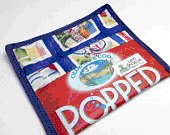
This educational and creative workshop showed participants how to produce an “upcycled” textile made from plastic bags/wrappers. Each participant made an upcycled fused pouch that can be used as a wallet, snack pouch, pencil case, receipt holder or otherwise. Participants learned skills that can be repeated to create more upcycled products from plastic bags that would otherwise be part of the waste stream.
Following an introductory presentation on plastic bags, recycling, and “upcycling,” workshop members created a fused collage piece of “fabric” with household irons. The resulting material was then made
into a colorful and sturdy useful item. Ideas for creativity beyond the workshop segment were generated.
Following an introductory presentation on plastic bags, recycling, and “upcycling,” workshop members created a fused collage piece of “fabric” with household irons. The resulting material was then made
into a colorful and sturdy useful item. Ideas for creativity beyond the workshop segment were generated.
Lou Leelyn of Lou's Upcycles offers workshops throughout the state. To learn more, click here.
|
Wednesday September 27, 2017 7 p.m. Rutland Public Library Rutland |
Dave introduced us to the basic biology and ecology of black bears in Massachusetts, including their diet, habitat use, and life history. The bear population is growing and expanding in the state, and Dave provided more details about that with up-to-date information about families MassWildlife is tracking and maps depicting bear movements and territories throughout central Massachusetts. His talk also covered the research MassWildlife is doing on black bears in the state and how that ties into bear management. Most important, Dave will addressed human-bear interactions and what people can do to keep our bear population healthy and reduce human-bear conflict. Members stayed long after the presentation to ask specific questions about the bears that share our backyards from time to time. Thanks to Dave for a fascinating and fact-filled presentation.
|
``````````````````````````````````````````````````````````````````````````````````````````````````````````
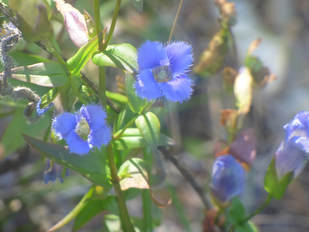
A RAMBLE AROUND
THE WARE RIVER WATERSHED
BARRE
Saturday, September 23, 2017 9 a.m. – early afternoon
[Foul weather date: Sunday, September 24th]
Club members sampled a few different features to be found on Department of Conservation & Recreation’s Ware River Watershed properties in Barre. We explored sections of Brigham Road near Barre Falls Dam and came upon some Cardinal Flower still in bloom and a Northern Water Snake. We did a bit of bushwhacking off Coldbrook Road to look for Fringed and Bottle Gentian blooming in a field managed for their protection
and managed to find both.
THE WARE RIVER WATERSHED
BARRE
Saturday, September 23, 2017 9 a.m. – early afternoon
[Foul weather date: Sunday, September 24th]
Club members sampled a few different features to be found on Department of Conservation & Recreation’s Ware River Watershed properties in Barre. We explored sections of Brigham Road near Barre Falls Dam and came upon some Cardinal Flower still in bloom and a Northern Water Snake. We did a bit of bushwhacking off Coldbrook Road to look for Fringed and Bottle Gentian blooming in a field managed for their protection
and managed to find both.
|
A moderately-strenuous walk up Riis Hill to take in the modest views and enjoy the early fall landscape and the old apple orchard was enjoyable. We encountered many fall migrants, including Blue-headed Vireos, Northern Parula, one Scarlet Tanager (in basic non-breeding plumage), and Pine Warblers. |
|
Sunday August 6, 2017 9:30 a.m. Ware River Watershed Prison Camp area, Rutland Leader: Lynn Harper Habitat Protection Specialist Natural Heritage & Endangered Species Program With net in hand, Lynn taught us some dragonfly ecology and identification basics, and we looked at several species of dragonflies up close. None were harmed in the process! We had the opportunity to take photos and learn about the special features of these fascinating and colorful insects. |
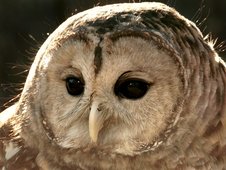
Saturday
May 20, 2017 10:30 a.m. – noon Rutland Public Library Everyone loves owls! Yet, how many of us have ever seen a live owl up close? Perhaps you’ve glimpsed the shadowy form of a Great Horned Owl in the headlights as you’ve traveled a back road at night. Ever scanned a frozen saltmarsh or farmer’s meadow in winter, hoping to find that Arctic hunter, the Snowy Owl? How about a mob of noisy crows circling a white pine tree – have they found an owl? Ware River Nature Club welcomed naturalist Marcia Wilson and photographer Mark Wilson as they shared their passion for owls! This special program introduced us to the owls of New England and beyond. Mark and Marcia shared the field marks, signs and naturalist’s skills that we can use to find wild owls without disturbing them and introduced the audience to six live owls up close. Everyone was treated to a hooting lesson, as well as tips on how to attract and protect owls near them. Exploring the world of owls with two talented naturalists made this interactive program fun and educational. |
++++++++++++++++++++++++++++++++++++++++++++++++++++++++++++++++++++++++++++++++++++++++++++++++++++++++++++++++++++++++
|
Monthly Program
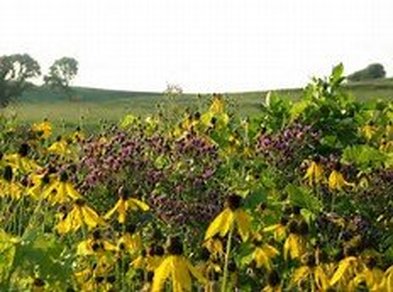
The Tall Grass Prairie, an Ancient Ecosystem that is a Modern Economic and Environmental Success by David Caporello **Cancelled** Thursday, April 27, 2017 7 p.m. Rutland Public Library 280 Main St. (Rte. 122A) Rutland |
[ This program was cancelled by the speaker due to a family emergency. We regret any inconvenience. We hope to reschedule it for a future date. ]
As spring comes to central MA, many gardeners are thinking about native plants and their origins. There are many plants native to the Midwest that are planted locally and add beauty to our landscape. But what is the true home of these plants? Think "prairie." Princeton resident and educator David Caporello first became interested in the tall grass prairie while working the first two weeks of June for several years in Lincoln, Nebraska, the center of what used to be the Midwest’s vast tall grass prairie ecosystem. In their spare time, he and a friend explored relict tracts of the original ecosystem. The Tall Grass prairie region of that state is comprised of 27 counties in eastern Nebraska, an area of gently rolling hills once nearly completely covered with tall grass prairie. Approximately one to two percent--about 300,000 scattered acres--of the original tall grass prairie remains. Today the University of Nebraska conducts research on protected land tracts. In addition to visiting some of these landscapes on foot, David also visited the University of Nebraska research library to learn more about the original prairies that used to be so much larger. Amazed by what he learned, he hopes to share his enthusiasm about what he experienced and describe some surprising successes in restoring this unique ecosystem in other places in Nebraska. |
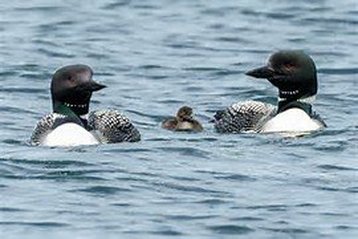
QUABBIN CRITTERS
with Dale Monette
Wednesday March 29, 2017 7 p.m.
Rutland Public Library
280 Main St. (Rte. 122A) Rutland
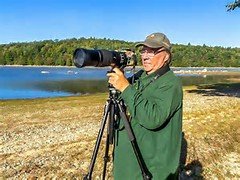
After retiring from his longtime job with the state’s Department of Conservation and Recreation (formerly Metropolitan District Commission) in 2014, Dale Monette started heading to the Quabbin and Ware River Watershed’s forests, ponds, and swamps to pursue his love of photography. He has spent many long hours working to capture images of birds and other wildlife in natural settings, enjoying and photographing from a distance and therefore getting pictures showing natural behavior.
Attendees were treated to a look at one of his collections of outstanding photos. Dale presented vibrant and intimate pictures of a variety of animals, organized by seasons. We learned that a book of some of his best photographs is in the making. Visitors to the region and local Quabbin area fans look forward to its publication.
We hope to host Dale at another Club program in the future.
^^^^^^^^^^^^^^^^^^^^^^^^^^^^^^^^^^^^^^^^^^^^^^^^^^^^^^^^^^^^^^^^^^^^^^^^^^^^^^^^^^^^^^^^^^^^^^^^^^^^^^^^^^^^^^^^^^^^^^^^^^^^^^^^^^^^^^^^^
After retiring from his longtime job with the state’s Department of Conservation and Recreation (formerly Metropolitan District Commission) in 2014, Dale Monette started heading to the Quabbin and Ware River Watershed’s forests, ponds, and swamps to pursue his love of photography. He has spent many long hours working to capture images of birds and other wildlife in natural settings, enjoying and photographing from a distance and therefore getting pictures showing natural behavior.
Attendees were treated to a look at one of his collections of outstanding photos. Dale presented vibrant and intimate pictures of a variety of animals, organized by seasons. We learned that a book of some of his best photographs is in the making. Visitors to the region and local Quabbin area fans look forward to its publication.
We hope to host Dale at another Club program in the future.
^^^^^^^^^^^^^^^^^^^^^^^^^^^^^^^^^^^^^^^^^^^^^^^^^^^^^^^^^^^^^^^^^^^^^^^^^^^^^^^^^^^^^^^^^^^^^^^^^^^^^^^^^^^^^^^^^^^^^^^^^^^^^^^^^^^^^^^^^
PROGRAM--NATURAL TREASURES OF MASSACHUSETTS
Two outstanding naturalists shared their thoughts and beautiful images of the special habitats and creatures to be found in our state. Particpants enjoyed two unique styles of expressing appreciation for the amazing diversity of Massachusetts nature.
Two outstanding naturalists shared their thoughts and beautiful images of the special habitats and creatures to be found in our state. Particpants enjoyed two unique styles of expressing appreciation for the amazing diversity of Massachusetts nature.
ARTIST-IN-RESIDENCE:
|
CITIZEN SCIENCE AT WORK:
|
~ ~ ~ Our Silent Auction provided entertainment and was a wonderful success! See ANNOUNCEMENTS. ~ ~ ~
``````````````````````````````````````````````````````````````````````````````````````````````````````````
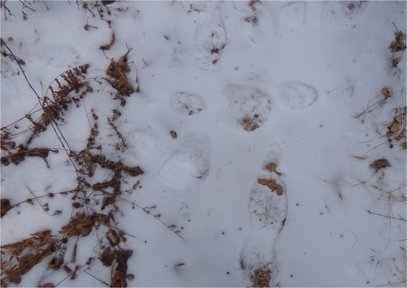 Fisher tracks, Quabbin Gate 43
Fisher tracks, Quabbin Gate 43
NATURE AND TRACKING WALK
with David Brown
Saturday February 25, 2017
10:30 a.m. - 1:30 p.m.
Barre Falls Dam, Hubbardston/Barre
Portions of the Barre Falls Dam/Army Corps of Engineers property have been consistently productive in searches for wildlife tracks and sign. Following a few days of unseasonably warm temperatures, participants trekked further into the woods and located ample snow and animal sign. While fisher, coyote, bobcat tracks have been seen on prior trips to this location, this walks served up a good deal of deer, raccoon, red fox, and gray fox sign. With the combined knowledge of the leader and and other experienced participants, we had good success with eco-tracking to learn more about the animal activity that preceded our trip. The resident ravens were about and soon will begin courtship and nest-building. A new puzzle we tried to piece together involved nipped-off maple twig ends originating high in the tree being found scattered on the ground below. Considering the fragility of the narrow branch tips, it seemed unlikely that a porcupine would have found enough support at the branch ends. Perhaps Ruffed Grouse had been budding here. Such are the questions encountered on these walks.
with David Brown
Saturday February 25, 2017
10:30 a.m. - 1:30 p.m.
Barre Falls Dam, Hubbardston/Barre
Portions of the Barre Falls Dam/Army Corps of Engineers property have been consistently productive in searches for wildlife tracks and sign. Following a few days of unseasonably warm temperatures, participants trekked further into the woods and located ample snow and animal sign. While fisher, coyote, bobcat tracks have been seen on prior trips to this location, this walks served up a good deal of deer, raccoon, red fox, and gray fox sign. With the combined knowledge of the leader and and other experienced participants, we had good success with eco-tracking to learn more about the animal activity that preceded our trip. The resident ravens were about and soon will begin courtship and nest-building. A new puzzle we tried to piece together involved nipped-off maple twig ends originating high in the tree being found scattered on the ground below. Considering the fragility of the narrow branch tips, it seemed unlikely that a porcupine would have found enough support at the branch ends. Perhaps Ruffed Grouse had been budding here. Such are the questions encountered on these walks.
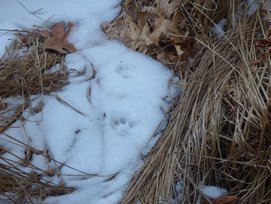 Bobcat tracks, Quabbin Gate 43
Bobcat tracks, Quabbin Gate 43
Leader David Brown developed Trackards for North American Mammals and wrote The Companion Guide to Trackards for North American Mammals. His most recent book is The Next Step: Interpreting Animal Tracks, Trails and Sign.
++++++++++++++++++++++++++++++++++++++++++++++++++++++++++++++++++++++++++++++++++++++++++++++++++++++++++
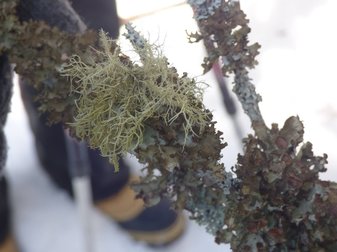
The western corner of Rutland features glacial outwash geology that supports state rare natural communities, rare species and unusual features. These areas have been identified by the Mass Natural Heritage BioMAP program as Core Habitats. Blood Swamp, with its large black spruce tamarack bog community--arguably the largest in Massachusetts--and the adjacent "Pine Plains" pitch pine/sand plain habitat are exemplary places. These habitats support dwarf mistletoe, purple tiger beetle, bog elfin (a butterfly) and New England blazing star, although only one of these can be found in winter! We explored the pine plains and located the interesting balsam poplar--which may be the"real thing" or its hybrid look- alike--and visited the edge of the black spruce bog to look for dwarf mistletoe and other bog woody plants. Participants found two types of plant galls, several species of lichen, Leatherleaf (Chamaedaphne calyculata), Sheep Laurel (Kalmia angustifolia), and other shrubs and trees that Joe and other botanists in the group helped identify. |
^^^^^^^^^^^^^^^^^^^^^^^^^^^^^^^^^^^^^^^^^^^^^^^^^^^^^^^^^^^^^^^^^^^^^^^^^^^^^^^^^^^^^^^^^^^^^^^^^^^^^^^^^^^^^^^^^^^^^^^^^^^^^^^^^^^^^^^^
PENUMBRAL LUNAR ECLIPSE FEBRUARY 10th
Perhaps some folks in central Massachusetts were fortunate enough to have clear skies from 5:30 – 10:00 the night of February 10th, so they could experience the changes to the moon’s appearance as it passed through the Earth’s penumbra or outer shadow. Although the astronomical event wasn't as dramatic as a total eclipse that darkens the moon, we would have liked to get a better look at the moon in shadow. Unfortunately, although the full "snow" moon--the second full moon of the 2017 lunar calendar--rose at 5:18 p.m. in a clear sky, it was mostly obscured by clouds (preceding another snowfall) at the peak time of the eclipse--7:43 p.m.--and afterward.
Maybe next time. . .We can look forward to a partial lunar eclipse January 31, 2018 and a total lunar eclipse on January 20-21, 2019.
***************************************************************************************************************************************************
Perhaps some folks in central Massachusetts were fortunate enough to have clear skies from 5:30 – 10:00 the night of February 10th, so they could experience the changes to the moon’s appearance as it passed through the Earth’s penumbra or outer shadow. Although the astronomical event wasn't as dramatic as a total eclipse that darkens the moon, we would have liked to get a better look at the moon in shadow. Unfortunately, although the full "snow" moon--the second full moon of the 2017 lunar calendar--rose at 5:18 p.m. in a clear sky, it was mostly obscured by clouds (preceding another snowfall) at the peak time of the eclipse--7:43 p.m.--and afterward.
Maybe next time. . .We can look forward to a partial lunar eclipse January 31, 2018 and a total lunar eclipse on January 20-21, 2019.
***************************************************************************************************************************************************
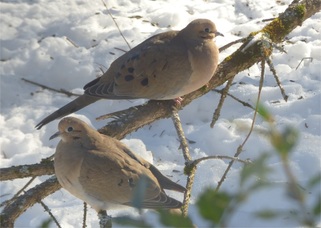
2017-2018 LOCAL CHRISTMAS BIRD COUNTS
Around the time that frost is descending on the pumpkin patch, avid birders begin marking their calendars so they can plan their participation in one or more local Christmas Bird Counts, sponsored by the National Audubon Society. Consider participating in this year’s count, the 117th. Birders of all levels are welcome to spend the day traveling a designated section and tallying all birds encountered, or, if you live within a count’s boundaries, counting the birds that visit your yard and feeder on the day of the event. To view maps of count circles, click here. The closest CBC for most of our members is Westminster, which includes sections of Princeton, Hubbardston, Templeton, etc., but all counts are happy to have more participants. Beginners may ask to team up with experienced birders. Contact compilers listed below or warerivernatureclub@yahoo.com for details.
Around the time that frost is descending on the pumpkin patch, avid birders begin marking their calendars so they can plan their participation in one or more local Christmas Bird Counts, sponsored by the National Audubon Society. Consider participating in this year’s count, the 117th. Birders of all levels are welcome to spend the day traveling a designated section and tallying all birds encountered, or, if you live within a count’s boundaries, counting the birds that visit your yard and feeder on the day of the event. To view maps of count circles, click here. The closest CBC for most of our members is Westminster, which includes sections of Princeton, Hubbardston, Templeton, etc., but all counts are happy to have more participants. Beginners may ask to team up with experienced birders. Contact compilers listed below or warerivernatureclub@yahoo.com for details.
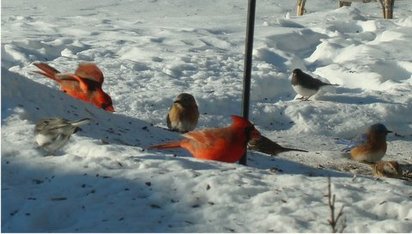
Wednesday, December 14th -- Sturbridge CBC-->for results click here<--
Compiler: Mark Lynch (508-799-9343) Email: moa.lynch@verizon.net
>> snow/ice date: Thursday, December 15
Saturday, December 17th -- Worcester CBC-->for results click here<--
Compiler: John Liller (508-877-5770) Email: John.Liller@worcesteracademy.org
>> snow/ice date: Sunday, December 18
Sunday, December 18th -- Ayer/Groton CBC Contact warerivernatureclub@yahoo.com for more information.
Saturday, December 17th -- Athol CBC-->for results click here<--
Compiler: David Small (978-413-1772) Email: dave@dhsmall.net
The Athol CBC has been conducted since the mid-1960’s, making it the longest continuously running bird data in the North Quabbin area.
Saturday, December 31st -- Uxbridge CBC
Compiler: Strickland Wheelock (508-265-2896) Email: skwheelock@yahoo.com
Thursday, January 5, 2017 -- Westminster CBC
Compiler: Charles Caron (978-874-5649) Email: caronenv@aol.com
Compiler: Mark Lynch (508-799-9343) Email: moa.lynch@verizon.net
>> snow/ice date: Thursday, December 15
Saturday, December 17th -- Worcester CBC-->for results click here<--
Compiler: John Liller (508-877-5770) Email: John.Liller@worcesteracademy.org
>> snow/ice date: Sunday, December 18
Sunday, December 18th -- Ayer/Groton CBC Contact warerivernatureclub@yahoo.com for more information.
Saturday, December 17th -- Athol CBC-->for results click here<--
Compiler: David Small (978-413-1772) Email: dave@dhsmall.net
The Athol CBC has been conducted since the mid-1960’s, making it the longest continuously running bird data in the North Quabbin area.
Saturday, December 31st -- Uxbridge CBC
Compiler: Strickland Wheelock (508-265-2896) Email: skwheelock@yahoo.com
Thursday, January 5, 2017 -- Westminster CBC
Compiler: Charles Caron (978-874-5649) Email: caronenv@aol.com
~~~~~~~~~~~~~~~~~~~~~~~~~~~~~~~~~~~~~~~~~~~~~~~~~~~~~~~~~~~~~~~~~~~~
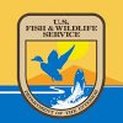
PROTECTING OUR WILDLIFE RESOURCES: RESPONSIBILITIES OF U.S. FISH & WILDLIFE’S
LAW ENFORCEMENT OFFICERS
by Special Agents Matt Gilmore & Jim Dowd
LAW ENFORCEMENT OFFICERS
by Special Agents Matt Gilmore & Jim Dowd
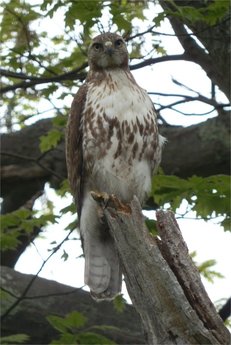
Wednesday, January 25, 2017 7 p.m.
(foul weather date: January 26th)
Rutland Public Library
280 Main Street (Route 122A)
Law enforcement is essential to virtually every aspect
of wildlife conservation. The mission of US Fish & Wildlife Service Office of Law Enforcement is to protect wildlife and plant resources. The OLE contributes to Fish and Wildlife Service homefront efforts to recover endangered species, conserve migratory birds, preserve wildlife habitat, safeguard fisheries, and combat invasive species.
It also promotes international wildlife conservation.
(foul weather date: January 26th)
Rutland Public Library
280 Main Street (Route 122A)
Law enforcement is essential to virtually every aspect
of wildlife conservation. The mission of US Fish & Wildlife Service Office of Law Enforcement is to protect wildlife and plant resources. The OLE contributes to Fish and Wildlife Service homefront efforts to recover endangered species, conserve migratory birds, preserve wildlife habitat, safeguard fisheries, and combat invasive species.
It also promotes international wildlife conservation.
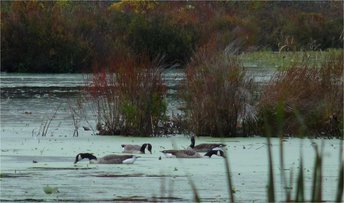
Service law enforcement today focuses on potentially devastating threats to wildlife resources -- illegal trade, unlawful commercial exploitation, habitat destruction, and environmental contaminants. In addition to investigating wildlife crimes and regulating wildlife trade, the Office provides education and information about wildlife protections laws, and works in partnership with international, state, and tribal counterparts to conserve wildlife resources.
Agents Gilmore and Dowd shared examples and experiences about the vital role of the law enforcement arm of USF&WS.
Agents Gilmore and Dowd shared examples and experiences about the vital role of the law enforcement arm of USF&WS.
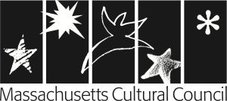
TRACKING WINTER WILDLIFE
with David Brown
Saturday January 14, 2017
9:00 a.m. Introductory session (indoors)
Pinecrest Lodge, 84 Bemis Road, Hubbardston
10:45 a.m. Woods walk
Meet at Barre Falls Dam entrance parking lot (first on left)
The eight participants--aged 12 to 80--who joined us for this event became acquainted with tracks and signs left behind by wild animals that share our landscape. Most wildlife species avoid humans or hide in the night, but by careful study of the clues that animals leave behind, observers can learn to visualize animal activity. ”Eco-tracking” teaches us
the relationship between wild creatures and their environment. Following an indoor slide show and discussion, we explored a wooded area of Army Corps of Engineers property at Barre Falls Dam. We hiked without snowshoes due to the open ground. Despite preceding days of rain with significant snow melt, the sheltered woods held enough snow so that we were able to locate, follow, and interpret many animal signs. Mammal species evidence included tracks of snowshoe hare, fisher, Eastern coyote, red fox, and gray squirrel, as well as shrew tunnels, shrubs browsed by white-tailed deer, deer scat, and a woodchuck burrow. Pileated Woodpeckers had recently been excavating dead trees, and one Common Raven was encountered. (Ravens nest annually at BFD.)
Leader David Brown developed Trackards for North American Mammals and wrote
The Companion Guide to Trackards for North American Mammals.
His latest book is The Next Step: Interpreting Animal Tracks, Trails and Sign.
This program was supported, in part, by a grant from the Hubbardston Cultural Council, a local agency which is supported by the Massachusetts Cultural Council, a state agency.
////////////////////////////////////////////////////////////////////////////////////////////////////////////////////////////////////////////////////////////
with David Brown
Saturday January 14, 2017
9:00 a.m. Introductory session (indoors)
Pinecrest Lodge, 84 Bemis Road, Hubbardston
10:45 a.m. Woods walk
Meet at Barre Falls Dam entrance parking lot (first on left)
The eight participants--aged 12 to 80--who joined us for this event became acquainted with tracks and signs left behind by wild animals that share our landscape. Most wildlife species avoid humans or hide in the night, but by careful study of the clues that animals leave behind, observers can learn to visualize animal activity. ”Eco-tracking” teaches us
the relationship between wild creatures and their environment. Following an indoor slide show and discussion, we explored a wooded area of Army Corps of Engineers property at Barre Falls Dam. We hiked without snowshoes due to the open ground. Despite preceding days of rain with significant snow melt, the sheltered woods held enough snow so that we were able to locate, follow, and interpret many animal signs. Mammal species evidence included tracks of snowshoe hare, fisher, Eastern coyote, red fox, and gray squirrel, as well as shrew tunnels, shrubs browsed by white-tailed deer, deer scat, and a woodchuck burrow. Pileated Woodpeckers had recently been excavating dead trees, and one Common Raven was encountered. (Ravens nest annually at BFD.)
Leader David Brown developed Trackards for North American Mammals and wrote
The Companion Guide to Trackards for North American Mammals.
His latest book is The Next Step: Interpreting Animal Tracks, Trails and Sign.
This program was supported, in part, by a grant from the Hubbardston Cultural Council, a local agency which is supported by the Massachusetts Cultural Council, a state agency.
////////////////////////////////////////////////////////////////////////////////////////////////////////////////////////////////////////////////////////////
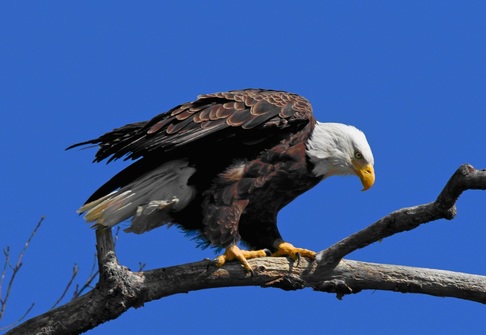
CAMERA-CAPTURING
CENTRAL MASSACHUSETTS BIRDS
by Jim “Hiking Camera” Morelly
Wednesday November 16, 2016 7 p.m.
Rutland Public Library 280 Main Street (Route 122A)
Jim has a passion for nature and hiking the New England woods with a camera in all seasons. Each hike brings the anticipation of what wildlife might be around the next corner. Many folks who attended Jim’s talk on Quabbin wildlife last year attended, recalling the outstanding animal photographs taken by someone with a lot of patience, ambition, and excellent “stealth-hiking” skills.
Jim put together
favorite photos of many avian subjects for this presentation, and we had a few identification challenges. Wonderful images of various warblers; a Snowy Owl that visited the Quabbin one winter; loons and waterfowl; and a Red-headed Woodpecker (uncommon) that is hanging around central Massachusetts were just some of the subjects of this enjoyable program.
For more great photographs, see Jim's blog here.
FAREWELL TO FALL HIKE Harvard Pond, Petersham Saturday October 29, 2017 9 – noon
BIRD LIST
Canada Goose (Branta canadensis) 1
Wood Duck (Aix sponsa) 40 Unmistakable males in fresh, brilliant plumage accompanied by females with large, blurry white "spectacle" facial pattern. Estimate. Small groups of paired birds were tucked away in various bays and kept flying from place to place, although the majority were seen from the main parking lot. This is a regular stopover for migrating Wood Ducks.
American Black Duck (Anas rubripes) 6
Mallard (Anas platyrhynchos) 12 Probably more that we didn't see. Not included in that number was a group of young ducklings; it was difficult to see how many due to distance, but it seemed like 8-10 at least. It seemed very unusual to encounter ducklings
at this late date, but October was mostly warm and mild.
Yellow-bellied Sapsucker (Sphyrapicus varius) 1
Hairy Woodpecker (Picoides villosus) 2
Pileated Woodpecker (Dryocopus pileatus) 1
Blue Jay (Cyanocitta cristata) 7
American Crow (Corvus brachyrhynchos) 40
Common Raven (Corvus corax) 1
Black-capped Chickadee (Poecile atricapillus) 12
Tufted Titmouse (Baeolophus bicolor) 3
Red-breasted Nuthatch (Sitta canadensis) 1
White-breasted Nuthatch (Sitta carolinensis) 4
Golden-crowned Kinglet (Regulus satrapa) 3
American Robin (Turdus migratorius) 1
Yellow-rumped Warbler (Setophaga coronata) 2
Fox Sparrow (Passerella iliaca) 1
Dark-eyed Junco (Junco hyemalis) 15
White-throated Sparrow (Zonotrichia albicollis) 2
Song Sparrow (Melospiza melodia) 10
Lincoln's Sparrow (Melospiza lincolnii) 1
Swamp Sparrow (Melospiza georgiana) 4
Northern Cardinal (Cardinalis cardinalis) 1
American Goldfinch (Spinus tristis) 4
BIRD LIST
Canada Goose (Branta canadensis) 1
Wood Duck (Aix sponsa) 40 Unmistakable males in fresh, brilliant plumage accompanied by females with large, blurry white "spectacle" facial pattern. Estimate. Small groups of paired birds were tucked away in various bays and kept flying from place to place, although the majority were seen from the main parking lot. This is a regular stopover for migrating Wood Ducks.
American Black Duck (Anas rubripes) 6
Mallard (Anas platyrhynchos) 12 Probably more that we didn't see. Not included in that number was a group of young ducklings; it was difficult to see how many due to distance, but it seemed like 8-10 at least. It seemed very unusual to encounter ducklings
at this late date, but October was mostly warm and mild.
Yellow-bellied Sapsucker (Sphyrapicus varius) 1
Hairy Woodpecker (Picoides villosus) 2
Pileated Woodpecker (Dryocopus pileatus) 1
Blue Jay (Cyanocitta cristata) 7
American Crow (Corvus brachyrhynchos) 40
Common Raven (Corvus corax) 1
Black-capped Chickadee (Poecile atricapillus) 12
Tufted Titmouse (Baeolophus bicolor) 3
Red-breasted Nuthatch (Sitta canadensis) 1
White-breasted Nuthatch (Sitta carolinensis) 4
Golden-crowned Kinglet (Regulus satrapa) 3
American Robin (Turdus migratorius) 1
Yellow-rumped Warbler (Setophaga coronata) 2
Fox Sparrow (Passerella iliaca) 1
Dark-eyed Junco (Junco hyemalis) 15
White-throated Sparrow (Zonotrichia albicollis) 2
Song Sparrow (Melospiza melodia) 10
Lincoln's Sparrow (Melospiza lincolnii) 1
Swamp Sparrow (Melospiza georgiana) 4
Northern Cardinal (Cardinalis cardinalis) 1
American Goldfinch (Spinus tristis) 4
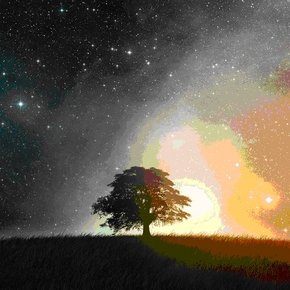
RAMBLING THROUGH OCTOBER & NOVEMBER
STARRY SKIES
with Jim Zebrowski and John Root
Aldrich Astronomical Society
Thursday October 27, 2016 7 p.m.
Rutland Public Library, 280 Main Street (Route 122A)
Many of us don’t have the time or inclination to go out after dark and look skyward. Even if we do, we may only notice the phase of the moon or be able to point out the Big Dipper. This fine introductory astronomy program was filled with beautiful imagery and a condensed educational tour through astronomical highlights and recent updates. It was suitable for the novice participants who wanted to get more acquainted with finding their way around the night sky. We learned about star-hopping techniques for finding constellations and locating visible objects like planets, double stars, galaxies, and star clusters visible in late October through November. We also heard of recent scientific discoveries and explorations of the solar system and beyond. Unfortunately heavy rains (accompanied by wet snow in some areas) precluded outdoor observations.
Many thanks to our excellent presenters for a fine show! They have offered to return for an instructional star-gazing evening at a future date, and we hope to take them up on that.
* * * * * * ( ( ( ( ( ) ) ) ) ) * * * * * *
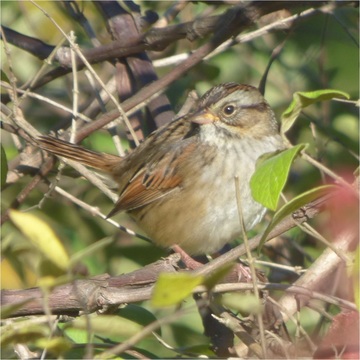
SPARROW WALK
HUBBARDSTON WILDLIFE MANAGEMENT AREA
Sunday October 23, 2016 9 a.m. – noon
This was an easy birding walk around the WMA and Cunningham Pond vicinity in search of late fall migrants. Clear skies and a brisk wind following the passage of a cold front translated to a "slow" day for birds. Not as many sparrows as expected!
Species list:
1 Ring-necked Pheasant Phasianus colchicus
(A male, left over from one of the local releases of stocked birds for hunters.)
4 Blue Jay Cyanocitta cristata
7 American Crow Corvus brachyrhynchos
21 Black-capped Chickadee Poecile atricapillus
3 Tufted Titmouse Baeolophus bicolor
6 Golden-crowned Kinglet Regulus satrapa Excellent looks!
6 White-throated Sparrow Zonotrichia albicollis
2 Northern Cardinal Cardinalis cardinalis
1 American Goldfinch Spinus tristis
We also found a large cluster of Woolly Aphids persisting on a speckled alder sapling. Woolly aphids are sucking insects that live on plant fluids and produce a filamentous waxy white covering resembling cotton or wool. Large numbers of fall fungi were present, having popped up after the recent period of precipitation.
~~~~~~~~~~~~~~~~~~~~~~~~~~~~~~~~~~~~~~~~~~~~~~~~~~~~~~~~~~~~~~~~~~~~~~~~~~~~~~~~~~~~~~~~~~~~~~~~~~~~~~~~~~~~~~~~~~~~~~~
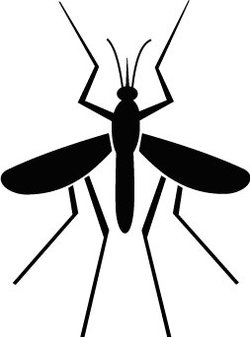
Monthly Program
MOSQUITOES THAT LOVE US,
AND THE DISEASES THAT LOVE THEM
by
Todd Livdahl, Ph.D.
Thursday, September 22, 2016 7 p.m.
Rutland Public Library, 280 Main Street (Route 122A)
Our first meeting and program of our Club season featured a timely topic both in terms of the time of year—still mosquito-friendly—and the recent news about the Zika virus. A professor of entomology at Clark University, Dr. Livdahl has researched and published widely on mosquitoes and other insect parasites, as well as ecological and biodiversity issues. As a grant project he led the “Great American Labor Day Mosquito Count” for many years, and sites here in central Massachusetts were included along with many others across the country. The study tracked the nation-wide spread of “alien” mosquito species.
Dr. Livdahl shared some of his research and knowledge of mosquitoes. He has been studying interactions among several different mosquito species, with a focus on Ochlerotatus triseriatus and other treehole dwelling native species, and invasive species, including Aedes aegypti, Aedes albopictus, and Oc. japonicus. His research has revealed an interesting population dynamic between the two species of non-native mosquitoes that are capable of carrying and transmitting theZika virus.It was enlightening to learn that Invasions by mosquitoes have occurred through the importation of used tires for recycling purposes. Along with new mosquitoes, parasites of mosquitoes have also arrived, and some of these new species interactions can have effects on resident species of mosquitoes as well as on the diseases that mosquitoes carry.
We are grateful to Dr. Lindahl for a fascinating presentation about this serious natural history subject.
MOSQUITOES THAT LOVE US,
AND THE DISEASES THAT LOVE THEM
by
Todd Livdahl, Ph.D.
Thursday, September 22, 2016 7 p.m.
Rutland Public Library, 280 Main Street (Route 122A)
Our first meeting and program of our Club season featured a timely topic both in terms of the time of year—still mosquito-friendly—and the recent news about the Zika virus. A professor of entomology at Clark University, Dr. Livdahl has researched and published widely on mosquitoes and other insect parasites, as well as ecological and biodiversity issues. As a grant project he led the “Great American Labor Day Mosquito Count” for many years, and sites here in central Massachusetts were included along with many others across the country. The study tracked the nation-wide spread of “alien” mosquito species.
Dr. Livdahl shared some of his research and knowledge of mosquitoes. He has been studying interactions among several different mosquito species, with a focus on Ochlerotatus triseriatus and other treehole dwelling native species, and invasive species, including Aedes aegypti, Aedes albopictus, and Oc. japonicus. His research has revealed an interesting population dynamic between the two species of non-native mosquitoes that are capable of carrying and transmitting theZika virus.It was enlightening to learn that Invasions by mosquitoes have occurred through the importation of used tires for recycling purposes. Along with new mosquitoes, parasites of mosquitoes have also arrived, and some of these new species interactions can have effects on resident species of mosquitoes as well as on the diseases that mosquitoes carry.
We are grateful to Dr. Lindahl for a fascinating presentation about this serious natural history subject.
^^^^^^^^^^^^^^^^^^^^^^^^^^^^^^^^^^^^^^^^^^^^^^^^^^^^^^^^^^^^^^^^^^^^^^^^^^^^^^^^^^^^^^^^^^^^^^^^^^^^^^^^^^^^^^^^^^^^^^^^^^^^^^^^^^^^^^^^^
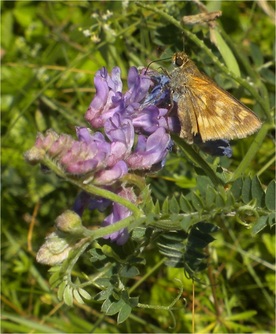 Long Dash (Polites mystic) on purple vetch.
Long Dash (Polites mystic) on purple vetch.
Massachusetts Butterfly Club Field Trip
BUTTERFLY WALK AT OLD PRINCETON LANDFILL
PRINCETON
Saturday, August 6, 2016 10:30 a.m. - 1:30 p.m. Leader: Wendy Howes
This former landfill, now owned by DCR, was capped and covered many years ago, and it’s interesting to watch the changes in the landscape and vegetation growth from year to year. There are woods and woods edges, many shrubby and sandy areas, and one large field that is mowed annually. After visiting the landfill, which has seen significant successional growth (not optimal for butterflies), we looked along the Ware River. Four participants enjoyed the warm but not-oppressive temperature, light breezes, and finding many late-season wildflowers in bloom, including an abundance of Cardinal Flower.
Old Landfill
1 Clouded Sulphur
3 Cabbage White
20 Pearl Crescent
1 Great Spangled Fritillary
3 Common Wood Nymph
8 Common Ringlet
1 Eastern Tailed-Blue
1 Little Wood Satyr
1 Appalachian Brown
1 Red-spotted Purple
2 Dun Skipper
1 Delaware Skipper
2 Unidentified "witches"
Old Colony Road environs/Ware River shoreline
13 Pearl Crescent
3 Red-spotted Purple
1 Red-spotted Admiral w/ white band on fore wing only
1 Monarch
1 Dun Skipper
3 Mulberry Wing
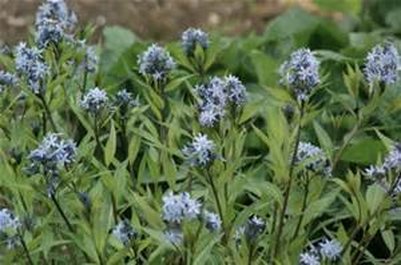
BEYOND LILACS & DAY LILIES:
GARDENING WITH NATIVE PLANTS
With Lisa Van Dusen at her garden in Princeton
Monday, June 27, 2016 6:00 p.m.
[Rain date: Friday July 1st]
Our final monthly program of the season was held outdoors. Lisa Van Dusen has been building her flower garden and enriching her landscape in Princeton for many years. As a new property owner, she was excited about the beautiful shade trees and attractive plants and shrubs growing there, until she began learning that some of them were aggressive non-natives. Besides learning about the perils of introducing non-native plant varieties into her landscape, Lisa discovered the benefits of using native flowers and shrubs to benefit wildlife. A commitment to building a garden with native plants and features attractive to birds and native bees and wasps became a driving force in her life. Lisa now has in her yard a great variety of plants and the creatures that use them. During an informal garden tour and conversation, we learned
about the joys of incorporating native plants into any garden setting.
Conservation Science for the Wood Turtle,
|
[NOTE: The presentation about Timber Rattlesnakes in Massachusetts by Dr. Tom French has been postponed indefinitely. We’re sorry to disappoint those of you who were looking forward to hearing more about this fascinating reptile and conservation planning to help ensure survival of the species in Massachusetts. We plan to re-schedule this talk at a later date. |
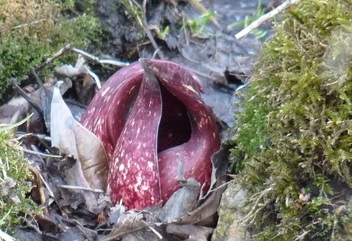
BURNSHIRT RAIL TRAIL NATURE WALK
Templeton/Hubbardston
Sunday April 17, 2016 1-4 p.m.
Easy walking along this portion of the old railroad bed (unimproved) took us through mixed woodlands and wetlands. We first checked Stone Bridge Pond on Stone Bridge Road (off Henshaw Road) in Templeton, then walked a few miles along the rail trail, which passes by the pond and crosses the river. There was plenty of emerging skunk cabbage (a favorite food of bears), Pine Warblers were singing and setting up territories, and Black-capped Chickadees were already on nests in softwood tree cavities. Bird highlights were many Yellow-bellied Sapsuckers (some will move on while others will remain to nest), a pair of Common Mergansers, and an Osprey. The mergansers will proceed northward to nesting territory, while the Osprey will likely depart after a few days and head to the coast.
~~~~~~~~~~~~~~~~~~~~~~~~~~~~~~~~~~~~~~~~~~~~~~~~~~~~~~~~~~~~~~~~~~~~~~~~~~~~~~~~~~~~~~~~~~~~~~~~~~~~~~~~~
|
WORKSHOP: PLANTING SEEDS FOR EARTH DAY Wednesday April 13, 2016 3:30- 5:30 p.m. Rutland Public Library 280 Main Street (Route 122A) Come and get your hands dirty as we plant seeds of bird- and pollinator-friendly flowers. To celebrate Earth Day on April 22nd WRNC members will be distributing the newly-planted seedlings to old friends as well as to friends we haven’t yet met! Bring your leftover peat pots, used (but clean) small clear plastic cups, and/or potting soil. Seeds will be provided.We’ll discuss the benefits of using native plants and plant species that provide nectar, pollen, and seed for native bees, butterflies, and birds. Distribution plans will be made. If you would like to obtain seedlings to share with your community, family, or social group on Earth Day, come to the workshop or contact warerivernatureclub@yahoo.com |
WHAT WE'LL BE PLANTING
Purple Coneflower (Echinacea purpurea) and Sneezeweed (Helenium autumnale) magnets for butterflies and pollinators and with seeds loved by goldfinches, juncos, and more. Grey Striped and Autumn Beauty Sunflowers, both of which produce plenty of pollen and numerous seeds. Many people may not realize that there has been an emergence of pollen free varieties of flowers in seed catalogues in order to satisfy some growers of cut flowers for market--pollen that drops off the flower heads is considered "messy." On the web-site for Turn to the Sun, we found this position statement " . . . I have come to understand the grave implications of choosing to grow pollen free varieties of sunflowers. Bees need pollen for its protein and fat, nectar for its sugar and water. When sunflowers, which bees find marvelously attractive, do not have "readily available" pollen, it is a cruel joke to the bee. . ." |
^^^^^^^^^^^^^^^^^^^^^^^^^^^^^^^^^^^^^^^^^^^^^^^^^^^^^^^^^^^^^^^^^^^^^^^^^^^^^^^^^^^^^^^^^^^^^^^^^^^^^^^^^^^^^^^^^^^^^^^^
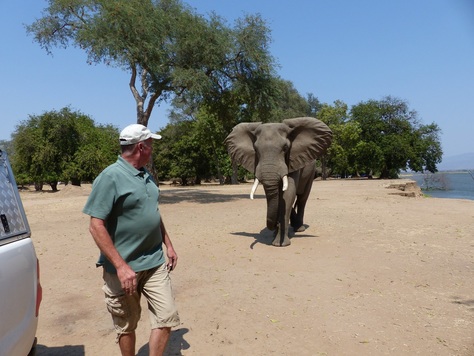
There's an Elephant
in the Campsite!
Self-driving through Zambia, Zimbabwe, and Botswana
by Cindy & Chuck Hartwell
Wednesday April 27, 2016 7 p.m.
Rutland Public Library
To celebrate their 30th wedding anniversary, Cindy and Chuck Hartwell of New Salem spent 21 days driving themselves through the African countries of Zambia, Zimbabwe and Botswana. Starting at Victoria Falls in Zambia, they leased a 4-wheel drive truck with a roof-mounted tent. After visiting the Falls from both the Zambia and Zimbabwe sides they began a 2,400 mile self-drive to National Parks and natural wonders. Their stops included Mana Pools, Hwange, and Matopos National Parks in Zimbabwe, and the Okavango Delta, Moremi and Chobe National Parks in Botswana.
Wildlife sightings exceeded expectations and bird life was stunning! The roar of hippos awakened them many nights, and a watchful eye was always needed to prevent losing food to moneys and baboons. Watching elephants splash in the waterholes and lions bask in the sun was a sight never to be forgotten. Exotic Violet-breasted Rollers and Hornbills were as common as blue jays and robins.
Chuck and Cindy are casual birders and naturalists with a spirit for adventure and a love of travel. Both retired, they are actively involved in economic development activities in Athol, are avid curlers, and are both on the Board of Directors of the Athol Bird and Nature Club.
Many thanks to Cindy and Chuck for sharing their wonderful trip highlights with us. Club members were treated to outstanding photos and videos of African animals, birds, and other African sights. Many in the audience went home dreaming of someday making a similar excursion!
To learn about Cindy and Chuck's ongoing connection to Oscar, a friend they met in Zimbabwe, see ANNOUNCEMENTS.
in the Campsite!
Self-driving through Zambia, Zimbabwe, and Botswana
by Cindy & Chuck Hartwell
Wednesday April 27, 2016 7 p.m.
Rutland Public Library
To celebrate their 30th wedding anniversary, Cindy and Chuck Hartwell of New Salem spent 21 days driving themselves through the African countries of Zambia, Zimbabwe and Botswana. Starting at Victoria Falls in Zambia, they leased a 4-wheel drive truck with a roof-mounted tent. After visiting the Falls from both the Zambia and Zimbabwe sides they began a 2,400 mile self-drive to National Parks and natural wonders. Their stops included Mana Pools, Hwange, and Matopos National Parks in Zimbabwe, and the Okavango Delta, Moremi and Chobe National Parks in Botswana.
Wildlife sightings exceeded expectations and bird life was stunning! The roar of hippos awakened them many nights, and a watchful eye was always needed to prevent losing food to moneys and baboons. Watching elephants splash in the waterholes and lions bask in the sun was a sight never to be forgotten. Exotic Violet-breasted Rollers and Hornbills were as common as blue jays and robins.
Chuck and Cindy are casual birders and naturalists with a spirit for adventure and a love of travel. Both retired, they are actively involved in economic development activities in Athol, are avid curlers, and are both on the Board of Directors of the Athol Bird and Nature Club.
Many thanks to Cindy and Chuck for sharing their wonderful trip highlights with us. Club members were treated to outstanding photos and videos of African animals, birds, and other African sights. Many in the audience went home dreaming of someday making a similar excursion!
To learn about Cindy and Chuck's ongoing connection to Oscar, a friend they met in Zimbabwe, see ANNOUNCEMENTS.
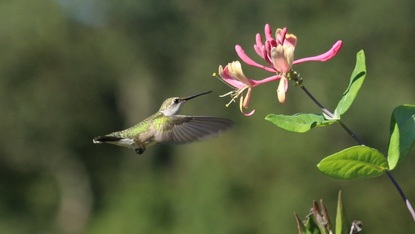 Female Ruby-throated hummingbird by Amir Ghazanfari. Copyright A. Gharanfazi. All rights reserved.
Female Ruby-throated hummingbird by Amir Ghazanfari. Copyright A. Gharanfazi. All rights reserved.
OBSERVATIONS OF
RUBY-THROATED
HUMMINGBIRDS
by
Amir Ghazanfari
Tuesday March 29, 2016 7 p.m.
Rutland Public Library
Biologist Amir Ghazanfari has been admiring, studying, and photographing Ruby-throated Hummingbirds around metro-Boston and central Massachusetts since 2008. In this presentation, he shared general life history and ecology information about our tiniest bird species, which included scholarly findings of other scientists as well as observations from his personal field studies. There was much discussion about supplemental feeding--using 1 part sucrose to 3 parts water is recommended. Use no dyes, fructose, or honey. Clean feeders frequently, every 40-50 hours or more often if the solution becomes cloudy. We also learned about favorite hummingbird plants--orange jewelweed, all Salvia species, and Monarda (bee balm) plants are favorites. An artistic look at hummingbirds through the use of many beautiful photographs added to our enjoyment. This talk reminded us that spring is right around the corner!
************************************************************************************************************************
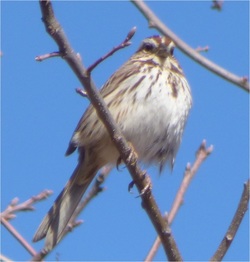
“SIGNS OF SPRING” WALK
HIGH RIDGE WILDLIFE MANAGEMENT AREA, GARDNER
Saturday March 19, 2016 9:00 a.m. –12:30 p.m.
Our leisurely-paced walk to look for spring migrant bird species and other signs of spring coincided with a cold front that moved in the night before. We avoided the cold wind and walked through low, sunny areas. Bird species that were arriving on territory or passing through from their southern wintering grounds were Song Sparrows and Red-winged Blackbirds. There were many groups of migrating Song Sparrows, but no other sparrow species accompanying them. Many of the Songs were living up to their name and singing lustily from tall perches. Also found: Red-winged Blackbird, Common Grackle, Red-tailed Hawk, Dark-eyed Juncos--many also singing-- a pair of Common Mergansers, and Canada Geese. One pair of geese boldly flew across a large wetland area and honked noisily at on dog and owner, obviously defending what they have
claimed as their territory. Trees and shrubs showed very early buds. There is still much of spring to come!
HIGH RIDGE WILDLIFE MANAGEMENT AREA, GARDNER
Saturday March 19, 2016 9:00 a.m. –12:30 p.m.
Our leisurely-paced walk to look for spring migrant bird species and other signs of spring coincided with a cold front that moved in the night before. We avoided the cold wind and walked through low, sunny areas. Bird species that were arriving on territory or passing through from their southern wintering grounds were Song Sparrows and Red-winged Blackbirds. There were many groups of migrating Song Sparrows, but no other sparrow species accompanying them. Many of the Songs were living up to their name and singing lustily from tall perches. Also found: Red-winged Blackbird, Common Grackle, Red-tailed Hawk, Dark-eyed Juncos--many also singing-- a pair of Common Mergansers, and Canada Geese. One pair of geese boldly flew across a large wetland area and honked noisily at on dog and owner, obviously defending what they have
claimed as their territory. Trees and shrubs showed very early buds. There is still much of spring to come!
ANNUAL DINNER MEETING & SILENT AUCTION
February 28, 2016
Hartman's Herb Farm, Barre
February 28, 2016
Hartman's Herb Farm, Barre
THANK YOU TO HARTMAN'S HERB FARM for the outstanding food and service!
And many thanks to all who donated the many wonderful and interesting items for the silent auction: Petersham Country Store, Rose 32 Bakery & Cafe, Hardwick Farmers Coop, Beverly Chase, Marsha Paine, Alan Rawle, Barry Van Dusen, Amir Gharanfazi, Wendy Howes, Peter Trull, Diane Nassif, and Ware River Nature Club. ^^^^^^^^^^^^^^^^^^^^^^^^^^^^^^^^^^^^^^^^^^^^^^^^^^^^^^^^^^^^^^^^^^^^
NATURE’S ENGINEERS:
BEAVER PUZZLES & BEAVER SOLUTIONS by Mike Callahan Owner of Beaver Solutions LLC Wednesday, January 27, 2016 7 p.m. Rutland Public Library 280 Main Street (Route 122A) We took a look at one of our most fascinating and enigmatic mammals which, according to fossil records, has lived in North America for about 6 million years. Beavers survived and thrived despite ice ages and other challenges, adapting to a wide variety of landscapes, but then faced population challenges when humans arrived. Native Americans co-existed with them successfully for thousands of years, but European settlers, lacking understanding of the ecological importance of wetlands created by the creatures, hunted and trapped them to near extirpation in Massachusetts and most of New England by 1750.
What were defined as beaver-human landscape “conflicts” persisted as humans drained wetlands for agriculture, but it eventually became apparent to biologists that wetlands had great value, and beavers played a key role in the creation and maintenance of these habitats. Because the species was in serious decline here, beaver were reintroduced to Massachusetts by state Fisheries and Wildlife biologists in the 1930’s. In addition, in the 1960's, many states passed wetlands protection laws. We learned about the ecological value of beaver impacts on the landscape, how beavers function as a “keystone” species, life history, and present-day human-beaver interactions. |
^^^^^^^^^^^^^^^^^^^^^^^^^^^^^^^^^^^^^^^^^^^^^^^^ This introductory talk and outdoor hike in fresh snow acquainted participants with the process of finding, identifying, and interpreting wildlife sign. Our leaders were well-known tracker-naturalist David Brown (see below) and botanist and long-time Oakham resident Caren Caljouw as we explored the winter ecology of a portion of the Oakham WMA. Ironically, animal tracks were at a minimum, since many animals hunker down for 24-48 hours before venturing out after a snowstorm. But it was a lovely day to be out learning about plants in winter and talking about mammal winter strategies. This program was supported in part by a grant from the Oakham Cultural Council, a local agency which is supported by the Massachusetts Cultural Council, a state agency. He is the author of Trackards for North American Mammals and The Companion Guide to Trackards, and his newest book The Next Step: Interpreting Animal Tracks, Trails and Sign has just been released. It complements his first two books in that it deals mostly with two neglected aspects of wildlife tracking: finding animal sign in the first place and then interpreting what you have identified for behavior. Following an introductory slide program and a look at plaster casts of many mammal tracks, participants shared lunch and snacks before heading outdoors.
For photos from the day see East Quabbin Land Trust, with whom the event was sponsored, and From the Field. It's no secret that human-beaver conflicts occur when beaver activity results in flooding of infrastructure important to humans, such as roads, drainage ditches, and culverts. For years land managers and highway crews have tried various protection and/or diversion devices, with mixed results. Mike and other specialists who are working in this field are spreading the word about flow device developments that have dramatically transformed beaver conflict mitigation efforts. Coexisting with beaver whenever possible makes good ecologic and economic sense. Mike is committed to sharing his wealth of beaver management knowledge with others. |
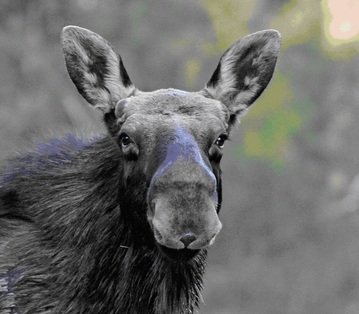
^^^^^^^^^^^^^^^^^^^^^^^^^^^^^^^^^^^^^^^^^^^^^^^^^^^^^^^^^^^^^^^^^^^^^^^^^^^^^^^^^^^^^^^^^^^^^^^^^^^^^^^^^^^^^^^^^^^^^^^^^^^^^^^^^^^^^^^^^
QUABBIN RESERVOIR’S WILDLIFE
by
Jim “Hikingcamera” Morelly
Thursday, December 10, 2015 7 p.m. Rutland Public Library
About 40 people joined us for a presentation about what this “accidental wilderness” offers for wildlife, photography, and hiking opportunities. Jim is an outdoor enthusiast and amateur wildlife photographer who has hiked 1,800 miles within the boundaries of Quabbin Reservoir Reservation, always carrying a camera. We enjoyed looking at some outstanding photographs and learned many tips for photographing wildlife. Jim's enthusiastic stories of his experiences on the roads and trails of the region were very entertaining and lively. Some of the points he covered:
~ best times to see wildlife
~most productive locations for wildlife viewing
~ equipment recommendations
~ tips for increasing wildlife sightings
~ what to watch out for
~lessons learned
We'll look forward to seeing more photographs at another program in the future.
QUABBIN RESERVOIR’S WILDLIFE
by
Jim “Hikingcamera” Morelly
Thursday, December 10, 2015 7 p.m. Rutland Public Library
About 40 people joined us for a presentation about what this “accidental wilderness” offers for wildlife, photography, and hiking opportunities. Jim is an outdoor enthusiast and amateur wildlife photographer who has hiked 1,800 miles within the boundaries of Quabbin Reservoir Reservation, always carrying a camera. We enjoyed looking at some outstanding photographs and learned many tips for photographing wildlife. Jim's enthusiastic stories of his experiences on the roads and trails of the region were very entertaining and lively. Some of the points he covered:
~ best times to see wildlife
~most productive locations for wildlife viewing
~ equipment recommendations
~ tips for increasing wildlife sightings
~ what to watch out for
~lessons learned
We'll look forward to seeing more photographs at another program in the future.
^^^^^^^^^^^^^^^^^^^^^^^^^^^^^^^^^^^^^^^^^^^^^^^^^^^^^^^^^^^^^^^^^^^^^^^^^^^^^^^^^^^^^^^^^^^^^^^^^^^^^^^^^^^^^^^^^^^^^^^^
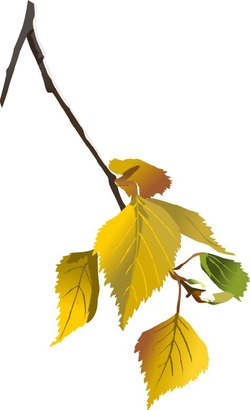
"FAREWELL TO FALL"
HIKE AROUND HARVARD POND
Sunday November 15, 2015 9:30 a.m. - 12:30 p.m.
Six outdoor enthusiasts hiked this pleasant Harvard Forest property. We observed the last of the green plants and fungi of the season and tested our ability to identify mostly-leafless trees. Birds encountered--some of them after the hike had formally ended-- included resident winter birds Pileated and Hairy woodpeckers and White-breasted (no Red-breasted) Nuthatches. Two Fox Sparrows and a drumming Ruffed Grouse were nice surprises. The only waterfowl encountered were three Black Ducks.
This hike is approximately 3 miles of flat terrain. We encountered plenty of signs of beaver activity, including more than one lodge.
Photos to follow.
^^^^^^^^^^^^^^^^^^^^^^^^^^^^^^^^^^^^^^^^^^^^^^^^^^^^^^^^^^^^^^^^^^^^^^^^^^^^^^^^^^^^^^^^^^^^^^^^^^^^^^^^^^^^^^^^^^^^^^^^
|
The wail of a common loon is often associated with the pristine lakes and deep woods of the north. However, Common Loons (Gavia immer) are also residents of Massachusetts and can be seen on a variety of lakes and ponds around the state. This presentation included many beautiful images and a few excellent video segments that followed common loons through the four seasons. We got a glimpse into their lives as they move from the ocean in winter to their breeding lakes during spring and summer. We also learned about the natural history of loons and some threats facing their small population. Many thanks to Dan for an outstanding talk! |
^^^^^^^^^^^^^^^^^^^^^^^^^^^^^^^^^^^^^^^^^^^^^^^^^^^^^^^^^^^^^^^^^^^^^^^^^^^^^^^^^^^^^^^^^^^^^^^^^^^^^^^^^^^^^^^^^^^^^^^^
A follow-up FALL BIRDING WALK AT HIGH RIDGE WMA took place on Sunday, October 19, 2015, following a dramatic change in the weather. Passage of a cold front on the previous day, as well as strong breezes, resulted in the absence of migrants that had moved on and lower numbers of sparrows, although Song Sparrows were abundant. Two Eastern Phoebes and three Gray Catbirds were still hanging on but probably will depart soon. Other sightings included two Red-tailed Hawks, a couple of Yellow-rumped Warblers, and one Hermit Thrush. It's likely that there were plenty more birds hunkering down out of sight. A complete list can be seen at eBird.org.
A follow-up FALL BIRDING WALK AT HIGH RIDGE WMA took place on Sunday, October 19, 2015, following a dramatic change in the weather. Passage of a cold front on the previous day, as well as strong breezes, resulted in the absence of migrants that had moved on and lower numbers of sparrows, although Song Sparrows were abundant. Two Eastern Phoebes and three Gray Catbirds were still hanging on but probably will depart soon. Other sightings included two Red-tailed Hawks, a couple of Yellow-rumped Warblers, and one Hermit Thrush. It's likely that there were plenty more birds hunkering down out of sight. A complete list can be seen at eBird.org.
****************************************************************************************************************************************************************
FALL BIRDING WALK
HIGH RIDGE WILDLIFE MANAGEMENT AREA, GARDNER
Monday, October 12, 2015 8:00 a.m. –noon
We explored the west side of this WMA, which includes a variety of habitats, including wetlands and fields. The weather was warm and sunny.
A leisurely-paced walk to look for fall migrants turned up high numbers of sparrows, including Savannah, Song, and Swamp. Other highlights were Palm Warblers, a pair of Belted Kingfishers, two Sharp-shinned Hawks, a Cooper's Hawk, and one Rusty Blackbird. The day's list can be viewed on eBird.
Bring binoculars if you have them and wear footwear appropriate for damp spots.
***************************************************************************************************************************************************************
FALL BIRDING WALK
HIGH RIDGE WILDLIFE MANAGEMENT AREA, GARDNER
Monday, October 12, 2015 8:00 a.m. –noon
We explored the west side of this WMA, which includes a variety of habitats, including wetlands and fields. The weather was warm and sunny.
A leisurely-paced walk to look for fall migrants turned up high numbers of sparrows, including Savannah, Song, and Swamp. Other highlights were Palm Warblers, a pair of Belted Kingfishers, two Sharp-shinned Hawks, a Cooper's Hawk, and one Rusty Blackbird. The day's list can be viewed on eBird.
Bring binoculars if you have them and wear footwear appropriate for damp spots.
***************************************************************************************************************************************************************
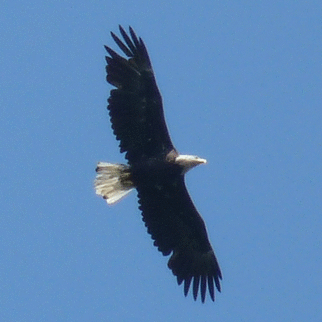
Sorry. . .cancelled due to weather!
HAWK WATCHING AT BARRE FALLS DAM
Saturday, October 3, 2015 9:00 a.m. to 12:30 p.m.
Leaders: Dave Grant & Donna Schilling
Early October is a wonderful time to observe hawk migration in Central Massachusetts. Ospreys, Northern Harriers, Sharp-shinned and Cooper’s Hawks are moving through, and the first week of the month offers the best opportunity to observe and compare the Northeast’s three falcons – American Kestrel, Merlin, and Peregrine. Spotting a Bald Eagle is likely,
and we may even see a few “late” Broad-winged Hawks.
~~~~~~~~~~~~~~~~~~~~~~~~~~~~~~~~~~~~~~~~~~~~~~~~~~~~~~~~~~~~~~~~~~~~~~~~~~~~~~~~~~~~~~~~~~~~~~~~~~~~~~~~~~~~~~~~~~~~~~~~
HAWK WATCHING AT BARRE FALLS DAM
Saturday, October 3, 2015 9:00 a.m. to 12:30 p.m.
Leaders: Dave Grant & Donna Schilling
Early October is a wonderful time to observe hawk migration in Central Massachusetts. Ospreys, Northern Harriers, Sharp-shinned and Cooper’s Hawks are moving through, and the first week of the month offers the best opportunity to observe and compare the Northeast’s three falcons – American Kestrel, Merlin, and Peregrine. Spotting a Bald Eagle is likely,
and we may even see a few “late” Broad-winged Hawks.
~~~~~~~~~~~~~~~~~~~~~~~~~~~~~~~~~~~~~~~~~~~~~~~~~~~~~~~~~~~~~~~~~~~~~~~~~~~~~~~~~~~~~~~~~~~~~~~~~~~~~~~~~~~~~~~~~~~~~~~~
The region in and around the Ware River Watershed is home to over 100 species of edible wild plants, many of which are more nutritious and/or flavorful than their cultivated counterparts. The region is home to dozens of species of edible wild mushrooms as well. Expert forager Russ Cohen, author of Wild Plants I Have Known… and Eaten, kicked off our season of monthly evening programs and presented a wonderful slide show. His program covered more than 40 of the tastiest plants and mushrooms the region has to offer. These ranged from plant species familiar to everyone, like daisies and dandelions, to species most of us had never heard about, like Calamus and Carrion Flower. About a dozen of the easiest to recognize wild mushroom species were covered as well, ranging from Morels in the spring, Black Chanterelles in the summer, and Hen of the Woods mushrooms in the fall. Identification tips for each species were provided, along with information on edible portion(s), season(s) of availability and preparation methods, as well as guidelines for safe and environmentally-responsible foraging. Russ also brought along handouts and a foraged Shagbark Hickory nuts for people to taste. We also were treated to unexpectedly tasty fruit leather made from Autumn Olive (which can be foraged guilt-free, since it is an undesirable invasive) and cookies made with hickory nuts.
>>>>>>>>>>>>>>>>>>>>>>>>>>>>>>>>>>>>>>>>>>>>>>>>>>>>>>>>>>>>>>>>>>>>>>>>>>>>>>>>>>>>>>>>>>>>>>>>><<<<<<<<<<<<<<<<<<<<<<<<<<<<<<<<<<<<<<<<<<<<<<<<<<<<<<<<<<<<<<<<<<<<<<<<<<<<<<<<<<<<<<<<<<<<<<
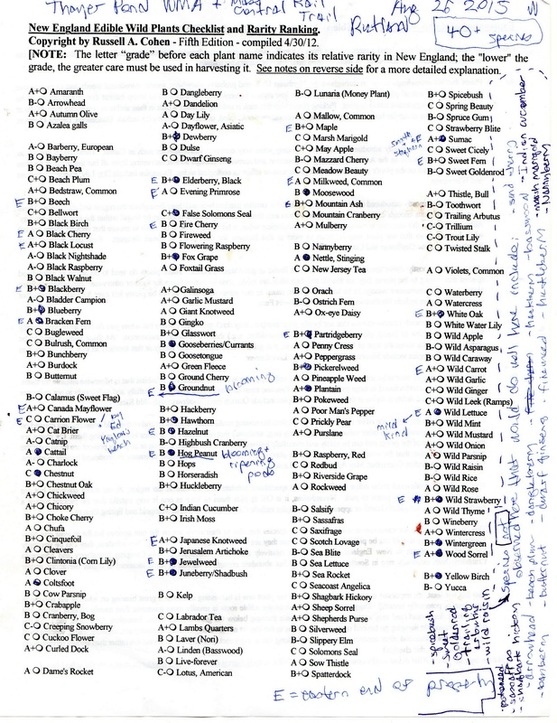
Worcester County is home to over 90 species of edible wild plants--many of which are more nutritious and flavorful than their cultivated counterparts--and dozens of species of edible wild mushrooms. We joined expert forager Russ Cohen, author of Wild Plants I Have Known…and Eaten, for an outdoor ramble to learn about 29 species of edible wild plants. A few edible mushroom species were encountered as well. Keys to the identification of each species were provided, along with info on edible portion(s), season(s) of availability and preparation methods, as well as general guidelines for safe and environmentally-responsible foraging.
After the group foray, Russ explored further east on the Rail Trail and located 13 additional edible species, for a grand total of 42.
Attached is a copy of the inventory sheet for the day. Species found during the field trip are marked with a blackened circle; species
observed by Russ on the eastern portion of the property are marked with an "E."
View more information about Russ and his programs HERE.
~~~~~~~~~~~~~~~~~~~~~~~~~~~~~~~~~~~~~~~~~~~~~~~~~~~~~~~~~~~~~~~~~~~~~~~~~~~~~~~~~~~~~~~~~~~~~~~~~~~~~~~~~~~~~~~~~~~~~~~~~~~~~~~~~~~~~~~~~~~
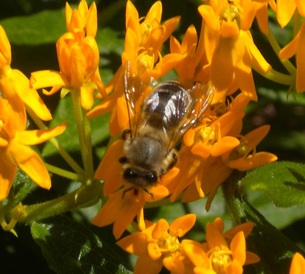
GOOD REASONS FOR USING NATIVE PLANTS
AND FLOWERS IN YOUR LANDSCAPE
with Brian Klassanos & other Club members
Wednesday June 24th 6:30 p.m. – 8:15 p.m.
Willow Farm, 25 Hardwick Pond Road, Ware
This was our final monthly program for the season. Considering the time of year, we thought that an outdoor walk around Brian’s unique and interesting property would be more fun than an indoor talk. Brian has been actively managing his land for ecological biodiversity and native habitat enhancement for many years, and it really pays off! He has recorded 72 species of butterflies here and attracts countless species of moths and other insects. This in turn supplies plenty of food for the birds that nest here. We talked about the different needs of some native plants that are being grown by Brian, such as our only native lupine, Sundial Lupine (Lupinus perennis), which is rare in New England. Brian has collected the seeds locally and established a special habitat for the lupine, as well as Bird-foot Violet (Viola pedata) and Yellow Wild Indigo ( Baptisia tinctoria ). We also talked about management of invasives and identified several common native plants that are allowed to flourish here. The Massachusetts Butterfly Club will be offering several field trips to Willow Farm this year.
`````````````````````````````````````````````````````````````````````````````````````````````````````````````````````````````````````````````````````````````````````````````````````````````````````````````````````````````````````````````
AND FLOWERS IN YOUR LANDSCAPE
with Brian Klassanos & other Club members
Wednesday June 24th 6:30 p.m. – 8:15 p.m.
Willow Farm, 25 Hardwick Pond Road, Ware
This was our final monthly program for the season. Considering the time of year, we thought that an outdoor walk around Brian’s unique and interesting property would be more fun than an indoor talk. Brian has been actively managing his land for ecological biodiversity and native habitat enhancement for many years, and it really pays off! He has recorded 72 species of butterflies here and attracts countless species of moths and other insects. This in turn supplies plenty of food for the birds that nest here. We talked about the different needs of some native plants that are being grown by Brian, such as our only native lupine, Sundial Lupine (Lupinus perennis), which is rare in New England. Brian has collected the seeds locally and established a special habitat for the lupine, as well as Bird-foot Violet (Viola pedata) and Yellow Wild Indigo ( Baptisia tinctoria ). We also talked about management of invasives and identified several common native plants that are allowed to flourish here. The Massachusetts Butterfly Club will be offering several field trips to Willow Farm this year.
`````````````````````````````````````````````````````````````````````````````````````````````````````````````````````````````````````````````````````````````````````````````````````````````````````````````````````````````````````````````
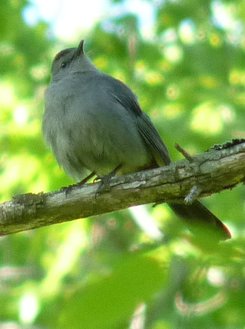 Gray Catbird. Photo by Alan Rawle. Gray Catbird. Photo by Alan Rawle.
ACCESSIBLE BIRDING ALONG THE CENTRAL MASS RAIL TRAIL, RUTLAND Saturday May 23, 2015 7:30 -11:30 a.m. Leaders: Wendy Howes & Ted Purcell Our accessible birding and nature walk/roll/stroll was along a stretch of the Rail Trail between Glenwood Road and the Route 56 underpass. Migration was still underway, so we found some birds en route to northern breeding grounds as well as many species already on territory. There is plenty of bird song at this time of year, so it was a good time to brush up on listening skills. Birds were be the focus, but of course we looked at other animals and plants of interest along the way. Highlights were Yellow-throated Vireos that provided good looks, several Veerys, singing Northern Waterthrushes, and flashy Baltimore Orioles and Scarlet Tanagers. |
~~~~~~~~~~~~~~~~~~~~~~~~~~~~~~~~~~~~~~~~~~~~~~~~~~~~~~~~~~~~~~~~~~~~~~~~~~~~~~~~~~~~~~~~~~~~~~~~~~~~~~~~~~~~~~~~~~~~~~~~
|
CONSERVATION OF CLIFF SWALLOWS AND BARN SWALLOWS IN MASSACHUSETTS by Mara Silver Tuesday, May 19, 2015 7 p.m. Davis Memorial Center, Petersham (in back of the First Congregational Parish, Unitarian) Cliff Swallows have been slowly declining in Massachusetts for decades, and Barn Swallows are also now known to be declining in population. Using relatively simply techniques, Mara Silver has successfully attracted both species and encouraged their nesting success at several sites in the state. Mara's presentation included her recent, and successful, efforts to attract Cliff Swallows to a previously-unused site in Shelburne and to enhance the Barn Swallow population there. Spring is around the corner--get ready for those swallows--they will be here before you know it! REPORT CLIFF SWALLOW SIGHTINGS HERE For a 2016 update, see ANNOUNCEMENTS |
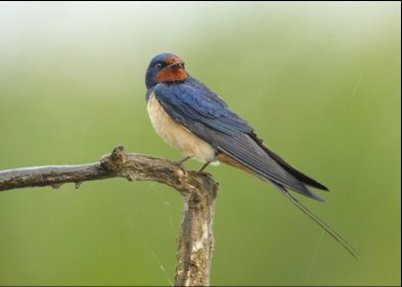 Barn Swallow Barn Swallow
Mara
Silver studied the same colony of Cliff Swallows in
Williamsburg, MA for 20 years. She recently transferred her
efforts to another site. She holds a Masters Degree in Wildlife and
Fisheries Conservation from U-Mass Amherst. For her Masters Thesis
project she inventoried Bank Swallow habitat along the
Connecticut River in MA. Mara works as a production editor at a
scientific textbook company.
|
/////////////////////////////////////////////////////////////////////////////////////////////////////////////////////////////////////////////////////////////////////////////////////////////////////////////////////////
|
WILDFLOWERS & BIRDS ON THE HIGH MEADOW TRAIL, WACHUSETT MOUNTAIN
Saturday May 16, 2015 11 a.m.-3 p.m. Leaders: Joe Choiniere & Wendy Howes On this hike we found many early ephemeral wildflowers, some of them unique to this locale, and heard and saw many returning neo-tropical migrants, including Scarlet Tanager, Veery, American Redstarts (many), and Magnolia Warbler. While hiking up to the High Meadow Trail we encountered an Ovenbird that was trying to distract us so we wouldn't see her nest. Plants unique to this spot include Dutchman's-breeches (Dicentra cucullaria)--past bloom time--yellow forest violet (Viola pubescens), and a species of fragile fern (Cystoptris sp.). See FROM THE FIELD for photos. ++++++++++++++++++++++++++++++++++++++++++++++++++++++++++++++++++++++++++++++++++++++++++++++++++++++++++++++++++++ |
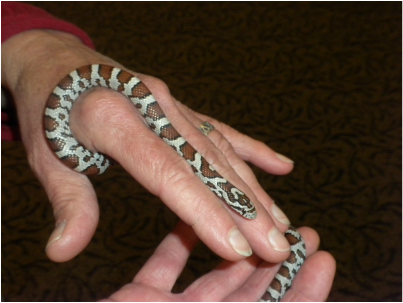 Milk snakes are docile and easy to handle, as well as beautiful. Their scale patterns are especially bright after they have shed their old skin.
Milk snakes are docile and easy to handle, as well as beautiful. Their scale patterns are especially bright after they have shed their old skin.
========================================================================================================================
MONTHLY PROGRAM
THE BIG HERP YEAR
by
Bill Benner & Joe Wicinski
Tuesday April 28, 2015 Rutland Public Library
Big Days and Big Years have become popular birding activities, involving a concerted effort to see as many species as possible in a certain time period, and usually within specific boundaries. As far as presenters Bill and Joe know, no one had ever done a Big Herp Year in Massachusetts. Bill provided a fascinating account of their 2013 Big Herp year, with photos and stories of searching for amphibians and reptiles from the Berkshires to Cape Cod. They brought along a guest, Mabelline the Milk Snake, which they use for educational presentations.
Bill Benner is a practicing veterinarian who also holds a Master’s Degree in Ecology and Evolutionary Biology from Cornell University, where he studied the molecular biology of House Finches. He is an active member of the Hampshire Bird Club, past-president of the Massachusetts Butterfly Club, and is current editor of the MBC’s Massachusetts Butterflies. In his spare time he raises silk moths, gardens for hummingbirds and butterflies, and helps out with local research projects on endangered Timber Rattlesnakes and Eastern Spadefoot Toads.
Joe Wicinski is also a practicing veterinarian who received his education at New York State College of Veterinary Medicine at Cornell University. While away from his office where he works with small animals and their owners, Joe gardens, hikes, and is an avid bird and butterfly watcher.
```````````````````````````````````````````````````````````````````````````````````````````````````````````````````````````````````````````````````````````````````````````````````````````````
MONTHLY PROGRAM
THE BIG HERP YEAR
by
Bill Benner & Joe Wicinski
Tuesday April 28, 2015 Rutland Public Library
Big Days and Big Years have become popular birding activities, involving a concerted effort to see as many species as possible in a certain time period, and usually within specific boundaries. As far as presenters Bill and Joe know, no one had ever done a Big Herp Year in Massachusetts. Bill provided a fascinating account of their 2013 Big Herp year, with photos and stories of searching for amphibians and reptiles from the Berkshires to Cape Cod. They brought along a guest, Mabelline the Milk Snake, which they use for educational presentations.
Bill Benner is a practicing veterinarian who also holds a Master’s Degree in Ecology and Evolutionary Biology from Cornell University, where he studied the molecular biology of House Finches. He is an active member of the Hampshire Bird Club, past-president of the Massachusetts Butterfly Club, and is current editor of the MBC’s Massachusetts Butterflies. In his spare time he raises silk moths, gardens for hummingbirds and butterflies, and helps out with local research projects on endangered Timber Rattlesnakes and Eastern Spadefoot Toads.
Joe Wicinski is also a practicing veterinarian who received his education at New York State College of Veterinary Medicine at Cornell University. While away from his office where he works with small animals and their owners, Joe gardens, hikes, and is an avid bird and butterfly watcher.
```````````````````````````````````````````````````````````````````````````````````````````````````````````````````````````````````````````````````````````````````````````````````````````````
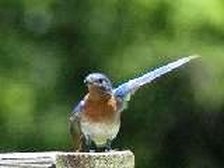
BUILDING BLUEBIRD, SWALLOW, and KESTREL BOXES
RUTLAND PUBLIC LIBRARY
Saturday April 25, 2015 1-5 p.m.
Our workshop was a great success! We assembled 22 bluebird/swallow nestboxes (which are also used by chickadees and House Wrens) and two kestrel boxes to be deployed in suitable habitat in our region. Thank you to Tanner Purcell who transported boards and Joe Choiniere of MassAudubon for pre-cutting the kits. Many thanks also to team members Travis B, Travis F., Noah H., and Gio A. for their cheerful help. Noah is an excellent craftsman! Club Member Anthony Costello brought along his tools and expertise and tackled the entry-hole drilling. Much appreciated was the guidance and supervision of Club members Anthony Costello, Ted Purcell, Wendy Howes, and Alan Rawle.
Photo by Wendell Long, North American Bluebird Society
The kestrel boxes will be erected locally by state ornithologist Drew Vitz. The bluebird boxes are for sale, $10 members/$12 non-members.
***********************************************
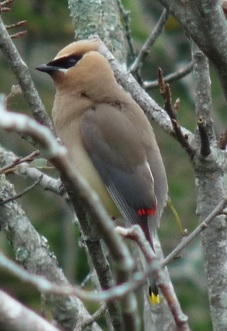 Cedar Waxwing
Cedar Waxwing
~~~~~~~~~~~~~~~~~~~~~~~~~~~~~~~~~~~~~~~~~~~~~~~~~~~~~~~~~~~~~~~~~~~~~~~~~~~~~~~~~~~~~~~~~~~~~~~~~~~~~~~~~~~~~
BIRDING ALONG THE BLUEBIRD TRAIL
HIGH RIDGE WILDLIFE MANAGEMENT AREA,
WESTMINSTER/GARDNER
Saturday April 18, 2015 9:30 a.m. - 12:30 p.m.
We combined an early spring birding walk with observations of the bluebird nestbox trail established here. We made notes about the conditions and locations of the nestboxes and supporting posts so that we can target our efforts to help maintain this trail. As soon as we cleaned out some of the boxes, a pair of Eastern Bluebirds claimed one of them! Many pairs of Tree swallows were out prospecting and claiming nestboxes, too. Other early spring migrants encountered included Pine Warbler, Palm Warbler, and Belted Kingfisher, and a Louisiana Waterthrush was heard by another birder.
^^^^^^^^^^^^^^^^^^^^^^^^^^^^^^^^^^^^^^^^^^^^^^^^^^^^^^^^^^^^^^^^^^^^^^^^^^^^^^^^^^^^^^^^^^^^^^^^^^^^^^^^^^^^^^^^^^^^^^^^
BIRDING ALONG THE BLUEBIRD TRAIL
HIGH RIDGE WILDLIFE MANAGEMENT AREA,
WESTMINSTER/GARDNER
Saturday April 18, 2015 9:30 a.m. - 12:30 p.m.
We combined an early spring birding walk with observations of the bluebird nestbox trail established here. We made notes about the conditions and locations of the nestboxes and supporting posts so that we can target our efforts to help maintain this trail. As soon as we cleaned out some of the boxes, a pair of Eastern Bluebirds claimed one of them! Many pairs of Tree swallows were out prospecting and claiming nestboxes, too. Other early spring migrants encountered included Pine Warbler, Palm Warbler, and Belted Kingfisher, and a Louisiana Waterthrush was heard by another birder.
^^^^^^^^^^^^^^^^^^^^^^^^^^^^^^^^^^^^^^^^^^^^^^^^^^^^^^^^^^^^^^^^^^^^^^^^^^^^^^^^^^^^^^^^^^^^^^^^^^^^^^^^^^^^^^^^^^^^^^^^
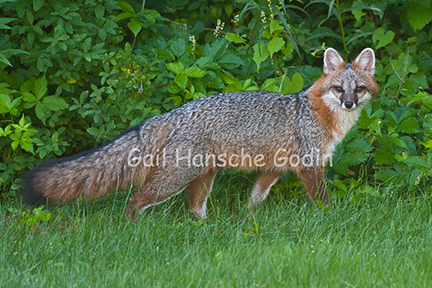
FUR AND FEATHERS
by Gail Hansche Godin Wednesday March 25, 2015 Rutland Public Library ~~~~~~~~~~~~~~~~~~~~~~~~~~~~~~~~~~~~~~~~~~~~~~~~~~~~~~~~~~~~~~~~~~~~~~~~~~~~~~~~~~~~~~~~~~~~~~~~~~~~~~ |
With this presentation, Gail helped us explore the fascinating world of wildlife behavior. Mammals and birds have evolved to survive by taking advantage of various habitats and food sources. This program examined the interesting behavior differences in adaptation between mammals and birds. We enjoyed images of black bear, deer, moose, otter, raccoon and fox as well as a variety of bird species. There were many beautiful images accompanied by music and a lively narration. Gail Hansche Godin MNEC is an award-winning nature photographer with a special passion for birds. A life-long naturalist, Gail’s passion is taking portraits of wildlife. She has been published in Massachusetts Wildlife magazine, National Wildlife magazine, The Nature Conservancy publications, and MASS Audubon Connections. Gail has won numerous awards in international photography competitions. She presents multi-media programs to a variety of audiences across New England. |
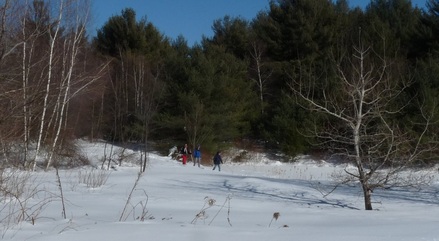
TREES IN WINTER SATURDAY, FEBRUARY 28, 2015 MassAudubon's Lake Wampanoag Sanctuary Gardner ~~~~~~~~~~~~~~~~~~~~~~~~~~~~~~~~~~~~~~~~~~~~~~~~~~~~~~~~~~~~~~~~ 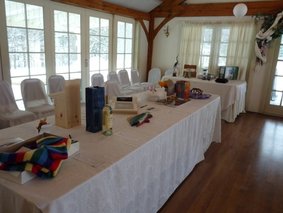
THANK YOU TO EVERYONE WHO DONATED ITEMS FOR THE AUCTION!
ROSE32 Bakery & Cafe Petersham Country Store Hardwick Farmers Coop Jean Rawle Gardner Agway Ted Purcell Wendy Howes Jim Samdahl Sylvia Howes Harrison Achilles Alan Rawle Barry Van Dusen Otto Florist & Gifts ^^^^^^^^^^^^^^^^^^^^^^^^^^^^^^^^^^^^^^^^^^^^^^^^^^^^^^^^^^ TRACKING THE HIDDEN WILDLIFE OF OUR WINTER WOODLANDS by DAVID BROWN Thursday January 29, 2015 Pinecrest Lodge Hubbardston Most wild animals hide from us, living their lives in secret behind foliage and in the night. However, they leave evidence of their presence behind in the form of tracks, trails, and other sign. A covering of snow reveals the abundance of life all around us in the winter woods. This was part one of a two-part indoor-outdoor program and acquainted participants with the process of finding, identifying, and interpreting wildlife sign. A slide presentation and casts of animal evidence were the jumping-off points for discussion, with emphasis on distinguishing what made those tracks we see in the snow. Tracker-naturalist David Brown has been finding and interpreting sign of New England wildlife for nearly three decades. He is the author of Trackards for North American Mammals and The Companion Guide to Trackards. This program was supported in part by a grant from the Hubbardston Cultural Council, a local agency which is supported by the Massachusetts Cultural Council, a state agency. |
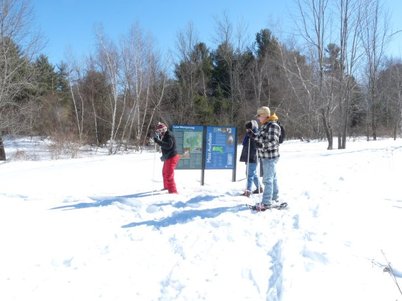
In the winter landscape, shapes, twig patterns, and textures of trees provide clues to their identity. Evergreens stand out and provide color and contrast to the mostly-bare branches of their deciduous comrades. This is the time of year when we can concentrate on some of the finer identification features of our native trees without the "distraction" of leaves and fruits. And yes, it's more challenging. Lake Wampanoag is an interesting site for tree exploration because it is a low-elevation site that holds balsam fir and red spruce, two species more typically encountered on higher ground. ~~~~~~~~~~~~~~~~~~~~~~~~~~~~~~~~~~~~~~~~~~~~~~~~~~~~~~~~~~~~~~~~~~~~ HAPPY BIRTHDAY TO US! Thank you to all who joined us for our February 8, 2015 celebration of our first year of sharing the joys of nature in central Massachusetts! In the warm and cozy setting of Hartman's Herb Farm in Barre, members and supporters hailing from all all corners of Worcester County enjoyed a brief respite from the snowy weather, sharing wonderful food and lively conversation. The silent auction fundraiser was a fine success; over $400 was raised, and this will go a long way toward helping fund speaker fees and administrative costs. The highlight of the afternoon came with two outstanding educational presentations. State Ornithologist Drew Vitz described several "citizen science" opportunities for helping with declining local bird species as well as a bluebird trail in need of revitalization. Keep an eye on our Conservation Projects page for more information. Dr. Thomas French, Director of MassWildlife's Natural Heritage & Endangered Species Program, presented an excellent, detailed talk about the tragic decline of Massachusetts' native bat species, research findings and observations, and small signs of hope that some bats may be making a slow comeback. Some important take-home messages:
^^^^^^^^^^^^^^^^^^^^^^^^^^^^^^^^^^^^^^^^^^^^^^^^^^^^^^^^^ |
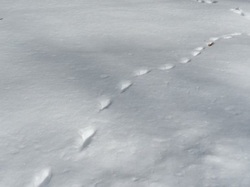
TRACKING THE HIDDEN WILDLIFE OF OUR WINTER WOODLANDS PART II
with
DAVID BROWN
Saturday January 31, 2015
Ware River Watershed/Barre Falls Dam area
Part two of our tracking program was the outdoor portion of the program. What made those tracks in the snow? See From the Field for a report of this outing.
with
DAVID BROWN
Saturday January 31, 2015
Ware River Watershed/Barre Falls Dam area
Part two of our tracking program was the outdoor portion of the program. What made those tracks in the snow? See From the Field for a report of this outing.
